FEDERAL COURT OF AUSTRALIA
Koninklijke Douwe Egberts BV v Cantarella Bros Pty Ltd [2024] FCA 1277
ORDERS
First Applicant JACOBS DOUWE EGBERTS AU PTY LTD (ACN 051 278 409) Second Applicant | ||
AND: | CANTARELLA BROS PTY LTD (ACN 000 095 607) Respondent | |
DATE OF ORDER: |
THE COURT ORDERS THAT:
1. The applicants’ claims be dismissed.
2. The cross-claimant’s claims for relief specified in paragraphs 1 to 7 of its amended notice of cross-claim be dismissed.
3. The question of the parties’ costs of the claim and the cross-claim be reserved until after the hearing and determination of the cross-claimant’s claims for damages and additional damages pursuant to s 129 of the Trade Marks Act 1995 (Cth).
4. Pursuant to ss 37AF and 37AG(1)(a) of the Federal Court of Australia Act 1976 (Cth), until further order, access to and disclosure (by publication or otherwise) of Confidential Annexure A to the reasons of the Court delivered on 7 November 2024, comprising paragraphs [564]–[603], be restricted to the persons identified below –
(a) the respondent;
(b) the legal representatives of the respondent; and
(c) those persons to whom access is allowed
(i) under the terms of the confidentiality regime agreed between the parties relating to information claimed to be confidential by the respondent; or
(ii) by express written permission from the respondent.
5. If any party wishes to apply for a further non-publication order under s 37AF of the Federal Court of Australia Act in relation to any part of the balance of the reasons for judgment, then that party may do so by emailing the Chambers of the Hon Justice Wheelahan by 12 noon on 8 November 2024 identifying with precision the part or parts of the reasons in respect of which a non-publication order is sought.
6. Upon receipt of any application in accordance with order 5 above, the Court will consider making an interim order in Chambers under s 37AI of the Act.
7. The hearing of any application for a further non-publication order is fixed for 15 November 2024 at 9.30 am.
8. By 4.00 pm on 14 November 2024, the legal practitioners for the parties are to confer in relation to procedural orders for the hearing and determination of the cross-claimant’s claims for damages and the hearing of any further applications for non-publication orders, including the final determination of applications that are the subject of existing interim orders.
9. The proceeding is listed for further case management on 15 November 2024 at 9.30 am.
10. Any proposed consent orders are to be emailed to the Chambers of the Hon Justice Wheelahan by 4.00 pm 14 November 2024.
Note: Entry of orders is dealt with in Rule 39.32 of the Federal Court Rules 2011.
WHEELAHAN J:
1 This case concerns the shape of a glass jar in which the respondent, Cantarella Bros Pty Ltd (Cantarella), has marketed and sold freeze-dried instant coffee under its “Vittoria” brand. The applicants are associated with a brand of freeze-dried instant coffee, styled “MOCCONA”. The applicants claim that by the use of its glass jar Cantarella has infringed a registered trade mark, engaged in misleading and deceptive conduct, and committed the tort of passing off. Cantarella denies these claims and has cross-claimed seeking orders that the registered trade mark be cancelled and that the Register be rectified accordingly.
Background
Overview of the claims
2 The first applicant, Koninklijke Douwe Egberts BV (KDE), is the registered owner of Australian Trade Mark Registration No 1599824 (KDE shape mark), which is a mark constituted by the shape of a container. The applicants claim that the second applicant, Jacobs Douwe Egberts AU Pty Ltd (JDE AU) is an authorised user of the KDE shape mark in Australia, although this is contentious, and is one of the questions in this proceeding that require resolution.
3 JDE AU sells coffee — predominantly instant coffee — which is available for purchase from retailers throughout Australia under the Moccona name. Moccona-branded coffee products are sold in jars, capsules, soft packs, sticks, sachets, and tins. Below is an example of a Moccona-branded instant coffee product, namely a jar of “Moccona Classic Medium Roast” –

4 The following graphical representation of the KDE shape mark is entered on the Register –

5 The image description entered on the Register for the graphical representation is “CONTAINER, 5 VIEWS”. The Register also records that the kind of mark in question is a shape. KDE obtained registration of its shape mark with effect from 7 January 2014 in relation to “Class 30: Coffee; instant coffee”, with the following endorsements –
Evidence provided under subsection 41(3).
Shape - The trade mark consists of the three-dimensional shape of a container as shown in the representations attached to the application form.
6 The dimensions of the KDE shape mark form no part of the registered mark. Nor does colour or material. For those reasons, while some of the evidence and submissions in this proceeding concerned 400-gram products contained in transparent glass jars with plastic stoppers bearing labels with gold detailing, it is important to appreciate from the outset that the KDE shape mark comprises only the “three-dimensional shape of a container as shown in the representations” entered on the Register.
7 Cantarella also sells coffee products which are available for purchase in retail stores throughout Australia. One of Cantarella’s major brands is Vittoria. As at May 2023, Vittoria was the highest-selling brand by value in Australia in the bean and ground coffee market, which was recognised in the evidence as being a different market from the instant coffee market.
8 In May 2021, Cantarella launched a 100-gram freeze-dried instant coffee product under the Vittoria brand, in four flavour variants. After being sold initially in Woolworths stores, the Vittoria 100-gram product began to be stocked and sold also in Coles stores from around November 2021. The Vittoria 100-gram product has been sold in a cylindrical glass jar with a gold-coloured plastic lid. Below is an image of the “classic” variant in the 100-gram jar –

9 In August 2022, Cantarella launched a new freeze-dried instant coffee product under the Vittoria brand: a 400-gram product, sold in a cylindrical glass jar with a glass stopper lid. From launch, the Vittoria 400-gram product also came in four flavour variants. A representative image of the “Classic” flavour is below, noting that the applicants’ claims extend also to each of the other three variants about which there was evidence, namely “Italian”, “Mountain Grown”, and “Latte” –

10 By their originating application, the applicants seek relief against Cantarella on three main grounds –
(1) First, the applicants contend that Cantarella has, within the meaning of s 120 of the Trade Marks Act 1995 (Cth), infringed the registered KDE shape mark.
(2) Secondly, the applicants allege that Cantarella has contravened ss 18, 29, and 33 of the Australian Consumer Law (ACL), which is sch 2 to the Competition and Consumer Act 2010 (Cth).
(3) Thirdly, the applicants allege that Cantarella has, by various forms of conduct, passed off its coffee products as coffee products that emanate from, or are associated with, the applicants and their coffee products.
11 Cantarella denies that the applicants are entitled to relief. Further, by its cross-claim, Cantarella seeks the cancellation of the KDE shape mark under s 88 of the Trade Marks Act with effect from the priority date of 7 January 2014, on the grounds that –
(1) at that time, the shape mark was not inherently adapted to distinguish, or did not in fact distinguish, KDE’s goods from the goods of other traders, as required by s 41 of the Trade Marks Act;
(2) the Registrar of Trade Marks accepted the application for registration of the shape mark on the basis of evidence or representations that were false in material particulars, thereby engaging the ground of opposition in s 62(b) of the Act;
(3) the shape mark was entered on the Register as a result of false suggestion or misrepresentation, thereby engaging the ground of cancellation in s 88(2)(e) of the Act;
(4) the application for registration of the shape mark was made in bad faith, thereby engaging the ground of opposition in s 62A of the Act; and
(5) as at the priority date, KDE did not intend to use the shape mark in Australia as a trade mark, to authorise its use in Australia as a trade mark, or to assign the shape mark to a body corporate for use as a trade mark by that body corporate in Australia, thereby engaging the ground of opposition in s 59 of the Act.
12 Alternatively, by its cross-claim Cantarella seeks to have the Register amended pursuant to s 92 of the Act by the removal of the KDE shape mark, with effect from the priority date, on the grounds set out in ss 92(4)(a)–(b) of the Trade Marks Act. In brief terms, this claim was put at trial on the footing that the KDE shape mark should be removed from the Register because –
(1) KDE has not used the shape mark as a trade mark since the priority date;
(2) KDE had no bona fide intention as at the priority date to use the shape mark, to authorise its use, or to assign it for use as a trade mark in the relevant way, and because KDE has not used the shape mark, or not used it in good faith, at any time before the period of one month ending on 24 March 2023; and
(3) the shape mark remained registered for a continuous period of three years ending one month before 24 March 2023, and at no time during that period did KDE use the shape mark, or use the shape mark in good faith, as a trade mark, in Australia.
13 By its cross-claim, Cantarella also seeks a declaration pursuant to s 129(2)(a) of the Trade Marks Act that the applicants have made unjustified threats of trade mark infringement proceedings, together with claims for an injunction, damages, and additional damages in relation to those unjustified threats.
The parties
14 The corporate structure within which the applicants sit is fairly complex. Since some issues turn upon that corporate structure, it is necessary to be precise about the relationships between various entities within the structure.
15 The first applicant, KDE, was incorporated in the Netherlands in 1970. It remains incorporated there at the present day. KDE is an immediate, wholly owned subsidiary of JDE International BV, another company incorporated in the Netherlands.
16 JDE International BV is a wholly owned subsidiary of JDE Holdings BV, another company incorporated in the Netherlands. In turn, JDE Holdings BV is a wholly owned subsidiary of Jacobs Douwe Egberts BV, which is also incorporated in the Netherlands.
17 Jacobs Douwe Egberts BV is itself a wholly owned subsidiary of JDE Peet’s NV, a public limited liability company incorporated under the laws of the Netherlands, which is listed on the Euronext Amsterdam stock exchange. While roughly 55% of its share capital is owned by another company, JDE Peet’s NV may fairly be regarded as the parent company of a corporate group.
18 The second applicant, JDE AU, is a company incorporated in Australia. JDE AU is also owned by JDE International BV, via two interposed Australian companies, being DE Investments Australia Pty Ltd and DE Holdings Australia Pty Ltd. While one organisational chart showed the parent company of JDE AU as “DE Investments Pty Ltd”, I infer from other evidence that this should have read “DE Investments Australia Pty Ltd”. Accordingly, JDE AU also forms part of the corporate group that sits under JDE Peet’s NV.
19 There were two principal business divisions within that corporate group: the “Jacobs Douwe Egberts” business, and the “Peet’s Coffee” business. KDE and JDE AU are a part of the “Jacobs Douwe Egberts” business division. The origins of the Jacobs Douwe Egberts business can be traced back to 1753, when Egbert Douwes and Akke Thijsses opened a grocery store called, in English, “The White Ox” in Joure, in what is now the Kingdom of the Netherlands. That store sold various products, including coffee and tea. In the present day, the Jacobs Douwe Egberts business, and indeed the JDE Peet’s NV corporate group in general, carry on a “pure-play” coffee and tea business: that is, one that is focused primarily on sourcing, manufacturing, packaging, distributing, and selling coffee and tea products.
20 The respondent, Cantarella, was incorporated in Australia in 1951. The origins of its business lie in a business established in Australia in 1947 by brothers Orazio and Carmelo Cantarella. That business involved the importation into Australia of various European products, such as mineral water, parmesan cheese, preserved tomato products, wine, olive oil, and pasta. Since 1958, Cantarella has carried on a business distributing beans and ground coffee products under the trade mark “Vittoria” to delicatessens, cafes, and restaurants. In the early 1980s, Cantarella began supplying Vittoria coffee beans and ground coffee to supermarkets.
The evidence
21 Evidence in chief was given by affidavit, and most but not all of the documentary evidence, although organised in the court book, comprised annexures to the affidavit evidence. The lay witnesses whose affidavit evidence was read by the applicants were –
(a) Ross Norman Tillman, the “Head of Category Development and Shopper Insights” of JDE AU, who made three affidavits and was cross-examined;
(b) Louise Marie Smith, the “Director of Global Intellectual Property” of the JDE Peet’s group of companies, who addressed and was cross-examined on the group corporate structure and licensing arrangements between the applicants;
(c) Linda Margaret Armstrong, the Finance Director of JDE AU, who produced documents and was cross-examined on issues relating to the applicants’ claim that JDE AU was an authorised user of the KDE shape mark; and
(d) Georgia Rosemary Mae Christie, a lawyer employed by the applicants’ solicitors, who produced documents and who was not required for cross-examination.
22 Of the applicants’ witnesses who were cross-examined, only Mr Tillman’s evidence calls for any comment. Mr Tillman’s position with JDE AU placed him in a position of some expertise, as he demonstrated a high degree of familiarity and experience with the consumer coffee market in Australia. Mr Tillman was challenged in cross-examination in relation to a number of contentious opinions that he expressed. I formed the view that Mr Tillman was an honest witness, and no questions going to his credit arise. However, he was cautious about making concessions, and the evidence of his opinions on contentious issues concerning the claimed similarities and differences between the Moccona jars, the Vittoria jars, and other jars containing products such as scented candles, was coloured. This was demonstrated most clearly when Mr Tillman was taken to two jars containing scented candles with clear similarities to the Moccona jar, yet did not accept that they were similar. In relation to a third jar containing a lemongrass and ginger scented candle, Mr Tillman did not accept that it was different from the Moccona jar, or that it was similar to the Vittoria jar. These are opinions that I do not share. These are not criticisms of Mr Tillman, because he was not put forward as an independent witness, and his position with JDE AU precludes any conclusion that he came to his evidence with objectivity. Moreover, Mr Tillman’s opinions on these issues were never going to carry much weight, and it is evident that the forensic purpose of much of the cross-examination of Mr Tillman was to provoke responses to expose more completely some of the questions that the Court must decide for itself.
23 Otherwise, no issues of presentation or credit arise in relation to the lay witnesses of the applicants who were cross-examined. Both Ms Armstrong and Ms Smith answered questions in cross-examination clearly and directly.
24 The lay witnesses whose affidavit evidence was read by Cantarella were –
(a) Matthew William Hill, the Chief Operating Officer of Cantarella, who gave evidence about Cantarella’s business and its decision to use the impugned jar for its 400-gram instant coffee product, and who was cross-examined;
(b) Leigh Alfred Harrison, a director of Abel Lemon Trading Pty Ltd, who gave evidence about the importation and sale of “Park Avenue”-branded instant coffee in around 1993 in a jar similar to the KDE shape mark, and who was not required for cross-examination;
(c) Sue Maree Gilchrist, a partner with Cantarella’s solicitors, who produced documents and who was not required for cross-examination.
25 When cross-examined, Mr Hill gave evidence in a direct, straightforward manner. I formed a favourable view of his presentation as a witness and considered that he gave honest, reliable evidence to the Court. Mr Hill stood up well to cross-examination on disputed factual issues and readily made concessions.
26 Expert evidence was given in two areas of expertise: (a) marketing; and (b) industrial design. For each area of expertise, a joint report was prepared and the evidence of the experts was given concurrently. The marketing experts were –
(a) Richard Don O’Sullivan, Professor of Marketing at Melbourne Business School, who was engaged by the applicants; and
(b) Paul Lindsay Blanket, Founder and Principal of First Impressions Pty Ltd, a marketing and communications consulting firm, who was engaged by Cantarella.
27 The expert marketing evidence presented difficulties. The difficulties had several dimensions. The first is that there were opinions given by both Professor O’Sullivan and Mr Blanket which I do not find persuasive. The second is that there are questions as to whether the marketing evidence addressed the same issues that the Court must decide, and whether the marketing evidence veered off into collateral issues, such as branding, and “brand elements”. The third is that ultimately the key questions, such as use of a sign as a mark of origin, deceptive similarity, and misleading and deceptive conduct, are questions of fact for the Court itself to determine by reference to legal standards, which brings into question the utility of the expert marketing evidence. I will address the marketing evidence in more detail later after setting out more background facts.
28 The industrial design experts were –
(a) Andrew Charles Simpson, an industrial designer and principal of Vert Design Pty Ltd, who was engaged by the applicants; and
(b) David Fulton Francis, a director at D3 Design, a specialist packaging and product design consultancy, who was engaged by Cantarella.
29 Both Mr Simpson and Mr Francis were impressive witnesses and presented as being clearly independent. These impressions may have been strengthened by the fact that there were large areas of agreement between them in relation to the matters that were the subject of their experience and expertise.
Factual setting
30 In light of how the parties joined issue at trial, it is necessary for me to make some more particular findings about various aspects of the parties’ businesses and the coffee industry over time. To resolve some of the questions raised at trial, attention must be given to how Moccona and Vittoria-branded products have been produced, distributed, marketed, and sold over the years. Understandably, the evidence about how particular products were packaged and marketed decades ago was not always clear. Nevertheless, much of the evidence that went towards establishing several of the key events in this period was uncontradicted. I will therefore make factual findings in the paragraphs that follow on the basis of that evidence. Where necessary, I will set out any points of contention between the parties and make explicit the findings I make.
History of the Moccona brand in Australia
31 Moccona-branded instant coffee was launched in Australia in 1960. The word “Moccona” was registered as a trade mark in Australia in respect of “Coffee, inclusive of coffee in powder form” from 5 April 1960.
32 There was an issue at trial as to when Moccona-branded instant coffee began to be sold in a glass jar with a glass stopper lid, substantially in the form of the KDE shape mark. While the applicants’ original position was that Moccona instant coffee was sold in “its cylindrical glass jar with flat-topped stopper” from the very beginning in 1960, there was no evidence beyond some hearsay representations in the 2020 annual report for JDE Peet’s NV, and a statement on a web site, to support that position. Since Cantarella disputed this claim, it is necessary to step through the evidence on this question.
33 The starting point is an advertisement for Moccona instant coffee that appeared in the 7 December 1960 issue of “The Australian Women’s Weekly” –

34 This advertisement depicts a tin, rather than a jar, of Moccona instant coffee. The text of the advertisement states a price of “3/11½” in respect of “2oz. tins or jars”. From the advertisement as a whole, I find that Moccona instant coffee was marketed at the time of the advertisement in both tins and jars, although I cannot conclude that the jar used at that time was in any way similar to the KDE shape mark.
35 The following advertisement, from the 2 December 1966 issue of “Dutch-Australian Weekly”, was also in evidence –

36 This advertisement appears to show Moccona-branded coffee being offered for sale in Australia in a cylindrical glass jar not entirely unlike the body of the KDE shape mark. The jar, however, seems to have a screw-top lid, not a stopper lid. Since a stopper lid is an inherent element of the KDE shape mark, this advertisement would not support a finding that Moccona-branded instant coffee was sold in a jar resembling the KDE shape mark from 1966.
37 Also in evidence was a photograph, dated September 1972, which was said to depict a factory in Joure, the Netherlands, where Moccona instant coffee was then produced –

38 This photograph appears to depict a conveyor belt carrying coffee in unlabelled glass jars of a shape similar to the KDE shape mark. The evidence did not establish, however, that in 1972 the Joure factory produced coffee in only one container. Indeed, as will appear below, Moccona-branded instant coffee was sold in a variety of containers in the 1970s, suggesting that the Joure factory may have used more than one shape of container during this period. Given that no Moccona labels appear on the jars in the photograph, and that there is no other indication that any of the depicted jars was ever shipped to Australia, I cannot find based on this photograph alone that Moccona-branded instant coffee was sold in a jar similar to the KDE shape mark in Australia by 1972.
39 Also in evidence was a photograph sourced from the National Archives of Australia, which was taken in a supermarket in 1977 –

40 This photograph shows, amongst other things, various coffee products for sale on shelves, including Moccona-branded instant coffee in a cylindrical glass jar with a glass stopper lid, as well as Moccona-branded instant coffee in at least one other form of packaging, being a transparent cylindrical jar bearing a red label with a gold lid. The shape of the jars with the glass stopper lids in the photograph appears to resemble the KDE shape mark.
41 More specifically, an advertisement in the 12 October 1977 edition of “The Australian Women’s Weekly” depicts a Moccona-branded cylindrical glass jar with a glass stopper lid containing instant coffee –

42 On the basis of the last two photographs, I find that by October 1977 Moccona-branded instant coffee was sold in Australia in a jar with a shape that was substantially similar to the KDE shape mark. However, based upon my own examination of the photographs and the applicants’ current products, I cannot exclude the possibility that the 1977 jars may have had some slight differences in shape, particularly of the angle of the shoulders of the jars and the height of the glass stopper lid.
43 To support their claim that Moccona instant coffee was sold in a jar similar to the KDE shape mark from earlier than 1977, the applicants drew attention to the reasons for judgment of Lockhart J in Stuart Alexander & Co (Interstate) Pty Ltd v Blenders Pty Ltd (1981) 53 FLR 307 (Stuart Alexander). The Court received those reasons into evidence without objection, and the parties proceeded on the basis that the Court could rely on Lockhart J’s reasons as evidence of the truth of matters asserted in that judgment. No objection was taken under s 91 of the Evidence Act 1995 (Cth) or by reference to any corresponding common law principle.
44 The applicants relied upon Lockhart J’s reference at 308 to a jar which was, in October 1981, “substantially the same as the jar in which Moccona ha[d] been sold for at least fifteen years”. It is clear that the jar in question had substantially the same shape as the KDE shape mark. From this, the applicants asked the Court to infer that Moccona has been sold in a jar like the KDE shape mark since 1966. Cantarella submitted that the evidentiary basis for Lockhart J’s finding was not apparent, and that his Honour did not need, in that case, to address the precise date on which the Moccona jar was first used. I accept Cantarella’s submission. I also note that the advertisement in the 2 December 1966 edition of the “Dutch-Australian Weekly”, reproduced at [35] above, shows a Moccona jar with a screw-top lid. Unless there were two Moccona jars available for purchase in 1966 that differed only in terms of their lids, this advertisement is inconsistent with the statement in Lockhart J’s reasons of 8 October 1981 that the same jar had been used for “at least fifteen years”. The more fundamental point, however, is that I am unable to identify the evidentiary foundation for his Honour’s finding. I therefore attribute it little weight, and conclude that I am not affirmatively persuaded on the evidence before me that Moccona instant coffee was sold in Australia in a jar with a shape like that of the KDE shape mark before October 1977.
Advertisements for the Moccona brand in Australia
45 As this discussion shows, there is a long history of Moccona instant coffee advertisements in Australia. In what follows, I will describe a series of Moccona instant coffee advertisements, which were relied upon by the parties for various purposes. It was not in dispute that these advertisements had been published in Australia.
46 The applicants relied upon a campaign in 2008, centred around a television advertisement entitled “Cinderella”. The advertisement is obviously a play on the “Cinderella” fairy tale, in which a prince tries to find the woman whose foot fits a glass slipper. In the advertisement, a man is shown sitting on a wall next to a beach, holding a glass stopper lid that resembles the Moccona lid, as appears below –

47 The man goes from door to door with his glass stopper lid in hand. Each of the doors is opened by a woman who has a coffee jar, but no lid. The jars have a range of different shapes. The man and each woman test whether the lid fits the jar. At each door before the last one, the lid fails to fit the jar. At the final door, the woman’s jar is a Moccona Classic Medium Roast jar, with which the man’s lid fits perfectly. The advertisement features a close-up depiction of the Moccona jar and lid in the hands of the man and woman, as appears below –

48 The advertisement ends on the following frame, which shows a dramatically lit Moccona jar against a black background, above the gold cursive motto “Never settle for less than Special” and a gold URL for “www.moccona.com.au” –

49 The next advertisement relied upon by the applicants was entitled “Candles”. It was screened on free-to-air and pay television channels from at least 2010. This advertisement depicts a woman purchasing Moccona jars from a man behind the counter of a store. Behind the man, Moccona jars are stacked in a row, two jars high –
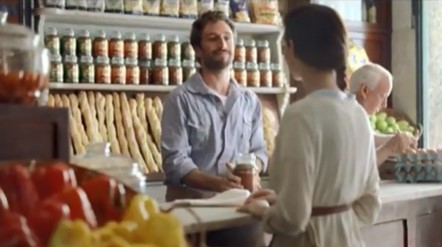
50 A close-up shot of the Moccona jar, with label, follows. The advertisement then depicts the woman purchasing more jars from the man on further occasions. The culmination of the advertisement comes when the man leaves the store at night to find that the woman has placed a candle in an empty Moccona jar (without its lid) on the setts of the street –
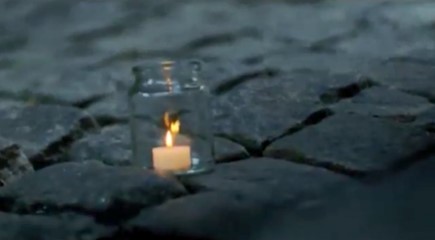
51 In fact, there are several of these Moccona jar candles, which lead in a line to the woman’s apartment building. The man follows the path they create and encounters the woman drinking something — presumably coffee — from a mug. At the bottom of the shot appears the Moccona logo, as part of the tagline “New Moccona Inspirations Range” –
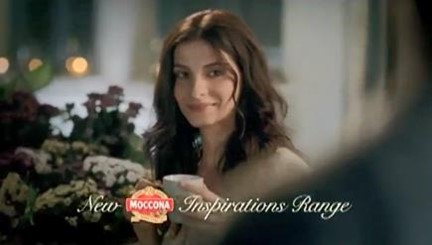
52 The next advertisement was titled “Keepsakes”. This advertisement was broadcast in 2011. Ancillary advertisements were published in other media as part of the same campaign. The “Keepsakes” advertisement opens with a series of shots depicting a woman’s romantic stay in a luxury hotel. Several shots prominently feature her room key and a tag emblazoned with the number “18”. In one such shot, the woman drops the key. The next shot in the advertisement depicts the key dropping into a glass Moccona jar –
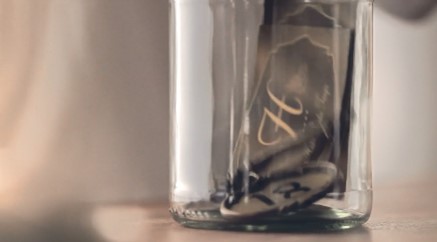
53 As this picture demonstrates, only the cylindrical body of the Moccona jar is visible. The woman is then shown drinking coffee and wistfully remembering her hotel stay. She places a glass stopper lid on the jar containing the key, and in this shot the entire Moccona jar with lid is visible in profile, without any label or the word “Moccona” –
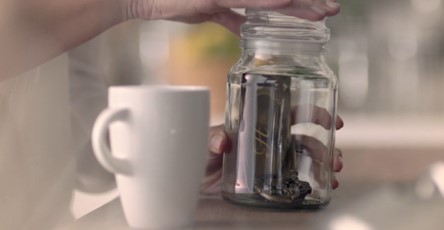
54 A glass jar containing coffee, with a Moccona label, is depicted on the woman’s kitchen bench in the same shot as the unlabelled jar. The unlabelled jar is then placed on a shelf alongside a series of other unlabelled glass jars containing keepsakes –
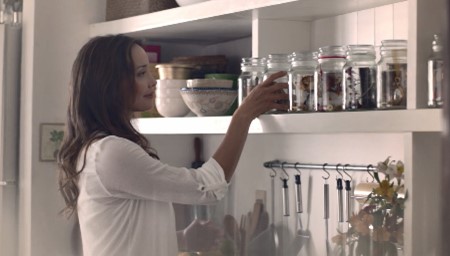
55 The final shot of the “Keepsakes” advertisement is a close-up of a labelled Moccona jar with the taglines “INDULGE IN THE MOMENT”, “Specialty Blends” and “For Lovers of Coffee” –
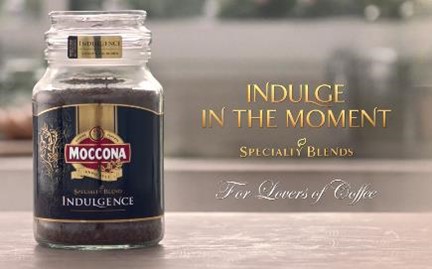
56 A subsequent version of the “Keepsakes” advertisement was broadcast in 2012. That version depicts the same woman placing a glass jar on a shelf with other jars that contain keepsakes. This time, however, the jars on the shelf have decorative patterns, though still no labels –
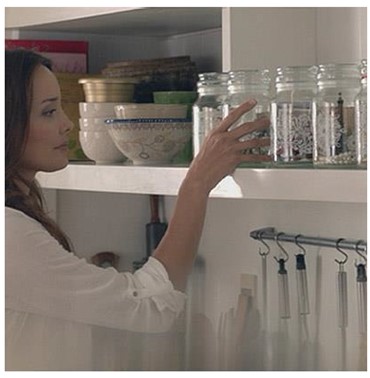
57 The advertisement ends on a shot of three limited-edition jars of Moccona, in “EXOTIC”, “INDULGENCE” and “RICH” flavour varieties, above the Moccona logo and the tagline “For Lovers of Coffee” –
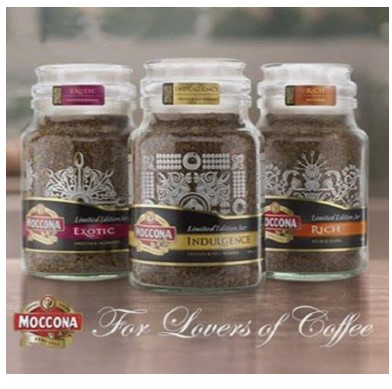
58 One video played during Mr Tillman’s cross-examination was titled “Moccona Me-Time Moments: Emma (60”)”. This video was downloaded from YouTube, having been posted on the Moccona YouTube page on 14 July 2021. The video, which had garnered more than 32,000 views, depicts the eponymous Emma engaging in various forms of community volunteering, as well as making and drinking a cup of Moccona instant coffee. This footage was accompanied by an audio voiceover of Emma describing her activities. A partially obscured Moccona-branded jar appears in the background of the video while Emma is cooking –
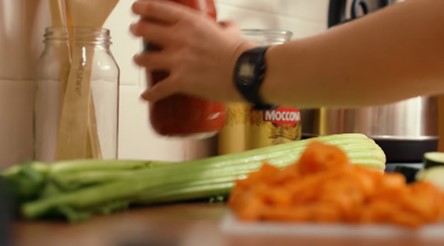
59 A partially obscured Moccona-branded jar, with a detached but visible lid, is also shown more prominently when Emma spoons out some instant coffee –
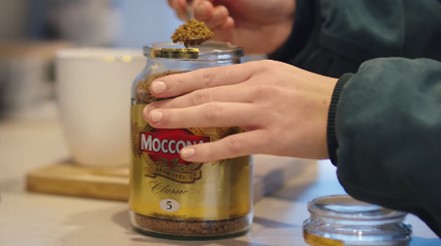
60 Also played during the cross-examination of Mr Tillman was a YouTube video titled “The Quest – Moccona (15”)”, which was posted on the Moccona YouTube channel on 1 March 2021 and which had recorded over 460,000 views. This video depicted a woman making a cup of Moccona instant coffee and choosing to drink her coffee rather than socialise with her friends. One image in the video shows the woman smelling an open jar of Moccona instant coffee, with the jar’s lid held in her right hand –

61 Another relevant image from the video is the final image of a mug and three Moccona-branded products, being a box of sachets, a jar of instant coffee, and a box of capsules. Each of these products bears the Moccona logo –
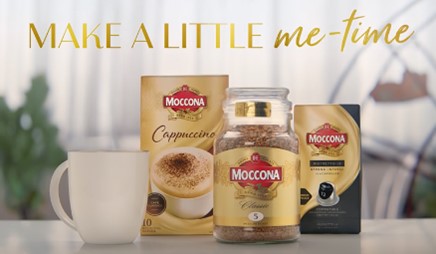
62 Another video played during the cross-examination of Mr Tillman was titled “Moccona Me-Time Moments: Katie (60”)”. This video was posted to the Moccona YouTube channel on 14 July 2021 and had recorded over 160,000 views. The video follows a similar format to the video featuring Emma, which I have already described. Relevantly, the video opens with an image of the Moccona logo and the tagline “Giving a little me-time to deserving Aussies” in front of a blurred image of Katie and her family –
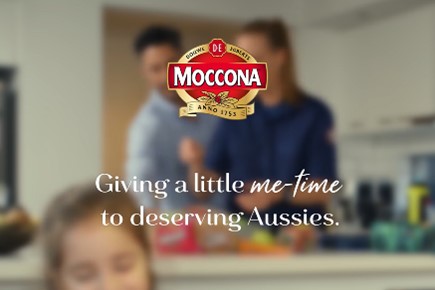
63 Later in the video, Katie’s husband is shown spooning instant coffee out of a Moccona-branded jar, which is partially obscured –
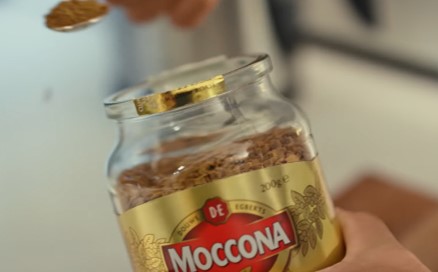
64 The video also contains images of Katie at a beach, drinking from a Moccona-branded cup –

65 The video’s concluding image is of a Moccona logo superimposed over Katie drinking from the same Moccona-branded cup –
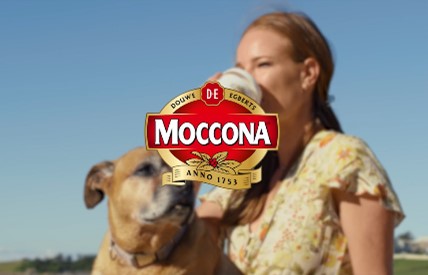
66 Counsel for Cantarella also played a video entitled “Dec Jar 2022”, which was posted to the Moccona YouTube channel on 8 July 2022 and has attracted over one million views. The evidence established that this video related to the “Be Inspired” range of limited-edition Moccona glass jars. A campaign involving these jars, which ran between at least June 2022 and December 2022, was run on several social media platforms. The video depicts a range of six limited-edition Moccona jars. Initially, the six jars are presented together above the Moccona logo –
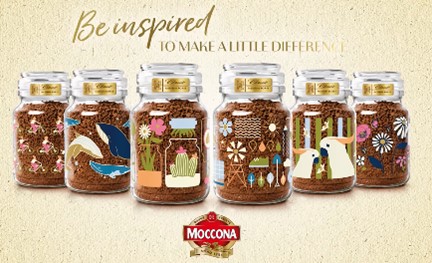
67 Each jar is also presented individually, as in the case of the following jar –
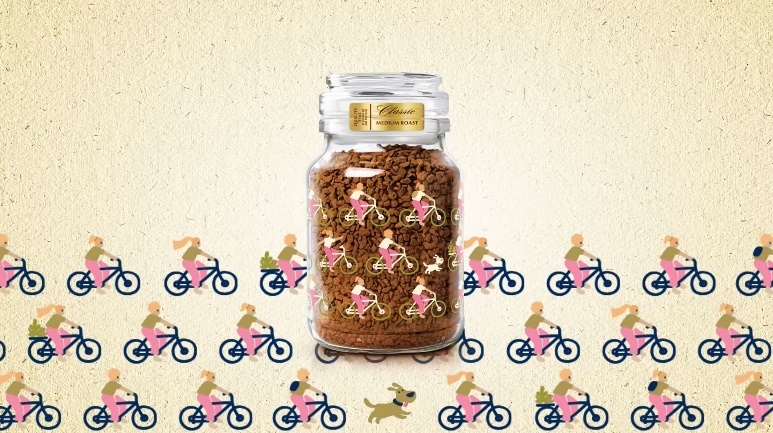
68 At the conclusion of the video, the six jars are again presented together above the Moccona logo –
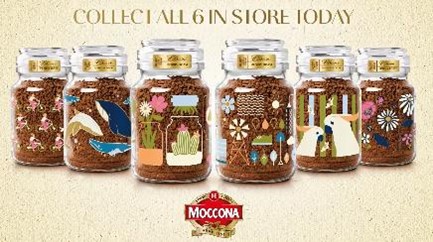
69 Throughout the video, each of the jars depicted is filled with freeze-dried instant coffee, and bears a decorative design. Nowhere in the video is a jar shown with a Moccona label affixed.
70 Another video played by counsel for Cantarella was titled “Moccona Sleeping Beauty”. This video was posted to the Moccona YouTube channel on 12 April 2014, and has been viewed more than 19,000 times. This video opens with various suitors attempting to wake a sleeping woman, using loud noises such as a cockerel, an accordion and a band. None of these methods succeeds. As these failed attempts unfold, there are brief images of a man with a jar of Moccona instant coffee –
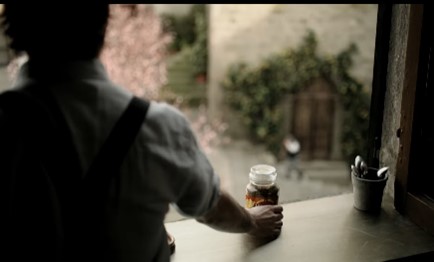
71 Eventually, the man is shown opening the Moccona jar and making a cup of coffee –
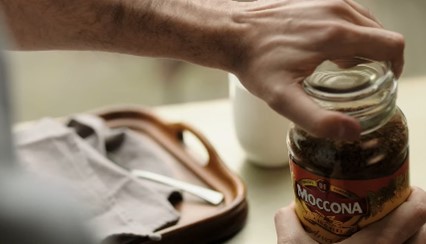
72 This causes the sleeping woman to stir, and she eventually awakes when the man brings the coffee to her chamber. The video ends on an image of a labelled jar of Moccona “Awaken” instant coffee, next to the taglines “WAKE UP TO SOMETHING SPECIAL” and “For Lovers of Coffee” –
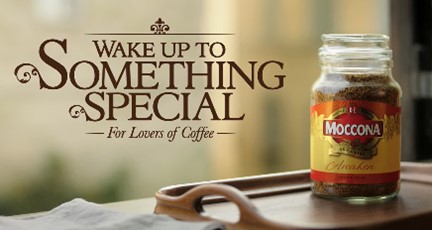
73 Another video shown by counsel for Cantarella was titled “Moccona Chase (15”)”, which was posted to the Moccona YouTube channel on 7 March 2018 and had more than 440,000 recorded views. This video shows a man running after a woman on a tram, with a labelled jar of Moccona instant coffee in hand –
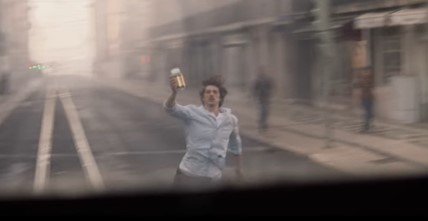
74 The video then shows the man reaching the woman inside a building and handing her the labelled jar of Moccona instant coffee –

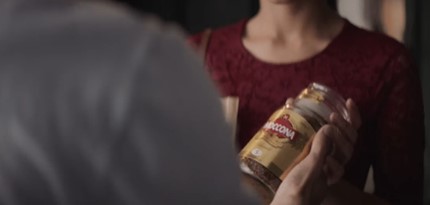
75 The video finishes on an image of a labelled Moccona jar next to the tagline “FOR LOVERS OF COFFEE” –
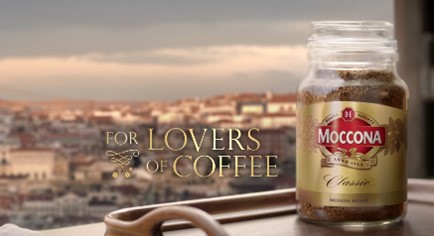
76 Another video shown by counsel for Cantarella was titled “Moccona by Peter Alexander”, which was posted on 23 March 2018 and has recorded over 500 views. This video forms part of a campaign run by JDE AU in collaboration with the Australian sleepwear company Peter Alexander. The campaign involved limited-edition “Wake Up In Style” glass jars, and ran between at least February 2018 and October 2018. Around 950,000 of these jars were sold during that period. The advertising campaign involved billboards, social media, and other online advertising, an event in Sydney at which Peter Alexander himself appeared, and various other forms of promotion. This particular video opens on a cascading shot of four decorative glass Moccona jars containing freeze-dried instant coffee. The word “Moccona” does not appear on the jars, or anywhere else in the opening sequence –
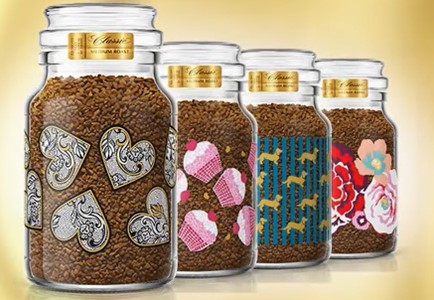
77 The video then finishes on an image of a decorative glass Moccona jar, without a label, next to the Moccona logo and the tagline “WAKE UP IN STYLE” –
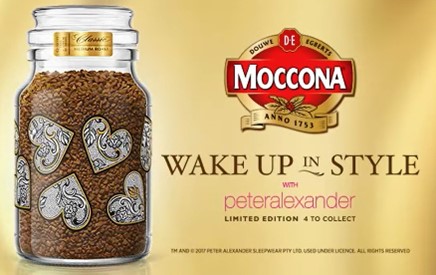
78 The next video played by counsel for Cantarella was titled “Fall in love with coffee at home with Moccona”. This video was posted to the Moccona YouTube channel on 13 May 2020, and had recorded more than 2,500 views. The video opens with a coffee bean turning into a love heart, before a jar of Moccona instant coffee, along with its label, is featured –
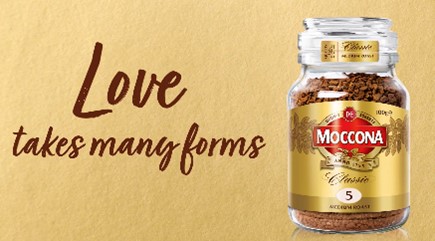
79 The video then features two other Moccona products, being a box of “Cappuccino” sachets, and a tin of “Barista Reserve” –
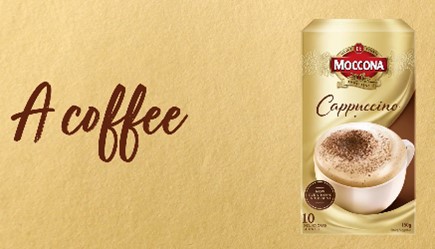
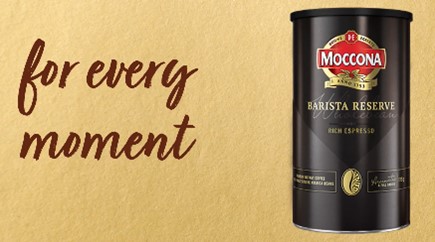
80 The video concludes with an image of four Moccona products, being a tin of “Barista Reserve”, a box of “Cappuccino” sachets, a 100-gram jar of Moccona Classic freeze-dried instant coffee, and a box of “Ristretto” capsules. The jar of Moccona instant coffee is placed at the front of the range –
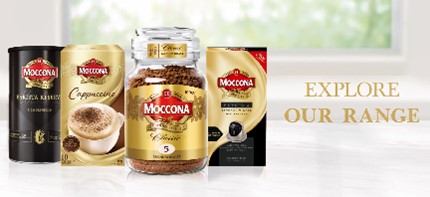
81 Counsel for Cantarella also played a video titled “Moccona Upcycling #InspiredByMoccona”, which was posted to the Moccona YouTube channel on 21 July 2020 and which had more than 1,500 recorded views. The video is an advertisement for Moccona that illustrates how, once the coffee inside has been used, Moccona jars can be used for purposes other than storing coffee. The video opens on an image of the Moccona logo above the tagline “Be inspired” –
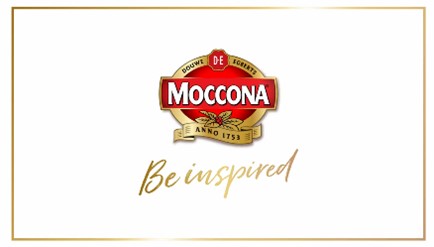
82 The video then shows some unlabelled Moccona jars before showing an image of a labelled jar of Moccona instant coffee –
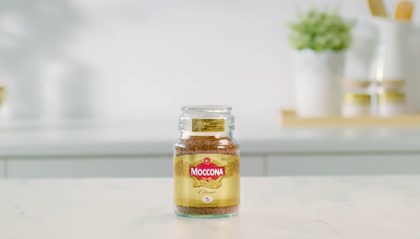
83 The next shot in the video shows, from above, coffee being spooned out of a jar of Moccona instant coffee, without its lid. The word “Moccona” does not appear in this shot, and it is not clear whether the jar has any label attached to it –
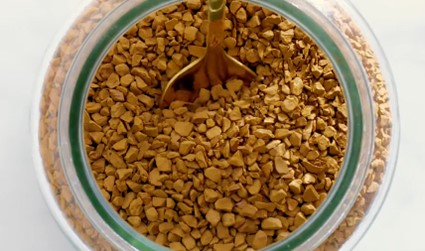
84 Following these images comes a series of images that illustrate the uses to which empty Moccona jars can be put. The jars are variously used as water vessels, candle holders, and vases. In each case, the body of the Moccona jar is visible, though the lid is not always present –
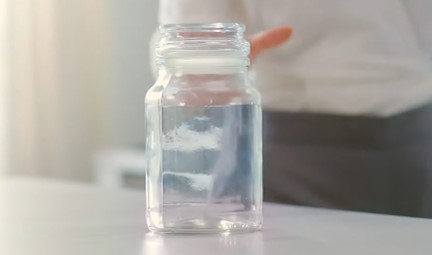

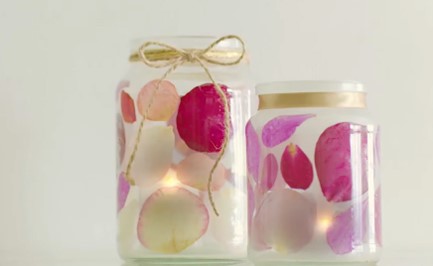


85 The next video played by counsel for Cantarella was titled “Inspire your moment with Moccona (15”)”, which was posted to the Moccona YouTube channel on 17 August 2020 and which had more than 2.4 million recorded views. This video centres on a woman painting a watercolour bird, which comes to life and imparts a design onto a plain and unlabelled jar of Moccona instant coffee. The video opens on a shot of a woman drinking coffee from a mug, with an unlabelled jar of Moccona instant coffee next to a small easel on the table in front of her –

86 In the next shot, the woman puts the finishing touches on the watercolour of a bird carrying a garland of flowers. The bird magically flies off the page and floats above the unlabelled Moccona jar –

87 The bird then flies around the jar and wreathes it with the garland of flowers, which is imparted on the jar as a decorative design –

88 In the final shot, the jar with the decorative design expands into six jars, each with its own design. The jars, which do not bear a Moccona label, are placed above a glinting Moccona logo and the tagline “INSPIRE YOUR moment” in the final frames –
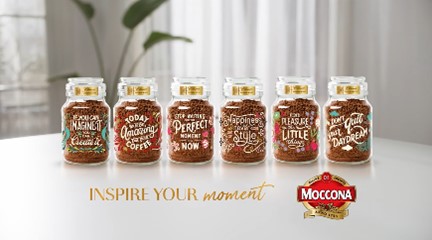
History of the Vittoria brand in Australia
89 As I have noted, Cantarella’s Vittoria business focused, for most of its existence, on beans and ground coffee. For at least some time between the late 1950s and the late 1970s, however, Cantarella also sold a Vittoria-branded instant coffee product, in a jar that appears below –
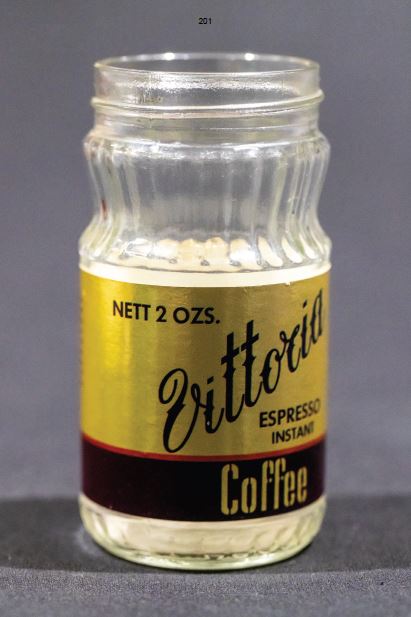
90 At other times, Cantarella has sold instant coffee products under different brands. There was no suggestion that any Vittoria-branded instant coffee product had been sold in Australia between the late 1970s until the launch of the Vittoria 100-gram instant coffee product in 2021.
91 The Vittoria 100-gram instant coffee product began to be sold by Woolworths in May 2021. As I have mentioned, the Vittoria 100-gram product has been sold in a tall, cylindrical glass jar with a gold-coloured plastic lid, with Vittoria branding involving the use of registered trade marks owned by Cantarella. The 100-gram product is available in four varieties –
(1) Original Classic, with a predominantly gold label;
(2) Mountain Grown, with a predominantly black label;
(3) Latte, with a predominantly white label; and
(4) Italian, with a predominantly brown label.
92 The evidence was that these four varieties mirror varieties of coffee beans and ground coffee sold under the Vittoria brand.
93 From around November 2021, Coles also began to stock the Vittoria 100-gram product. The Vittoria 100-gram product was initially priced at $10.00 per jar, and subsequently at $11.00 per jar. Since its launch, it has often been discounted and sold for prices between $6.00 and $7.60.
94 In July 2023, Cantarella launched a 300-gram, Vittoria-branded instant coffee product range that is sold in a resealable pouch. The evidence suggested that this product range is sold in independent supermarkets and grocers, rather than Coles and Woolworths stores. A stock image of an “Original Classic” variety resealable pouch of Vittoria instant coffee was in evidence –
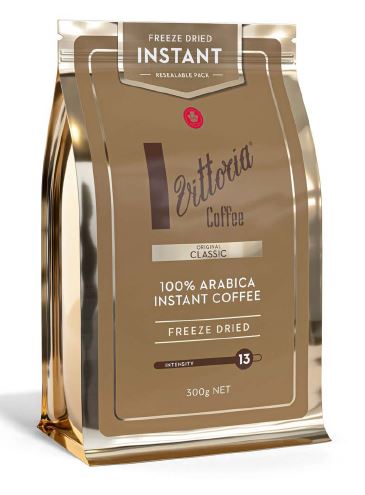
95 Also in evidence were photographs of “Original Classic” and “Mountain Grown” variety resealable pouches of Vittoria instant coffee, as they appeared on the shelves of independent supermarkets and grocers –
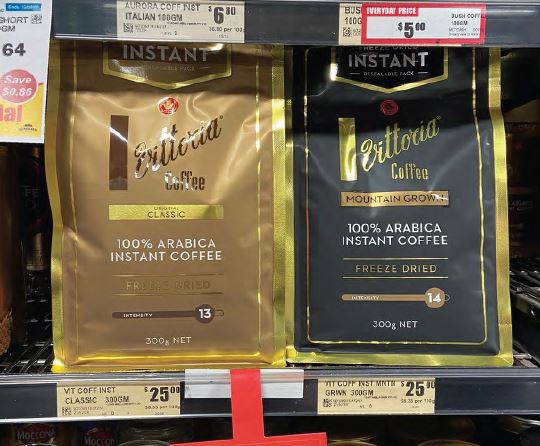
Development of the Vittoria 400-gram product
96 The parties adduced evidence relating to the development of the Vittoria instant coffee range, including the 400-gram product and its packaging. Much of the evidence was confidential, and was heard in closed court. In general terms, the evidence related to precisely how, why, and with what knowledge and motivation Cantarella settled on the packaging it ultimately adopted for the Vittoria 400-gram product. Because of its confidentiality, I will deal with aspects of the evidence concerning the development of the Vittoria instant coffee range in a confidential annexure to these reasons. I will, however, explain in these open reasons the outline of my reasoning in relation to this topic.
97 The evidence on this topic was said to be relevant to the applicants’ infringement case, and the misleading or deceptive conduct and passing off cases. Now, it is not an element of any of those causes of action that the respondent intended to deceive. It was common ground that, for example, deceptive similarity or a likelihood of misleading or deceiving can be established whether or not Cantarella intended to achieve those results. In their statement of claim, the applicants pleaded as part of their infringement case that the –
[r]espondent’s Infringing Shape Mark is deceptively similar to the [a]pplicants’ Shape Mark … in that a number of Australian consumers … are at a real risk … of being confused … particularly given that … there is no requirement to prove an actual subjective intention to cause confusion, but in any event … the [r]espondent chose to adopt packaging “sailing close to the wind” of the [a]pplicants’ Shape Get-Up …
98 Similar allegations were made in relation to the applicants’ ACL claim.
99 The evidence about the development of the Vittoria 400-gram product’s packaging has to be understood in this context. The applicants submitted that the process by which the packaging for the Vittoria 400-gram product was developed reinforced the conclusions that Cantarella had used the shape of the 400-gram product as a trade mark, and that the shape of the 400-gram product was likely to be confused by some notional consumers with the shape registered by the KDE shape mark. The applicants sought to engage the principle that, where a trader consciously emulates aspects of a competitor’s get-up, it is a reasonable inference that the trader believes there will be a market benefit in doing so, in the form of attracting custom that would otherwise have gone to the competitor. From those propositions, it was said, it is an available inference that the trader considered that such emulation was “fitted for the purpose and therefore likely to deceive or confuse”: see Australian Woollen Mills Ltd v F S Walton & Co Ltd (1937) 58 CLR 641 (Australian Woollen Mills) at 657 (Dixon and McTiernan JJ). The applicants cited Sydneywide Distributors Pty Ltd v Red Bull Australia Pty Ltd [2002] FCAFC 157; 234 FCR 549 (Sydneywide) at [117] (Weinberg and Dowsett JJ) in support of these propositions.
100 Of course, whether the respondent believed that the Vittoria 400-gram product’s jar was fitted for the purpose of attracting custom that would otherwise have gone to the applicants is not, without more, relevant to any cause of action. I understood the applicants’ case to be that, where these facts arise, the Court may infer more readily that Cantarella’s jar was (a) used as a trade mark; and (b) deceptively similar to the KDE shape mark, or likely to mislead or deceive consumers on the ground that these facts at least provide “a reliable and expert opinion” on the question whether what was done was in fact likely to deceive: see Australian Woollen Mills at 657.
101 Without disclosing the contents of confidential evidence, I will summarise the salient features of the development process.
102 In May 2020, Cantarella conducted a market review dealing with the pre-mixed sachet and instant coffee segments of the coffee market. The review identified the instant coffee segment as a large segment of the coffee market. By August 2020, Cantarella had decided to launch a Vittoria-branded instant coffee product. Various formats and packaging options were considered. For various reasons, Cantarella decided to launch a 100-gram product. Once that product was launched in May 2021, Cantarella resumed its consideration of other formats for Vittoria instant coffee products, including a 400-gram product. Again, various packaging options were considered. Among these options were a glass jar with a plastic screw-top lid, and a glass jar with a metal clamp lid. In mid-2021, a potential supplier sent to representatives of Cantarella two proposed packaging options, both of which were glass jars with glass stopper lids. Cantarella selected the second jar as the preferred option. Some time later, Cantarella received a physical version of that glass jar as a sample. That sample jar was in evidence, and a photograph of it appears below –
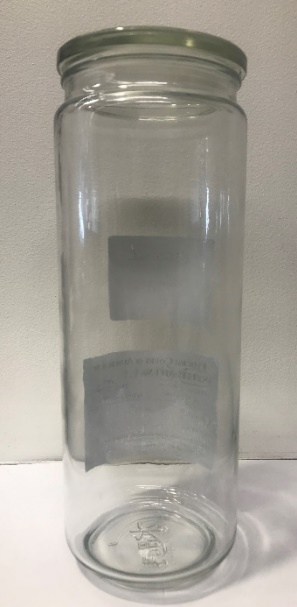
103 It became apparent that this jar was not large enough to hold 400 grams of freeze-dried instant coffee. Further, concerns were raised as to whether it was too tall for the standard-sized height of supermarket shelves such as those on which 400-gram Moccona jars were displayed. The dimensions of the jar were therefore adjusted: the height was reduced, so as to better fit the supermarket shelves; and the diameter of the cylindrical body was increased, so that the jar could hold 400 grams of coffee. The result was a jar in the shape that Cantarella ultimately used for the Vittoria 400-gram product.
104 Ultimately, I am not persuaded that the evidence about the development of the Vittoria 400-gram jar bears on the issues in this case. The evidence reveals that Cantarella wished to enter the instant coffee market using its Vittoria brand, believing that the market for Vittoria might be profitable, and knowing that Moccona was a major brand in that market. It also reveals that Cantarella considered a range of packaging formats. Cantarella assessed those formats against various criteria, including the degree to which they were perceived as “premium”. Cantarella wished to compete with the Moccona brand, and to launch a product that was capable of being sold in supermarkets just as widely as Moccona instant coffee was sold. Cantarella also wished to occupy a similarly premium position in the instant coffee market to Moccona. However, Cantarella selected as a starting point a jar that was put forward by a supplier. As events transpired, that jar had to be modified to suit Cantarella’s requirements. One requirement was that it was actually large enough to hold 400 grams of coffee. Another was shelf height. In combination, these requirements led to an increase in diameter and a reduction in height.
105 I find that for the purposes of sale of instant coffee products in supermarkets where a share of the instant coffee market could be expected to be gained at the expense of other suppliers, it is unremarkable that Cantarella should decide that its 400-gram jar should have a similar height to that of the Moccona 400 gram jar, which at the time of launch was the only competing 400-gram freeze-dried coffee in a jar. Nescafé Gold was introduced in 400-gram jars a month or two after the Vittoria 400-gram product was introduced. The Nescafé Gold 400-gram jar is slightly taller than the Moccona and Vittoria 400-gram jars. Mr Tillman accepted that, generally speaking, supermarkets prefer not to have significant headspace in their shelving because it would be a waste of space, and that generally supermarkets want products to conform. Some of the contemporary photographs of consumer items displayed on supermarket shelves that were in evidence showed competing products on the same shelf. In the case of instant coffee, a photograph on p 71 of Professor O’Sullivan’s first report showed a number of shelves displaying competing products. Taller products, such as large tins of International Roast and Nescafé Blend 43, and 400-gram jars of Moccona, Vittoria, and Nescafé Gold were on the two lowest shelves. The tallest product by a margin appeared to be the 400-gram jars of Nescafé Gold –
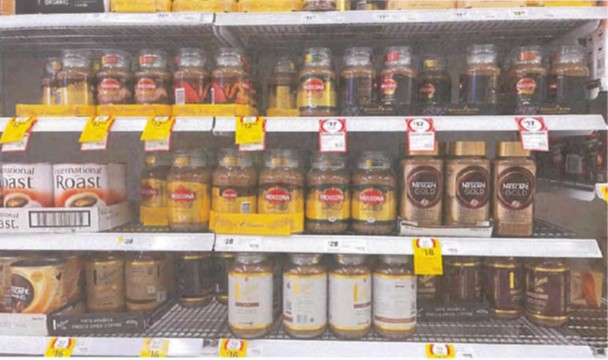
106 The statements of Dixon and McTiernan JJ in Australian Woollen Mills and of Weinberg and Dowsett JJ in Sydneywide should not be understood as erecting a rule of law. They constitute appellate guidance in relation to fact-finding, which is plain from the statement of Dixon and McTiernan JJ in Australian Woolen Mills at 658 that “in the end, it becomes a question of fact for the court to decide whether in fact there is such a reasonable probability of deception or confusion that the use of the new mark and title should be restrained”. Intention is but one factor that the court may take into account in its factual evaluation, perhaps in a borderline case: Hashtag Burgers Pty Ltd v In-N-Out Burgers, Inc [2020] FCAFC 235; 385 ALR 514 at [68] (Nicholas, Yates and Burley JJ). I do not conclude from the entire series of events, only aspects of which I have canvassed in these open reasons, that Cantarella was deliberately attempting to mislead consumers, or that it considered that its jar shape was likely to deceive or confuse. I do not accept the applicants’ claim that Cantarella was attempting to “sail close to the wind” in any relevant sense. The process by which Cantarella developed its jar is, therefore, irrelevant to the pleaded causes of action. The questions of trade mark use, deceptive similarity, and likelihood of misleading or deceiving are to be considered in this case by reference to the objective facts alone.
107 In arriving at the above conclusions, and the supporting findings set out in the confidential annexure, I have had regard to the applicants’ submission about the significance of Cantarella’s failure to call as witnesses three persons involved in the process of selecting the Cantarella jar shape: Les Schirato, Roland Schirato, and Mathias Stamm. The applicants submitted that I should more comfortably draw inferences adverse to Cantarella by reason of their absence from the witness box. However, for the reasons that I give, the evidence does not get to the point where I would contemplate drawing the inferences for which the applicants contended. What Cantarella did is well documented, as detailed in the confidential annexure. And Cantarella did call Mr Hill, to whom Mr Stamm reported, and who in turn reported to Mr Les Schirato. Mr Hill was cross-examined. It was put to Mr Hill that in developing and finalising the design of its 400-gram jar, Cantarella was consciously trying to align the shape and size of its jar as close to the Moccona shape as it could, which Mr Hill denied. As I stated at [25] above, I formed a favourable view of Mr Hill as a witness. I accept Mr Hill’s evidence. The evidence shows that Cantarella was well aware of Moccona’s presence in the market for freeze-dried coffee, and that it sought to enter that market with its own product. But for the reasons explained in the confidential annexure, the final shape of the Cantarella jar was not developed for the purpose of emulating the shape of the Moccona jar, or to mislead consumers, but was largely the result of the functional considerations that are referred to in the annexure.
Advertisements for the Vittoria brand in Australia
108 Over various periods from 30 October 2022 to 22 July 2023, television advertisements for the Vittoria 100-gram product were broadcast on various Channel 9 channels. One of the advertisements in question was a 30-second advertisement that focused on the process of coffee growing and processing. Relevantly, it includes a shot of a man holding up a cylindrical glass jar full of coffee beans. The jar in question is unlabelled, but it appears to be similar in shape to the Vittoria 100-gram product –
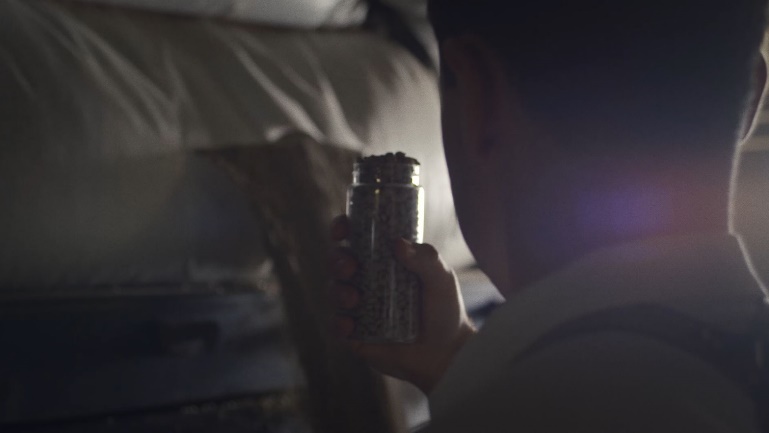
109 The advertisement ends on a shot of all four varieties of the labelled Vittoria 100-gram product, next to the tagline “Now in Instant”, as a ray of light passes over and illuminates the four jars –
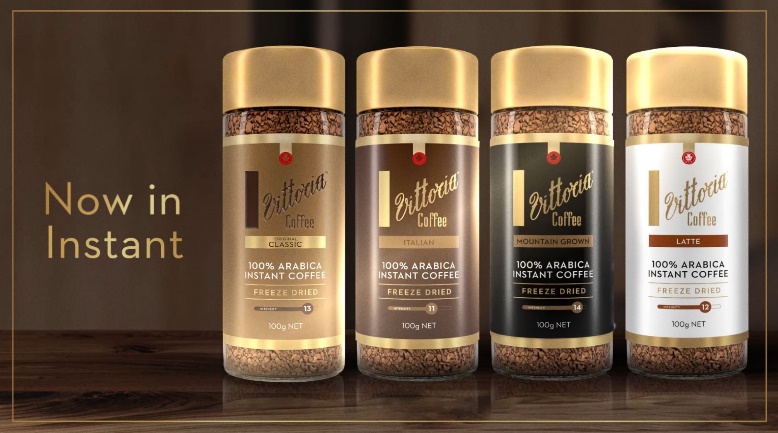
110 In a 15-second version of the advertisement broadcast on the Channel 9 channels (which does not feature the empty jar), the final image appears as follows –
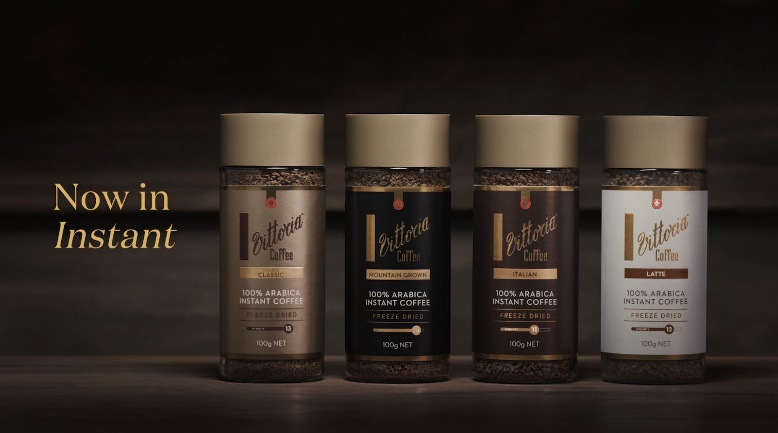
111 Advertising of the Vittoria 100-gram product has taken a range of other forms. As well as television advertisements, Cantarella has employed sponsorships, radio advertisements, print advertisements, posters, and billboards to advertise its Vittoria 100-gram product. Now, there was no issue in the case concerning whether Cantarella has used the shape of the Vittoria 100-gram product as a trade mark. Some of the following advertisements, however, provide context in which to place Cantarella’s advertisements for the Vittoria 400-gram product.
112 Cantarella placed a full-page advertisement for the Vittoria 100-gram product in the 4 August 2021 edition of the “Sunday Mail”. That advertisement prominently features an image of the 100-gram product, beneath the word “Instantaneous.” and above the phrase “Now in instant.” –
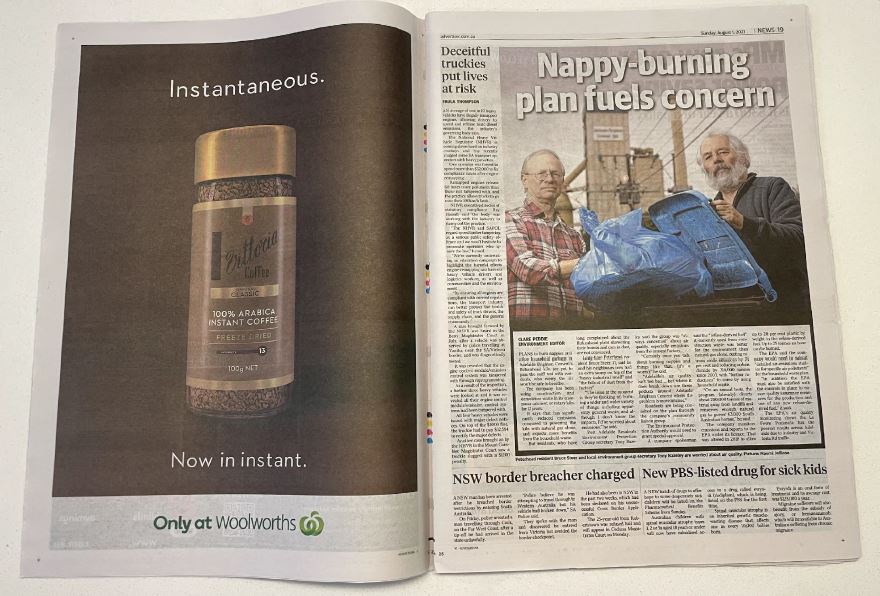
113 This advertisement and variations of it in relation to other flavour varieties were placed in several newspapers and magazines in 2021, along with half-page versions.
114 In two phases between 4 October 2022 and 1 January 2023, Cantarella also ran an outdoor campaign for the Vittoria 100-gram product that involved placing advertisements on over 100 “panels”. A photograph of an example bus-stop panel featured the Vittoria 100-gram product beneath the tagline “Instant classic” –
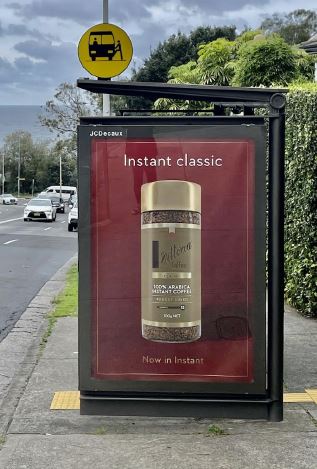
115 The same advertisement was featured on bills posted on streets in Sydney, Melbourne, and Brisbane in January, April, and May 2023 –
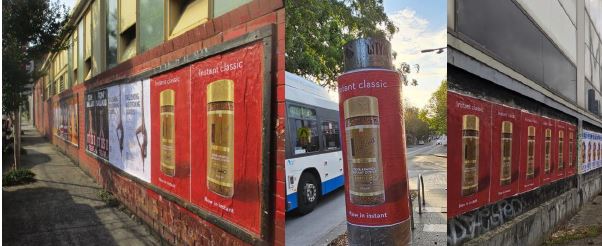
116 In late 2022 and mid-2023, Cantarella also caused the following billboard to be displayed near Melbourne’s Tullamarine Airport –
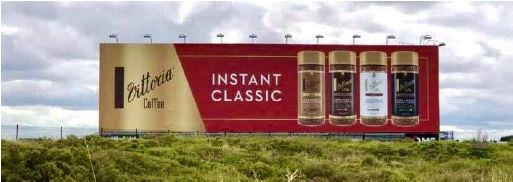
117 Across various periods from June 2021 to May 2023, Woolworths displayed aisle fins for the Vittoria 100-gram product, which featured a picture of that product as well as a separate Vittoria logo. The aisle fins were displayed in all Woolworths stores in Australia, and in Coles stores nationally. An aisle fin is essentially an advertising placard hung perpendicular to the shelves in a supermarket aisle. An example of one of the Woolworths aisle fins appears below –
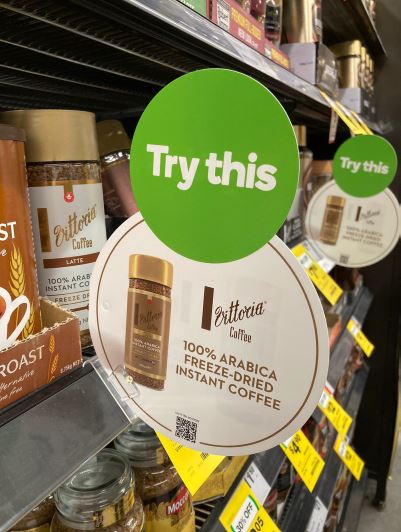
118 Cantarella has also engaged in several marketing campaigns for the Vittoria 400-gram product. The applicants relied on these marketing campaigns to support the submission, within their infringement case, that the respondent had used its Vittoria 400-gram jar as a trade mark. I will therefore set out the advertisements that I consider to be salient to that question.
119 Between September 2022 and June 2023, Cantarella commissioned 10 full-page colour advertisements and two half-page colour advertisements for the Vittoria 400-gram product in major metropolitan newspapers. The Court received into evidence an A3 copy of parts of the 25 September 2022 edition of the “Sunday Age”, which was as close as possible to the actual size of that newspaper. The mock-up included a full-page colour advertisement for the “Original Classic” Vittoria 400-gram product. An electronic version of the double-page spread on which this advertisement appeared is below –
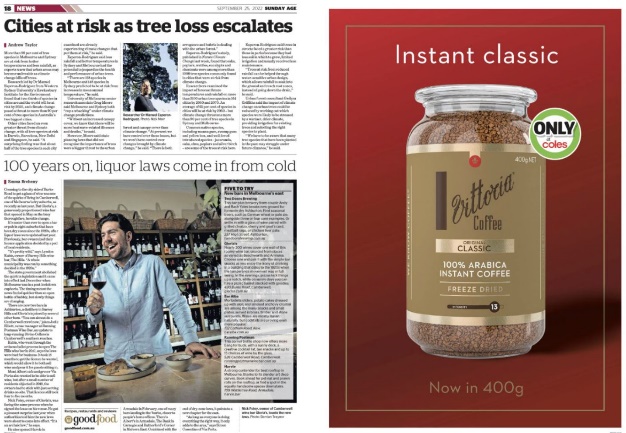
120 The advertisement prominently features an image of the 400-gram product, beneath the tagline “Instant classic” and above the phrase “Now in 400g”. As I noted at [114] above, the tagline “Instant classic” was also used in connection with the Vittoria 100-gram product. The applicants stressed that full-page advertisements cost more because they have a greater effect. I understand this to mean that advertisers are willing to secure full-page advertisements, despite their greater cost, because those advertisements are more effective. While the image I have reproduced here is small, I have taken into account the impression created by the size it would have had in the newspaper. The applicants also stressed that this advertisement contains minimal text or branding beyond the jar itself.
121 The Vittoria 400-gram product was also advertised on billboards. A photograph of one such billboard, which was posted between 21 November 2022 and 18 December 2022 near Tooronga railway station in Malvern, Victoria, is below –
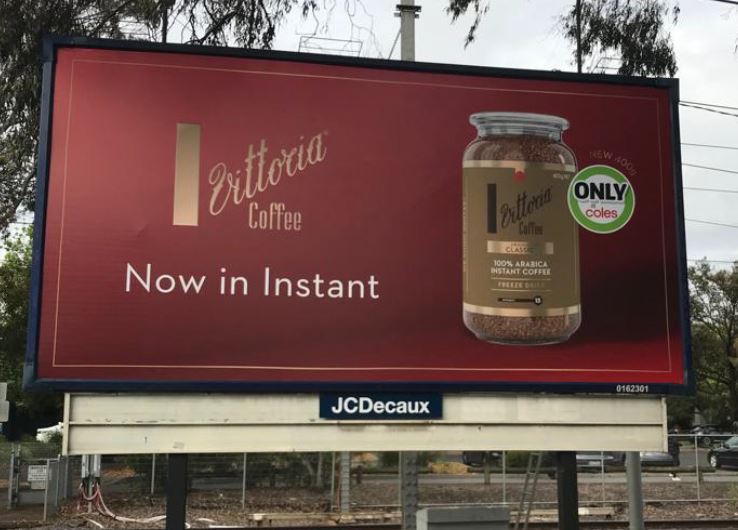
122 The applicants again emphasised that this billboard featured the jar with minimal text or additional branding, though I note that there is an additional Vittoria logo.
123 Cantarella also used social media to advertise its Vittoria 400-gram product at various periods in 2022 and 2023. The applicants drew attention to one such advertisement, which fairly represents the overall nature of the advertisements, and pointed out that it featured the jar prominently with minimal text or additional branding –
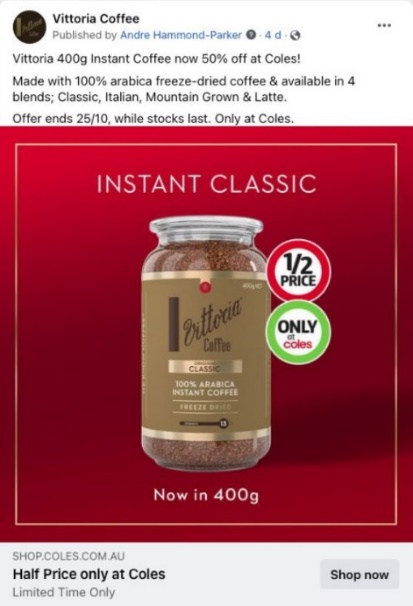
124 Another way in which the Vittoria 400-gram product was advertised was through the use of aisle fins in more than 800 Coles supermarkets. These aisle fins were displayed from November 2022 to December 2022, and again from May 2023 to June 2023. Some of the aisle fins featured the Vittoria 400-gram product alone –
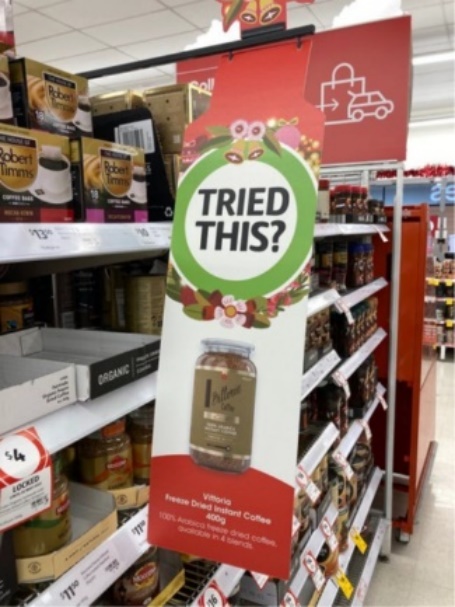
125 Other aisle fins featured the Vittoria 400-gram product alongside the 100-gram product –
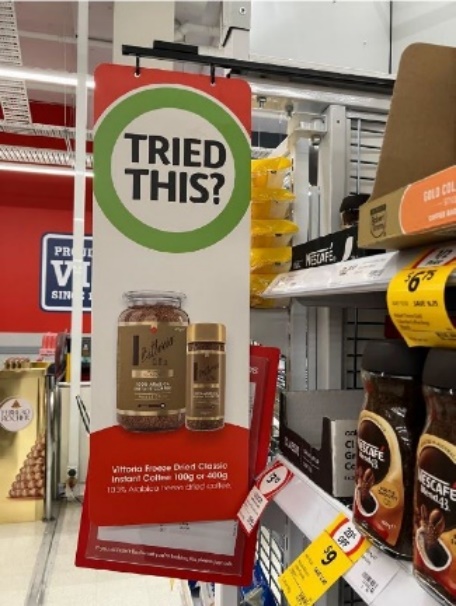
126 The applicants pointed out that the aisle fins prominently feature the Vittoria 400-gram jar, again with minimal text or additional branding.
Other coffee brands sold or marketed in Australia using a jar similar to the KDE shape mark
127 In support of its cross-claim, Cantarella drew attention to the existence of other brands of coffee that have sold, or proposed to sell, instant coffee in a cylindrical glass jar substantially in the form of the KDE shape mark.
128 The first of these brands in time was the “Andronicus” brand. The dispute that provided the occasion for Lockhart J’s judgment in Stuart Alexander concerned instant coffee, and in particular the Moccona and Andronicus brands. As I have noted, Lockhart J’s reasons were received into evidence for all purposes.
129 The Court received into evidence the originating application that commenced the proceeding which culminated in Lockhart J’s reasons reported as Stuart Alexander. That originating application records that the applicants in the proceeding were “Stuart Alexander & Co (Interstate) Pty Limited” and “Douwe Egberts Koninklijke Tabaksfabriek-Koffiebranderijen-Theehandel NV”, and the respondent was “Blenders Pty Limited”. Relatedly, the evidence was that, in around 1975 or 1976, an Australian company trading as Stuart Alexander was appointed as the Australian distributor of Moccona-branded instant coffee. The distribution arrangement involving Stuart Alexander ended on 1 July 1992. From that date onwards, JDE AU took over the importation and distribution of Moccona-branded instant coffee in Australia. The reasons of Lockhart J at 308 state that the second applicant to that proceeding, Douwe Egberts Koninklijke Tabaksfabriek-Koffiebranderijen-Theehandel NV, was the manufacturer of Moccona-branded coffee.
130 Lockhart J’s reasons also state at 308 that Andronicus was a well-known brand name in Australia, which was associated with premium quality instant coffee. Lockhart J stated at 308 that, in the middle of 1981, Andronicus coffee began to be sold “in a jar substantially the same as the jar in which Moccona ha[d] been sold for at least fifteen years”. I have already dealt with the evidentiary weight of Lockhart J’s statement as to the length of time for which Moccona had been using a jar in the shape of the KDE shape mark. Nevertheless, given the immediacy of the event in question, I consider his Honour’s statement that Andronicus coffee began to be sold in a jar similar to the KDE shape mark to be probative.
131 More specifically, Stuart Alexander focused on a particular television advertisement for Andronicus coffee. That advertisement, which Lockhart J noted at 309 was screened in August 1981, was in evidence in this case. The advertisement opens on an image of an unlabelled, cylindrical glass jar with a glass stopper lid, which is similar in form to the KDE shape mark –
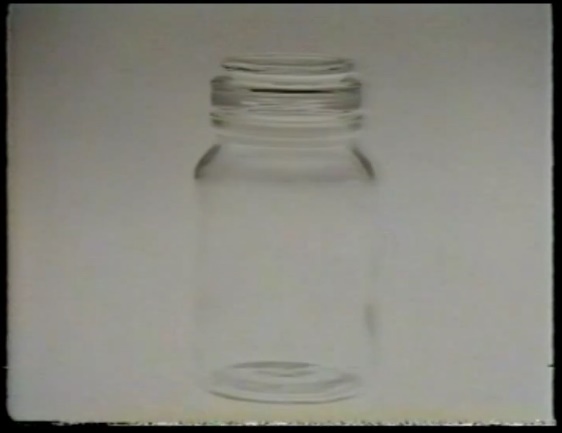
132 That glass jar gradually fills up with coins while a voiceover can be heard to say: “Some imported coffees come in a beautiful jar, but they cost the earth” –
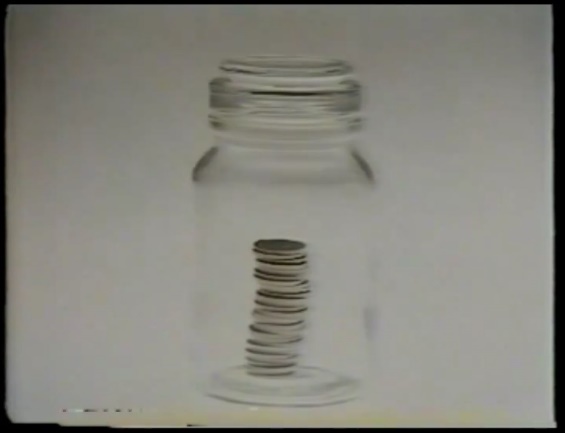
133 Next, a plain cylindrical glass jar with a plastic screw-top lid appears next to the previous jar. The new jar itself begins to fill with a smaller pile of coins, as the voiceover says: “Other coffees come in a plain jar, at a much lower price” –
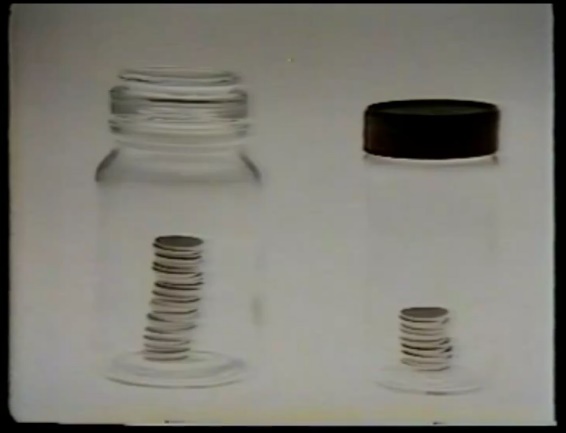
134 The frame then grows to include a third jar within its compass. The third jar, which is the same shape as the first jar, fills with a pile of coins roughly the same size as the pile in the second jar.
135 In the next shot, a hand rotates the third jar as an Andronicus label appears on it. At the same time, the voiceover states: “Only one offers you the right combination of quality and value: Andronicus, the taste of coffee from the heart of the bean” –
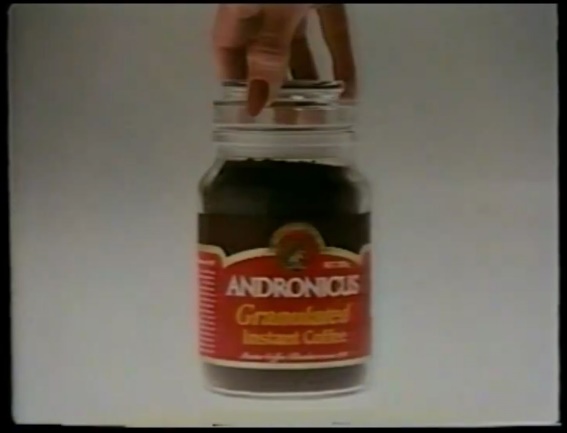
136 The advertisement concludes with a sequence showing the three jars back in the same frame. This time, the jar on the right is full of coffee, and is labelled as an Andronicus product. The piles of coins in the first and second jars collapse, as the voiceover states: “Andronicus: premium instant coffee, at a sensible price” –
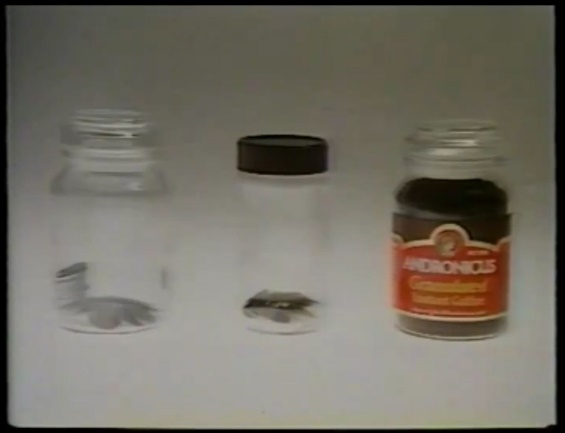
137 The Andronicus advertisement was relevant in Stuart Alexander because the applicants in that case alleged that the respondent had engaged in misleading or deceptive conduct, and made certain false or misleading statements, by procuring the broadcast of the advertisement. In particular, the applicants in Stuart Alexander attacked the advertisement on the grounds that it suggested that while Moccona coffee was imported, Andronicus coffee was not imported, whereas in fact Andronicus coffee was also imported. The second aspect of the applicants’ case was that the labelling and general appearance of the jars containing Andronicus instant coffee would mislead consumers.
138 As Lockhart J noted at 309, both of these attacks assumed that the viewer of the advertisement would associate the first jar with Moccona coffee. His Honour found as a fact at 310 that “people who look at the television commercial would associate the first jar with Moccona instant coffee”, based on the evidence of witnesses along with the fact that only three brands of instant coffee used the “apothecary”-style jar, of which only Moccona and Andronicus were sold widely in supermarkets.
139 Also in evidence was a full-page advertisement for Andronicus coffee from the 12 May 1982 edition of “The Australian Women’s Weekly” –
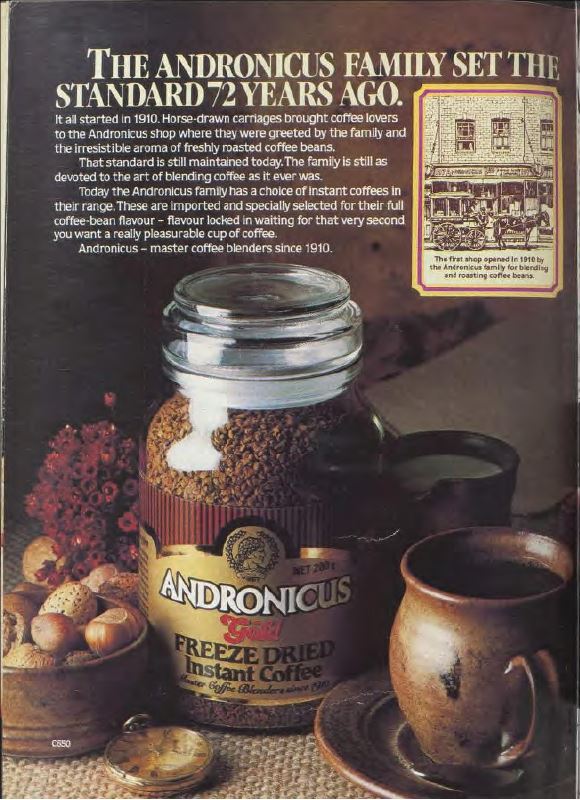
140 There were further advertisements for Andronicus coffee in evidence, which spanned the years between 1982 and 1985. The advertisement from 1985 was a small, black-and-white drawing in a catalogue within the 13 March 1985 edition of “The Canberra Times”. It appears to show Andronicus being offered for sale in a jar substantially similar to the KDE shape mark, as do all the intervening advertisements –
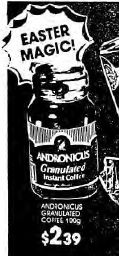
141 The Court also received into evidence a cylindrical glass jar with a glass stopper lid, which was identified as an Andronicus jar with its label removed. This jar was substantially in the form of the KDE shape mark –
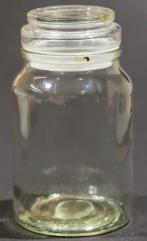
142 On the basis of the evidence I have identified, I am satisfied that instant coffee was sold in Australia under the Andronicus brand in a jar substantially resembling the KDE shape mark from the middle of 1981 to at least 13 March 1985.
143 The second of the brands to which Cantarella drew attention on its cross-claim was the “Park Avenue” brand. As noted above, Cantarella read to the Court an affidavit of Leigh Alfred Harrison, who has been a director of Abel Lemon Trading Pty Ltd since 1992. Mr Harrison was not required for cross-examination, and his evidence was therefore unchallenged. In his affidavit, Mr Harrison referred to his inability to remember certain details. I accept, however, that Mr Harrison’s evidence about the “Park Avenue” brand can be relied upon in relation to the matters it positively addresses.
144 Mr Harrison became the Sales Director for Abel Lemon Food Services (a predecessor of Abel Lemon Trading Pty Ltd) in 1993. Mr Harrison deposed that, in around 1993, Abel Lemon Food Services imported approximately four to six shipping containers (each 20 feet in length) of a coffee product known as “Park Avenue” from Brazil. Annexed to Mr Harrison’s affidavit was an excerpt from the 21 April 1993 edition of the “Australian Supermarket News”, which contained an article about Park Avenue instant coffee, accompanied by the following photograph –
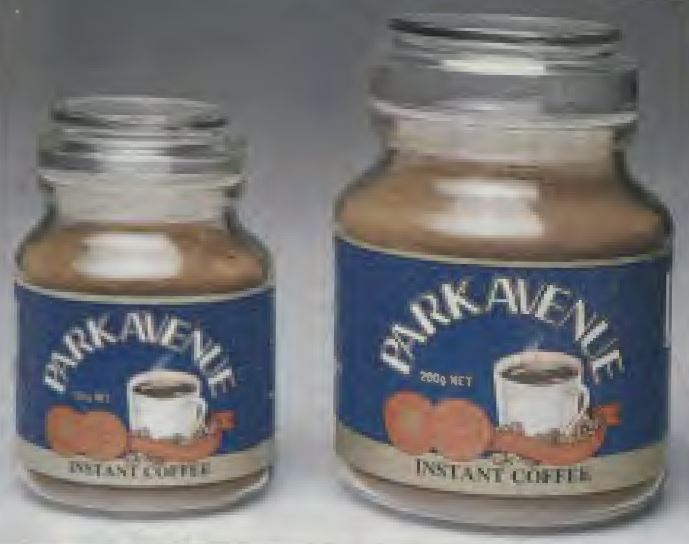
145 Mr Harrison stated that Park Avenue coffee was not sold in any packaging format other than the one depicted in this photograph. Park Avenue coffee was sold only in the two sizes shown in the photograph, being a 100-gram size and a 200-gram size. Mr Harrison stated that Park Avenue coffee was sold in supermarkets nationally, though he could not recall which particular supermarkets stocked it. He also deposed that Park Avenue coffee was advertised using in-store promotions in addition to the article in the “Australian Supermarket News”.
146 Mr Harrison stated that Abel Lemon Food Services did not continue to import the Park Avenue coffee product, or place any further orders, after the initial order. Based on his experience, Mr Harrison stated that he believed it would have taken supermarkets around six to 12 months to sell through the supplied stock of Park Avenue instant coffee.
147 The third brand relied upon by Cantarella in support of its cross-claim was the “Bomcafé” brand. Unlike Andronicus and Park Avenue, there is no evidence that any instant coffee has ever been sold in Australia under the Bomcafé brand. In evidence, however, was a copy of a web page for Bomcafé, part of which showed three clear jars of instant coffee substantially in the form of the KDE shape mark –
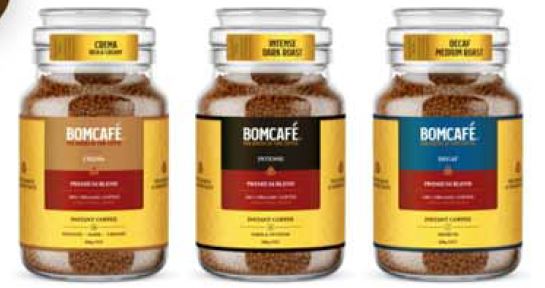
148 I have said that there is no evidence Bomcafé was ever sold in Australia. The web page that is in evidence contains several indications that support a finding that no Bomcafé products had been sold in the jar depicted, at least by the date the copy of the web page was made. For example, the web page states –
(a) “We aim to offer masterly crafted coffee-based products”;
(b) “Bomcafé will offer a truly exceptional specialty coffee”;
(c) “Our unique range … will include” various products;
(d) “Here are a few samples of our 60+ products and an overview of proposed design concepts for a new line to be developed”; and
(e) “Artwork designs, illustrations and photographs/images on this website and in our brochures depict finishes and features of the proposed packaging for the brand. Artwork designs and all rendered packaging concepts displayed herein are for presentation only and may be subject to changes before packaging manufacturing process and/or a product launch”.
149 Indeed, while nothing particularly turns on this, I am not satisfied that any Bomcafé product has ever been sold in Australia, or that Bomcafé has any reputation in Australia.
The marketing experts
150 As I mentioned earlier, the parties called two witnesses with expertise in marketing, namely Professor Richard Don O’Sullivan, who was called on behalf of the applicants, and Mr Paul Lindsay Blanket, who was called on behalf of Cantarella.
The applicants’ marketing expert — Professor O’Sullivan
151 Professor O’Sullivan is a Professor of Marketing at Melbourne Business School within The University of Melbourne. Professor O’Sullivan has held various positions at Melbourne Business School since 2008. Before this, he was a Lecturer in Marketing at University College Cork (in Ireland) from 1992 to 2007, except for a period between 2000 and 2003, when he worked as the Director of Strategic Marketing at a marketing services company called TecBrand. At TecBrand, Professor O’Sullivan’s duties involved advising clients on marketing strategy and brand management. Professor O’Sullivan has attained the degrees of Bachelor of Commerce, Masters in Business Studies, and Doctor of Philosophy within University College Cork. Alongside his research and teaching in marketing at Melbourne Business School, he spends about a quarter of his time working as a marketing consultant to businesses.
152 Professor O’Sullivan produced two reports of his own, as well as contributing to a joint report with Mr Blanket.
Professor O’Sullivan’s first report
153 Professor O’Sullivan’s first report was dated 26 May 2023. This report addressed eight questions put to Professor O’Sullivan by the applicants’ solicitors in a letter of instructions dated 24 March 2023. In his first report, Professor O’Sullivan proceeded on the basis of assumptions and material provided to him in that letter, as well as further assumptions provided in a supplementary letter from the applicants’ solicitors dated 3 May 2023.
154 Professor O’Sullivan commenced his first report by explaining some key concepts he deployed to ground his opinions. He explained that, in a marketing context, the term “brand” refers to a “name, term, design, symbol, or any other feature that identifies one seller’s good or service as distinct from those of other sellers”. Professor O’Sullivan explained that, in accordance with the usage of marketing academics and practitioners, he treated the terms “brand” and “trade mark” as having the same meaning. He also explained that he used the term “brand element” when referring to any feature that identifies one seller’s good or service as being distinct from those of other sellers. He stated that the expression “line extension” refers to the use of an established brand to market products in a new market segment, while the expression “brand extension” refers to the use of an established brand to promote a completely different type of product, in a new category.
155 He further stated that, in a marketing context, “involvement” refers to the perceived relevance of an object to a consumer and is based on their inherent needs, values, and interests. He opined that consumers tend to engage in a more considered assessment of available information when they are more highly involved.
156 Professor O’Sullivan stated that a “diagnostic cue” is any stimulus that people rely on in order to categorise objects, and that “brand elements” operate as diagnostic cues when they are relied upon by consumers engaged in brand search and identification. Professor O’Sullivan opined that consumers, when faced with multiple diagnostic cues, tend to place greater weight on cues that are perceived to be more useful in identifying the brand or differentiating between products from different brands in the same category. In Professor O’Sullivan’s view, for consumers to rely on a brand element as a diagnostic cue, it must be an element that consumers both notice and link uniquely to the brand. He stated that, while consumers may rely on a logo as a diagnostic cue, they may also rely on cues like colour and other elements of packaging to identify and notice specific brands. Professor O’Sullivan gave his opinion that packaging is an important aspect of the way brands are identified, particularly for brands sold in supermarkets.
157 Professor O’Sullivan was asked to comment on how the principles explained in the first section of his report applied in the context of instant coffee products for sale in Australia. Professor O’Sullivan relied upon prior studies, which in his view “point[ed] to instant coffee being a low-involvement product category for consumers”. Professor O’Sullivan also stated that, in a supermarket context, consumers will select from a wide array of products and brands in a matter of one or two seconds. He stated that it was his opinion that, in line with the “principle” of diagnostic cues, consumers will tend to seek out distinctive brand elements and screen out stimuli that are not diagnostic. Consumers looking for their usual brands, Professor O’Sullivan opined, are likely to search for the brands’ key elements, including logo, package shape, and other distinctive elements. Professor O’Sullivan opined that package shape is used as a brand element by several instant coffee brands available in Australian supermarkets, most notably Moccona, Robert Timms, and Nescafé Blend 43.
158 Professor O’Sullivan was also asked to give his opinion as to what consumers would recognise as the key branding elements in relation to Moccona instant coffee products. As part of his response to this question, Professor O’Sullivan identified the Moccona logo, sub-brands, the colour scheme, imagery, numbering on labels, descriptors, and packaging shape and material as elements that appear in relation to Moccona instant coffee products. With respect to their weighting, Professor O’Sullivan stated that, as well as appearing on jars of Moccona coffee, the Moccona logo appears on products such as packets of ground or bean coffee, coffee capsules, and sachets. He opined that, as the Moccona logo is common to a range of products, consumers searching for Moccona instant coffee products may not rely upon the Moccona logo as the most diagnostic cue. By contrast, he opined that the cylindrical glass jar with a flat-topped glass stopper is likely to be perceived by consumers as being highly diagnostic, and thus relied on heavily when searching for Moccona instant coffee products. The basis for this opinion was that Moccona is offered for sale in a form of packaging that is unique within the category and uniform across the jars in the range, and which has remained consistent since the brand’s introduction to the market.
159 Professor O’Sullivan was asked whether consumers were likely to perceive the shape of the Moccona jar as indicating a connection in the course of trade between the product and Moccona. He stated that, in his opinion, many consumers are likely to perceive the shape of the Moccona jar as indicating such a connection. In brief terms, the considerations that formed the basis for this opinion were identified as the following –
(a) the brand has been present and prominently displayed in supermarkets in Australia for many years;
(b) awareness of the cylindrical glass jar with a flat-topped glass stopper, and association of it with the Moccona brand, is likely to be high due to the uniqueness of this packaging in the instant coffee category;
(c) the Moccona jar is unique to Moccona instant coffee products, and so consumers are likely to have relied upon this feature when searching for products in store;
(d) the Moccona jar will be familiar through actual regular usage of the jar to consumers who have purchased it;
(e) efforts have been made over many years to associate in the minds of consumers the cylindrical glass jar with a flat-topped glass stopper with the Moccona brand; and
(f) advertising of Moccona instant coffee products has, at times, presented the jar as an item of value in itself, not simply as a container, and these advertising initiatives would only have been repeated if they “generated meaningful participation from consumers”.
160 Professor O’Sullivan was also asked to consider what consumers would recognise as the key branding elements of the Vittoria 400-gram product. He identified the Vittoria logo, the label on the jar, the package shape, and the branded packing trays in which the products were displayed as the key branding elements of the Vittoria 400-gram product.
161 Professor O’Sullivan was asked to consider whether consumers were likely to perceive the shape of the Vittoria 400-gram jar as indicating a connection in the course of trade between the product and Vittoria. In response, he opined that consumers were likely to perceive the shape of the Vittoria 400-gram jar as indicating such a connection. He gave his opinion that package shape is used as a brand element for the Vittoria 400-gram product, and reiterated that a brand element identifies one seller’s good or service as distinct from those of other sellers. Professor O’Sullivan further opined that it was a highly noticeable feature of the Vittoria 400-gram product that it was packaged in a cylindrical glass jar with a flat-topped glass stopper. Because it was a highly noticeable feature, Professor O’Sullivan opined that consumers were likely to view package shape as a brand element. He also expressed the opinion that consumers were likely to rely on the package shape when identifying the Vittoria 400-gram product. To adopt Professor O’Sullivan’s terminology, that would appear to mean that package shape also constitutes a “diagnostic cue” in relation to the Vittoria 400-gram product.
162 Professor O’Sullivan was asked whether there is a “real risk” that consumers who know, but have an imperfect recollection of, the shape of the Moccona jar will see the shape of the Vittoria jar and be caused to wonder whether it might not be the case that the products come from the same source or are otherwise related. Professor O’Sullivan stated that, in his opinion, there is such a risk. The gist of the reasoning underpinning his opinion was that –
(a) consumers are likely strongly to associate Moccona instant coffee products with a cylindrical glass jar with a flat-topped glass stopper;
(b) consumers searching for Moccona instant coffee are likely to look for a cylindrical glass jar with a flat-topped glass stopper;
(c) some consumers are likely to have an imperfect recollection of the Moccona jar;
(d) the way that Moccona products and the Vittoria 400-gram product are displayed, presented, and marketed could lead consumers into confusion;
(e) a lack of recognition of the Vittoria brand in the instant coffee category would amplify the risk of confusion, as consumers faced with a Vittoria product would pay less attention to the brand name, and presumably focus on other “diagnostic cues” instead; and
(f) the Moccona jar and the Vittoria 400-gram jar have a similar appearance.
163 The next question put to Professor O’Sullivan was whether, in his view, there was a likelihood that consumers who know the Moccona instant coffee products would see the Vittoria 400-gram product and believe it to be connected, associated, or affiliated with Moccona or its products. Professor O’Sullivan stated that, in his opinion, a strong likelihood of this existed in relation to a not insignificant proportion of consumers. As well as the points addressed in his response to the previous question, Professor O’Sullivan referred to the concept of “co-branding” in support of his opinion. “Co-branding” occurs when brands owned by separate traders are used together to promote a product. Professor O’Sullivan’s opinion was that consumers may infer that the Vittoria 400-gram product represented an alliance between Vittoria and Moccona.
Professor O’Sullivan’s second report
164 Professor O’Sullivan’s second report was dated 25 August 2023. For the purposes of this second report, Professor O’Sullivan was asked to consider Mr Blanket’s first report and to comment on any matters discussed in that report with which Professor O’Sullivan did not agree, or on which he otherwise wished to comment.
165 In this report, Professor O’Sullivan expressed particular disagreement with Mr Blanket’s opinions regarding –
(a) the meaning and application of the concept of diagnostic cues;
(b) the circumstances in which packaging can amount to a brand element;
(c) the concepts of line extension and brand extension;
(d) the likelihood of consumer confusion between Moccona instant coffee and the Vittoria 400-gram product; and
(e) the likelihood that consumers would perceive a connection between the traders standing behind Moccona and Vittoria.
166 Professor O’Sullivan also provided commentary on the evidence of Mr Hill, the Chief Operating Officer of Cantarella, as well as his opinions as to the similarities and differences between the shapes of the KDE shape mark and the Vittoria 400-gram product. In particular, Professor O’Sullivan identified as key similarities his opinion that (a) both jars have a flat-topped stopper; (b) both jars are cylindrical; and (c) both jars have a high shoulder. He also noted some differences between the jars, being that the KDE shape mark has a taller stopper, and that the KDE shape mark has a taller shoulder.
Cross-examination of Professor O’Sullivan
167 Professor O’Sullivan was cross-examined at length in the concurrent evidence session with Mr Blanket. The topics upon which Professor O’Sullivan was examined included his precise conception of “brand elements”, the various sources on which he relied, his views on consumer behaviour, and the similarities and differences between the Vittoria 400-gram product and Moccona instant coffee. Professor O’Sullivan’s evidence generally adhered to the positions taken in his reports and the joint expert report. Cross-examination did, however, expose some difficulties with aspects of Professor O’Sullivan’s evidence, which I will explain further below when I explain my conclusions on the weight that I give to the marketing expert evidence.
Cantarella’s marketing expert — Mr Blanket
168 As I mentioned earlier, Mr Blanket is the Founder and Principal of First Impressions Pty Ltd, a marketing and communications consulting firm, which he established in 1987. From 1974 to 1980, he was employed by Unilever Australia Pty Ltd in various marketing positions, including as Group Product Manager for Streets ice cream. From 1980 to 1987, Mr Blanket was employed as a Group Account Director for an advertising agency. Mr Blanket has attained the degrees of Bachelor of Commerce (Marketing) and Master of Commerce (Marketing) within the University of New South Wales. He has also completed postgraduate programs such as the University of Melbourne Management Program. Mr Blanket is a Fellow of the Australian Marketing Institute and has gained Certified Practising Marketer status. He is also an Adjunct Professor of Marketing and Sessional Academic at the Macquarie Graduate School of Management and Macquarie Business School. Mr Blanket has experience in the marketing of coffee products.
169 Mr Blanket produced two reports of his own, as well as contributing to the joint report with Professor O’Sullivan.
Mr Blanket’s first report
170 Mr Blanket’s first report was dated 28 July 2023. For the purposes of this report, Mr Blanket was asked by Cantarella’s solicitors to provide his understanding of various marketing issues, and to comment on Professor O’Sullivan’s first report.
171 Mr Blanket was asked to provide an outline of his understanding of certain marketing concepts and theory. Mr Blanket explained what he understood by the terms “brand”, “consumer involvement”, “diagnostic cues” and “heuristics”, and “line extension” and “brand extension”. In some respects, Mr Blanket’s understanding of these terms differed from the way Professor O’Sullivan deployed them. Some of the differences related to questions of definition or labelling. These differences are not material to any question, provided the evidence of both witnesses is understood according to the substance of what it conveys, rather than by picking up and deploying terms of art in marketing as being determinative of any legal question. Other differences were more substantive, and related to questions such as how consumers form preferences, and factors that influence buyer behaviour other than involvement.
172 Mr Blanket was also asked to explain his understanding of the coffee market in Australia. Essentially, Mr Blanket proffered the view that the retail coffee market has three segments: fresh coffee, instant coffee, and coffee-making equipment. He also explained the concept of co-branding, and the dual role of packaging as performing a function and communicating something to the consumer.
173 Mr Blanket was asked to consider the Vittoria 400-gram product and identify the brands in use in relation to it. Mr Blanket identified three primary diagnostic cues, being the Vittoria brand name, the Vittoria logo, and the vertical stripe adjacent to the Vittoria name in the Vittoria logo. He also identified various secondary diagnostic cues, including gold stripe accents, the use of the Vittoria logo on the lid of the jar, and the embossed Vittoria logo on the base of the jar. Mr Blanket expressed the opinion that the shape of the Vittoria 400-gram glass jar did not operate as a brand. That was because, first, “it is only where packaging is truly innovative and breaks the mould that it can operate as a brand”, and because the jar has a functional purpose. Mr Blanket stated that because various packaging types are used across the range of Vittoria products, consumers would not associate any particular packaging format with the Vittoria brand.
174 Mr Blanket was also asked to consider a variety of Moccona instant coffee products and identify the brands in use in relation to them. He identified as primary diagnostic cues the Moccona brand name and the Moccona logo. Mr Blanket did not consider the shape of the Moccona jar to be a primary diagnostic cue. One reason the shape of the Moccona jar was not a primary diagnostic cue in Mr Blanket’s opinion was that it varied across the range, with the 150-gram jar being relatively taller and thinner in its proportions. This opinion was not displaced by his review of various advertisements for Moccona. Mr Blanket identified the slight curve at the top edge of the label on Moccona instant coffee products as a weak secondary diagnostic cue.
175 Mr Blanket was asked to offer his opinion on the similarities and differences between the appearance of Moccona instant coffee products and the Vittoria 400-gram product, and to explain whether consumers would perceive any connection between the Vittoria 400-gram product and Moccona. Mr Blanket identified the following features as visual similarities –
(a) the containers for both products are jars made of glass;
(b) both jars have transparent sections above and below the product label; and
(c) the lids of both jars are largely flat on top and use a plastic or rubber seal.
176 Mr Blanket identified the following features as visual differences –
(a) differences between the labels in terms of brand name, colour, and logo;
(b) differences in the shape and structure of the products’ lids, with the Moccona jar having a deeper lid as a proportion of the overall height, with a stepped profile;
(c) the presence of a label on the top of the Vittoria 400-gram product’s lid; and
(d) the embossed Vittoria logo on the base of the Vittoria 400-gram product.
177 In view of these features, Mr Blanket expressed the opinion that consumers would not perceive any connection between the Vittoria 400-gram product and Moccona instant coffee products.
178 Mr Blanket also made observations on related topics and points arising out of the first report of Professor O’Sullivan. He also provided his opinion on the diagnostic cues that were used in relation to the Andronicus and Park Avenue brands of instant coffee.
Mr Blanket’s second report
179 Mr Blanket’s second report was dated 3 October 2023. Mr Blanket’s second report addressed points arising out of Professor O’Sullivan’s second report, identified areas where Mr Blanket believed he and Professor O’Sullivan agreed or disagreed, and otherwise contained comments on Professor O’Sullivan’s second report.
180 In his second report, Mr Blanket responded to various points raised in Professor O’Sullivan’s second report. In particular, Mr Blanket gave his opinions on certain questions of methodology, consumer behaviour, and the meaning of diagnostic cues. A theme that ran through Mr Blanket’s evidence in this report, in addition to his first report, was that consumers will generally rely on a feature of a product to identify the source of that product when the feature is used consistently across the range of products produced as part of that brand. His distinction between “primary” and “secondary” diagnostic cues picks up on this theme, and states that the strength of a diagnostic cue depends on the uniqueness of the cue and the consistency with which it is used across the range of products.
Cross-examination of Mr Blanket
181 Mr Blanket was also cross-examined as part of the concurrent evidence session with Professor O’Sullivan. Mr Blanket was cross-examined on many of the same topics as Professor O’Sullivan. A main area of focus in the cross-examination of Mr Blanket related to the definitions of various terms, and whether Mr Blanket considered that particular jars, or other features of products, amounted to a brand element. Mr Blanket also offered his opinions on consumer behaviour and the realities of marketing brands in a supermarket context. As I will explain, there were certain aspects of Mr Blanket’s evidence in cross-examination which, while offered in a forthright manner, revealed inconsistencies that limit the weight to be given to some aspects of Mr Blanket’s evidence.
The joint report of the marketing experts
182 Professor O’Sullivan and Mr Blanket also produced a joint report setting out their opinions on six topics. Those topics concerned –
(a) the key principles of marketing and consumer decision-making relevant to the facts of this case;
(b) the brand(s) used in relation to Moccona instant coffee products;
(c) whether the shape of the Moccona jar would be perceived by consumers as a brand;
(d) the brand(s) used in relation to the Vittoria 400-gram product;
(e) whether the shape of the Vittoria 400-gram product would be perceived by consumers as a brand; and
(f) whether consumers would see the Vittoria 400-gram product and believe that it was connected, associated or affiliated with Moccona or Moccona products.
183 With respect to the first topic, the experts agreed to a fair extent on the principles of marketing that relate to “brands”, “involvement”, “diagnostic cues”, “line extension”, “co-branding”, and the “principles of packaging”. The experts disagreed, however, as to whether and when a package shape can be a brand element, and whether there is any utility in drawing a distinction between “primary” and “secondary” diagnostic cues.
184 There was less agreement with respect to the remaining topics, and the experts largely reiterated the positions they had adopted in their individual reports on related questions.
Analysis of the evidence of the marketing experts
185 As the preceding summary shows, the evidence of the marketing experts focused on how traders create and deploy “brands”, and how consumers interact with “brands” in the context of retail purchases. The six topics canvassed in the joint expert report were essentially designed to explain the concept of a “brand” and some related concepts, to identify what brands were used in relation to jars of Moccona instant coffee and the Vittoria 400-gram product, and ultimately to offer an opinion on whether consumers would perceive a connection in the course of trade between the two, or between the Vittoria 400-gram product and the traders that stand behind the Moccona brand.
186 Viewed broadly, the expert evidence was presented on the footing that it was relevant to several questions in the case. The evidence as to the use of “brands” on the Moccona jar, including whether the shape of the jar is used as a “brand”, was directed towards the non-use case on Cantarella’s cross-claim. Conversely, evidence concerning whether the shape of the Vittoria 400-gram jar amounted to a “brand” was directed towards the applicants’ infringement case. Evidence about the likelihood of consumers confusing the two, or perceiving some connection between them, was directed towards the question of deceptive similarity on the infringement case, as well as the claims for misleading or deceptive conduct and passing off.
187 In my analysis, the evidence of the marketing experts does not greatly assist in deciding these issues. There are three main reasons for this.
188 First, the language and — more importantly — the concepts deployed by the marketing experts were the language and concepts of marketing, not trade mark law. This is no criticism, as the experts were invited to give evidence on the basis of their expertise, which lay in marketing. But it became clear that there were large mismatches between the questions the experts were addressing, and those the Court must decide.
189 Take the concept of a “brand”. The same word appears in the definition of “sign” in s 6(1) of the Trade Marks Act. The principles that determine whether a given “sign” is, in fact, being used as a trade mark are those I explain below. In brief terms, the question of trade mark use requires the Court to determine whether a given sign is being used a badge of origin to indicate a connection in the course of trade between goods and their source. But this was not the question the experts answered.
190 Professor O’Sullivan’s evidence emphasised the concept of a “diagnostic cue”, or a feature that is used by consumers to identify something or distinguish it from something else. This concept is broader than the legal concept of a trade mark. Anything that is discernible and distinctive about goods can be used as a diagnostic cue. For example, if only one producer of instant coffee were to market a 750-gram jar, consumers could successfully rely on the size of the jar as a “diagnostic cue” for identifying that producer’s coffee. But, without more, nothing about this example suggests that the size of the jar is being used as a badge of origin. In this way, the concepts deployed by Professor O’Sullivan were too broad to answer the narrower question the Court must confront.
191 Nor did Mr Blanket’s evidence align sufficiently with the questions before the Court. This time, however, the concepts he deployed were narrower than the legal concept of a trade mark. In cross-examination, Mr Blanket emphasised the concept of the “core elements of a brand”. He seemed to suggest that a feature will not amount to a core element of a brand, or perhaps even a brand element at all, if the feature does not appear consistently in relation to the entire range of products within the brand, or if it is not necessary for consumers to use for the purposes of identifying products within that brand. During cross-examination, examples were given of the Coca-Cola bottle and the triangular prism involved in the Toblerone packaging. Mr Blanket appeared to suggest that the bottle and packaging would not amount to core brand elements because some Coca-Cola and Toblerone products are sold without them. There is no corresponding rule of law that a trade mark must be used in relation to all products sold under a particular head “brand”. Indeed, the fact that Pepsi was also sold in packaging other than the Carolina bottle did not prevent Besanko J from concluding that the Carolina bottle was used as a trade mark in relation to Pepsi: see Coca-Cola Co v PepsiCo Inc (No 2) [2014] FCA 1287; 109 IPR 429 (PepsiCo) at [74], [76].
192 For this reason, while the concepts Professor O’Sullivan and Mr Blanket deployed are doubtless relevant to the theory and practice of marketing, they did not correspond to the questions before the Court. I have found that my analysis on questions of trade mark use is not assisted much by the evidence of either expert.
193 The second reason that the evidence of the marketing experts does not provide great assistance is that it was addressed to issues that are, ultimately, for the Court. This is not a trial by expert. The questions of trade mark use, deceptive similarity, and confusion in passing off are questions of fact, which require the Court to decide for itself issues of characterisation and evaluation against legal standards. More than that, the question of deception or confusion has repeatedly been described as a “jury question”. In General Electric Co (of USA) v General Electric Co Ltd [1972] 1 WLR 729 at 738, Lord Diplock, with whom Lord Reid, Lord Simon and Lord Kilbrandon agreed, stated –
[W]here goods are sold to the general public for consumption or domestic use, the question whether such buyers would be likely to be deceived or confused by the use of the trade mark is a “jury question.” By that I mean: that if the issue had now, as formerly, to be tried by a jury, who as members of the general public would themselves be potential buyers of the goods, they would be required not only to consider any evidence of other members of the public which had been adduced but also to use their own common sense and to consider whether they would themselves be likely to be deceived or confused.
The question does not cease to be a “jury question” when the issue is tried by a judge alone or on appeal by a plurality of judges. The judge’s approach to the question should be the same as that of a jury. He, too, would be a potential buyer of the goods. … That in issues of this kind judges are entitled to give effect to their own opinions as to the likelihood of deception or confusion and, in doing so, are not confined to the evidence of witnesses called at the trial is well established …
194 This statement was endorsed by the Full Court in Murray Goulburn Co-Operative Co Ltd v New South Wales Dairy Corp (1990) 24 FCR 370 at 377 (Lockhart, Pincus and von Doussa JJ). It has also been applied by judges of this Court at first instance: see, eg, Anheuser-Busch Inc v Budejovický Budvar, Národní Podnik [2002] FCA 390; 56 IPR 182 (Anheuser-Busch) at [151] (Allsop J); Adidas AG v Pacific Brands Footwear Pty Ltd (No 3) [2013] FCA 905; 308 ALR 74 (Adidas) at [215] (Robertson J). Similar observations have been made in relation to the limited assistance given by expert evidence in determining whether consumers are likely to be misled for the purposes of misleading and deceptive conduct claims, because that too is ultimately a matter for the Court’s impression: Global Retail Brands Australia Pty Ltd v Bed Bath ‘N’ Table Pty Ltd [2024] FCAFC 139 (Global Retail Brands) at [29] (Nicholas, Katzmann and Downes JJ); Domain Names Australia Pty Ltd v .au Domain Administration Ltd [2004] FCAFC 247; 139 FCR 215 at [21]–[22] (Wilcox, Heerey and RD Nicholson JJ); Cat Media Pty Ltd v Opti-Healthcare Pty Ltd [2003] FCA 133 at [55] (Branson J).
195 Consequently, the Court’s task is not simply to weigh the opinions of experts on these questions. The Court’s task is to make its own assessment, based on all the evidence and keeping in mind the legal question that is being asked. In making my assessment, I have not found it helpful to give much weight to the opinions of marketing experts on whether consumers are likely to confuse the Vittoria 400-gram product with Moccona instant coffee. I have preferred to reach my own conclusions of the likelihood of deception and confusion, based on my assessment of the Vittoria 400-gram product, the KDE shape mark, and the Moccona jar more generally when relevant, as well as the retail setting in which they are sold.
196 The third reason why the expert marketing evidence will not greatly assist the Court is that there were certain aspects of the evidence that I did not find persuasive, even in their own terms.
197 For example, Professor O’Sullivan was asked questions during cross-examination about some of the scholarly sources cited in his evidence. One proposition in Professor O’Sullivan’s first report was that consumers make purchase decisions “commonly within one or two seconds of arriving at the category in a supermarket aisle”. During cross-examination, however, Professor O’Sullivan accepted that participants in the study cited to support this proposition were “asked to make a choice within three seconds”. In other words, the study did not provide evidence for how long consumers would take to make a choice when left to their own devices. Nevertheless, Professor O’Sullivan contended that this study did provide support for the proposition put forward in his report. Professor O’Sullivan also pointed to other published works that indicated that consumers would make a decision within a short time, but the Court was not taken to a paper showing that they do so within one or two seconds. I was left with the impression that Professor O’Sullivan’s opinion on this subject reflected his own extrapolation from the studies cited, rather than the unadulterated results of those studies. While the opinions themselves may be unexceptionable, it has not always been easy to tell where the sources cited by Professor O’Sullivan shade into his own analysis and extrapolation.
198 There were also some points of difficulty with the evidence of Mr Blanket. For example, Mr Blanket expressed his agreement in the joint expert report with the proposition that a brand is “a name, term, design, symbol, or other feature that identifies one seller’s good or service as distinct from those of other sellers”. During cross-examination, Mr Blanket described various coffee jars as being “secondary diagnostic cues”. He described diagnostic cues as “elements that manufacturers create that consumers take out to determine and to recognise particular brands”, albeit that some (primary) diagnostic cues are more effective than other (secondary) diagnostic cues. Mr Blanket also made comments, both in the joint expert report and in cross-examination, to the effect that certain coffee jars were secondary diagnostic cues, “not … brand element[s]”. But Mr Blanket did not explain why he considered that a jar used, to some extent, by consumers “to determine and to recognise particular brands” could not be a “feature that identifies one seller’s good or service as distinct”. It was not always clear that Mr Blanket was deploying relevant terminology in a consistent way.
The industrial design experts
199 I can deal with the evidence of the parties’ industrial design experts more briefly, as their evidence was more confined in scope, and generally less contentious.
The applicants’ industrial design expert — Mr Andrew Simpson
200 Mr Simpson is an industrial designer and a principal of Vert Design Pty Ltd, an industrial design consultancy firm. He has attained the degree of Bachelor of Design (Industrial) within the University of Technology Sydney. As well as his experience in industrial design, Mr Simpson has experience as a glass-blower and glass-designer. Mr Simpson’s industrial design experience includes work in the coffee industry with brands such as Nescafé, amongst others. In 2018, Mr Simpson received a Churchill Fellowship to gain knowledge of glass-mould-making for art, craft and industrial production. As part of that fellowship, Mr Simpson travelled to glass studios, museums and factories in several countries to learn about the production of glass moulds.
201 Mr Simpson produced a report dated 4 September 2023. In his report, he explained the design process he adopts when working with a client on a new brief. That process has several stages, including: discovery and research; concept-generation; concept-development; design-refinement; a first round of prototyping; cost-optimisation; detailed design for manufacture and design-handover documentation; and a second round of prototyping.
202 Mr Simpson opined that good design attempts to meet consumers’ needs in three ways, by creating a product that is functional, desirable, and rationalised. Mr Simpson explained that “functional” requirements are the minimum requirements that need to be met for the product to be used as intended. He also said that “desirability” is essentially about making the product desirable to a consumer, and that “rationalisation” is about the justification for the purchase, whether that be based on value, sustainability, re-usability or other factors.
203 Mr Simpson expressed his view that it is necessary to consider the “affordance” that a product or its packaging conveys to a consumer. He explained that the term “affordance” is generally used to mean the properties a product provides to the user, or to describe the relationship between the product and the user. Mr Simpson identified, by way of example, that a chair provides the affordance of sitting to a user.
204 Mr Simpson was asked to comment on the matters that he would consider if a client briefed him to design new packaging for an instant coffee product. Mr Simpson opined that any packaging for instant coffee must meet the following two functional requirements –
(a) it must be fillable and transportable in a way that keeps the coffee as dry as possible; and
(b) it must allow the instant coffee to be accessible by a consumer in a variety of settings.
205 Mr Simpson said that once those two functional requirements were met, there was substantial freedom when designing instant coffee packaging. Mr Simpson referred to the varieties of packaging in which instant coffee is sold in Australia to illustrate this last proposition.
206 Mr Simpson also acknowledged that packaging needs to meet other requirements, depending on the channel through which the product in question is sold. By way of example, Mr Simpson referred to the fact that products sold in supermarkets may have to meet requirements imposed by supermarkets as to minimum or maximum heights.
207 In terms of “softer” requirements, Mr Simpson opined that it may also be necessary to consider whether there are any design characteristics generally present in products of a particular kind that might give consumers a cue that they are shopping within a particular product category.
208 Mr Simpson also offered some responses to aspects of Mr Francis’s report, which I will summarise next. In particular, Mr Simpson expressed a view that differed from Mr Francis’s opinion as to the practical and functional benefits of a flat-topped lid on a jar. Mr Simpson said that –
(a) glass lids can, practicably, never be completely flat;
(b) there are more ways to place lids on top of jars than Mr Francis acknowledged; and that
(c) when jars are packed for shipping, cardboard or similar material is usually placed between each layer of jars, which reduces the need for flat-topped lids to avoid breakage, and also accommodates curved punts on glass jars, which do not readily allow for stacking.
209 Mr Simpson also disagreed that it is functionally, commercially or practically necessary to use a cylinder-shaped jar. In this respect, he referred to non-cylindrical jars that are currently used to contain instant coffee in Australia. Mr Simpson also stated that other shapes of jar, such as a hexagonal shape, would be just as practicable and cheap to produce as cylindrical jars in light of current production techniques, though he acknowledged that it could cost slightly more to apply a label to a non-cylindrical jar. Mr Simpson also disagreed that it is necessary for a coffee jar to allow a hand to be inserted, provided that the coffee could be spooned or scooped out of the jar.
Cantarella’s industrial design expert — Mr David Francis
210 Mr Francis is a Director at D3 Design, a specialist packaging and product design consultancy. He holds a Bachelor of Science (Industrial Design) from the University of Canberra. He has worked in the field of industrial design since graduating from university in 1981. Mr Francis produced two reports that were relied upon in the proceeding.
Mr Francis’s first report
211 Mr Francis’s first report was dated 28 July 2023. In this report, he stated that, in around 2007, he was involved in a re-design of the jar used to contain Nescafé Gold instant coffee. Mr Francis has also been involved in designing packaging for the Piazza D’Oro brand of ground coffee, as well as Robert Timms instant coffee. Mr Francis stated that he often visits manufacturing facilities used by his clients, to improve his understanding of the process of manufacturing packaging, and labelling and assembling the final product.
212 Mr Francis summarised the industrial design process as including the following stages: discussing the brief; examining the “competitive set” in the relevant category; starting the process of designing the packaging and creating sketches, drawings and three-dimensional renders; seeking approval of the concept; and confirming manufacturing methods, undertaking detail design and making physical mock-ups.
213 Mr Francis conducted his own analysis of the similarities and differences between the KDE shape mark and the Vittoria 400-gram product. He also compared the KDE shape mark against images of the Andronicus and Park Avenue jars. For reasons that will become clear later, it is not necessary for me to summarise Mr Francis’s conclusions.
214 Part of Mr Francis’s analysis was to summarise aspects of the shape of the Vittoria 400-gram product’s packaging, or cylindrical jars in general, that were influenced by practical considerations. For example, Mr Francis stated that the thin lid of the Vittoria 400-gram product would use less glass than the lid of the KDE shape mark, which brought the commercial advantage of being cheaper to manufacture. Of course, this assumed that the KDE shape mark would be realised in glass, which is no part of the mark as registered. Mr Francis also opined on the different ways that jars in the form of the Vittoria 400-gram product and the KDE shape mark might be opened.
215 With respect to the lids of the two containers, Mr Francis stated that the KDE shape mark’s more “intricate and complex” design could also reflect an aesthetic choice. Mr Francis outlined what he saw as the benefits of using flat-topped lids, including that they are easier to transport on their own, they are easier to combine with container bodies, and they are easier to transport when so combined.
216 Mr Francis stated that, because of the way that glass containers are manufactured, cylindrical jars are more practicable to manufacture. With respect to container openings, Mr Francis opined that it would be necessary for a consumer to insert a hand into the jar while using a spoon to get to the contents at the bottom of the jar, and that this influenced the range of sizes that the openings in the containers could practically take.
217 As for the bottom of the jars, Mr Francis said that the Vittoria 400-gram product, unlike the KDE shape mark, had a “plinth” adjoining the base of the jar’s body, which did not serve any functional purpose and was largely aesthetic.
218 Mr Francis also referred to Kilner storage jars in his first report, and I will explain the relevance of this reference later in these reasons.
Mr Francis’s second report
219 Mr Francis’s second report was dated 28 September 2023. This report largely comprised Mr Francis’s responses to aspects of Mr Simpson’s report. Mr Francis agreed with a number of aspects of Mr Simpson’s report.
220 One area of disagreement identified in Mr Francis’s second report concerned the functional requirements for the packaging of instant coffee. Mr Francis stated that, while Mr Simpson had identified two important functional requirements, there were additional requirements including –
(a) the cost of manufacture and transport;
(b) efficiency of manufacture and production;
(c) retailer requirements;
(d) labelling design requirements; and
(e) any specific client requirements.
The joint report of the industrial design experts
221 Mr Simpson and Mr Francis collaborated on a report that addressed the following four topics –
(a) the requirements in relation to the design of instant coffee packaging;
(b) the overall visual impression created by the shapes of the KDE shape mark and the Vittoria 400-gram product;
(c) the extent to which the shapes of the KDE shape mark and the Vittoria 400-gram product reflect functional or aesthetic considerations, including the identification of any relevant similarities or differences, if appropriate; and
(d) the proportionality of Moccona jars.
222 With respect to the first topic, Mr Simpson and Mr Francis said that they were in agreement, and set out typical requirements as including functional packaging requirements, functional user requirements, brand requirements, manufacturing parameters, transport requirements and retailer requirements.
223 As for the second topic, Mr Simpson and Mr Francis agreed that the KDE shape mark and the Vittoria 400-gram product share the overall visual impression of being cylindrical jars, with smaller diameter stopper lids that fit inside the opening of the container. Mr Simpson and Mr Francis identified differences in detail, especially relating to the shapes and proportions of the containers’ respective lids, shoulder profiles, and base details. Mr Simpson and Mr Francis agreed that the Vittoria 400-gram product represents “an improvement” of the KDE shape mark. The experts agreed that both containers “lean on the historical reference” to traditional storage jars, while also including modern improvements. Overall, Mr Simpson and Mr Francis agreed that the visual impressions created by the KDE shape mark and the Vittoria 400-gram product were different, stating that there were design elements such as the lid, the foot and the shoulder details where the Vittoria jar design seemed to have purposely gone out of its way to be different.
224 Mr Simpson and Mr Francis’s evidence on the third topic largely corresponded to the evidence in their individual reports. They did agree, additionally, that a lid with a press seal is not the best way to produce an air-tight seal, and that such a lid required a pliable gasket which can make opening the lid more difficult. Mr Simpson and Mr Francis identified the base detailing and the shoulder profiles of the two containers as two features that serve aesthetic, rather than functional, purposes.
225 As for the fourth topic, Mr Simpson and Mr Francis agreed that Moccona-branded jars come in a range of proportions, but ultimately share “a constant family look across the range”.
Analysis of the evidence of the industrial design experts
226 The industrial design experts also gave evidence in concurrent session before the Court. Most of the cross-examination that occurred traversed issues already addressed in the reports I have summarised. At a high level, Mr Simpson and Mr Francis opined that the KDE shape mark evokes a traditional style of jar manufacturing, albeit in an updated fashion. Mr Francis suggested that the indentation in the lid of the KDE shape mark could be a legacy of an older style of jar that included a wire closure mechanism. For his part, Mr Simpson suggested that traditional designs can still have aesthetic qualities, and that there is a range of design decisions to be made within the broad category of “traditional jar”.
227 One point that emerged during oral evidence concerned the manner in which Mr Francis analysed the similarities and differences between the KDE shape mark and the Vittoria 400-gram product. Mr Francis explained that he, along with two other people, spent a couple of hours analysing the line drawings of the KDE shape mark, producing new technical drawings for the Vittoria 400-gram product, checking the accuracy of those drawings using callipers, analysing the line drawings of the KDE shape mark in relation to a Moccona jar, and comparing the two. In other words, Mr Francis conducted a detailed, side-by-side analysis of the two containers. As I will explain, this sort of analysis — while potentially helpful in its own terms — does not reflect the assessment that the Court is required to make, in relation to either the trade mark infringement claim, or the misleading or deceptive conduct and passing off claims. Without criticising Mr Francis or his methods in any way, which were entirely appropriate to yield the results he set out to achieve, I do not consider Mr Francis’s analysis to carry weight on the question of deceptive similarity or equivalent questions arising under the applicants’ other claims.
The Issues
228 The parties accepted that most of the liability issues raised by Cantarella’s cross-claim were logically anterior to the issues raised by the applicants’ claim of infringement of the registered trade mark. I will therefore consider those issues before addressing the claims of infringement, misleading and deceptive conduct in contravention of s 18 of the ACL, and the common law claim of passing off.
229 The parties prepared an agreed list of 14 issues. In relation to the cross-claim, the following issues arise, which largely correspond to the agreed list of issues –
(1) Should the KDE shape mark be cancelled on the ground that it lacks distinctiveness?
(2) Should the KDE shape mark be cancelled on the ground that, as at the priority date, KDE did not intend to use or authorise the use of the KDE shape mark in Australia as a trade mark in relation to instant coffee?
(3) Should the KDE shape mark be removed from the Register on the ground that at no time in the period of three years prior to the filing of the cross-claim did KDE use the KDE shape mark in Australia as a trade mark in relation to instant coffee?
(4) Should the KDE shape mark be cancelled on the ground that the Registrar accepted the application for registration on the basis of evidence or representations that were false in material particulars, or on the ground that it was entered on the Register as a result of false suggestion or misrepresentation?
(5) Should the KDE shape mark be cancelled on the ground that the application for registration was made in bad faith?
(6) Should the Court exercise statutory discretions in favour of KDE to refuse to cancel or remove the KDE shape mark?
230 In relation to the applicants’ claims, the following issues arise. For convenience, I continue the numbering sequence –
(7) Is JDE AU, and has JDE AU been at all material times, an authorised user in Australia of the KDE shape mark?
(8) Has Cantarella’s marketing and sale of its Vittoria 400-gram product in a glass jar involved the use of the shape of that jar as a trade mark?
(9) Is the jar of the Vittoria 400-gram product deceptively similar to the KDE shape mark?
(10) Has the applicants’ promotion and sale in Australia of coffee products in a clear glass jar resulted in the acquisition of substantial distinctive goodwill and reputation?
(11) By its marketing and sale of coffee in the Vittoria 400-gram product, is Cantarella likely to mislead a number of ordinary and reasonable consumers of coffee in Australia into the erroneous belief that the Vittoria 400-gram product emanates from the applicants or is otherwise connected, associated or affiliated with the applicants and their coffee products?
(12) Has Cantarella thereby injured the goodwill and reputation of the applicants?
231 I will address each issue in turn. Some issues will require greater consideration than others, and the resolution of some issues will inform the resolution of others. Upon addressing all the above issues, I will then turn to issue (13), being the last issue arising under the cross-claim, which is whether the applicants have made unjustified threats to bring an action against Cantarella on the ground that Cantarella has infringed the KDE shape mark.
Issue (1): Should the KDE shape mark be cancelled on the ground that it lacks distinctiveness?
232 Under s 88 of the Trade Marks Act, the Court may order that the Register be rectified by cancelling the registration of a trade mark on grounds including any of the grounds on which registration of the trade mark could have been opposed. It was not in dispute that Cantarella bore the onus of establishing that the registration of the KDE shape mark could have been opposed.
233 Section 57 of the Trade Marks Act provides that the registration of a trade mark may be opposed on any of the grounds on which an application for registration may be rejected under the Act, except the ground that the trade mark cannot be represented graphically. Section 41(1) provides for a ground of rejection –
An application for the registration of a trade mark must be rejected if the trade mark is not capable of distinguishing the applicant’s goods or services in respect of which the trade mark is sought to be registered … from the goods or services of other persons.
234 By its cross-claim, Cantarella claims that the Register should be rectified by cancelling the registration of the KDE shape mark on the ground that, as at the priority date, the KDE shape mark was not capable of distinguishing the relevant KDE goods from the goods of other persons.
235 Section 41(2) of the Trade Marks Act clarifies that a trade mark is taken not to be capable of distinguishing goods “only if” s 41(3) or s 41(4) applies to the trade mark.
236 Section 41(3) applies to trade marks that are “not to any extent inherently adapted to distinguish” the relevant goods, so long as –
(b) the applicant has not used the trade mark before the filing date in respect of the application to such an extent that the trade mark does in fact distinguish the designated goods or services as being those of the applicant.
237 Section 41(4) applies to trade marks that are “to some extent, but not sufficiently, inherently adapted to distinguish” the relevant goods, so long as –
(b) the trademark does not and will not distinguish the designated goods or services as being those of the applicant having regard to the combined effect of the following:
(i) the extent to which the trade mark is inherently adapted to distinguish the goods or services from the goods or services of other persons;
(ii) the use, or intended use, of the trade mark by the applicant;
(iii) any other circumstances.
238 As will be apparent, s 41 is somewhat elaborate. It was helpfully explained by Burley J in Goodman Fielder Pte Ltd v Conga Foods Pty Ltd [2020] FCA 1808; 158 IPR 9 at [210], in terms that I gratefully adopt –
Under s 41(1) the ultimate question remains whether the trade mark is capable of distinguishing the applicant’s goods or services from those of others. Section 41(2) is a deeming provision, whereby only if a trade mark falls within s 41(3) or s 41(4) will it fail to be capable of distinguishing within s 41(1). The first enquiry arising will be: is the mark … inherently adapted to distinguish the designated goods or services from those of others? Then:
(a) if it is not to any extent so adapted (s 41(3)(a)), and the applicant has not used the mark before the filing date to such an extent that it does in fact distinguish (s 41(3)(b)), then the application will fail;
(b) if it is to some extent but not sufficiently inherently adapted to distinguish (s 41(4)(a)), then if, having regard to the combined effect of: (i) the extent to which the mark is inherently adapted to distinguish; (ii) the use or intended use of the mark by the applicant; and (iii) any other circumstances; the trade mark does not and will not distinguish the designated goods (s 41(4)(b)), then the application will fail;
(c) if neither of the alternatives in s 41(3) and (4) applies, then the mark will be considered to be capable of distinguishing.
239 Therefore, deciding whether the Register should be rectified by cancelling the KDE shape mark on the basis of s 41 of the Act involves a two-stage inquiry. The first stage involves ascertaining the degree to which the KDE shape mark is inherently adapted to distinguish. The second stage is reached if the KDE shape mark is “not to any extent” or “to some extent, but not sufficiently” inherently adapted to distinguish. The second stage then involves an assessment of the questions posed by either s 41(3)(b) or s 41(4)(b), depending on the gateway by which the second stage was reached in the way explained by Burley J.
Issue (1) — To what extent is the KDE shape mark inherently adapted to distinguish?
Issue (1) — Cantarella’s submissions on inherent adaptation to distinguish
240 Cantarella submitted that the KDE shape mark is not at all inherently adapted to distinguish the applicants’ coffee goods from those of other traders.
241 In support of this submission, Cantarella referred to the evidence of Mr Tillman, Professor O’Sullivan, and Mr Simpson to the effect that the KDE shape mark takes the form of an “ordinary” or “traditional” jar, and to the evidence of Mr Francis that the KDE shape mark is “reminiscent of a Kilner storage jar”.
242 Cantarella also referred to the use by other traders of containers that, in Cantarella’s submission, were “similar or identical” to the KDE shape mark. These included the Kilner storage jars I will discuss below, as well as the Andronicus, Park Avenue, and Bomcafé products, which I have already discussed. For the reasons I have given, the Bomcafé products — if any actually exist — can be put to one side. Cantarella also referred to the following Maxwell House coffee products, advertised in 1971 –
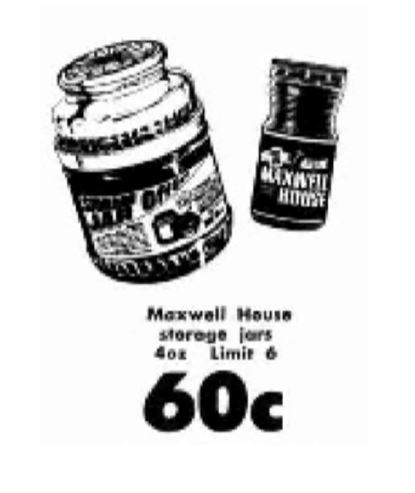
243 Cantarella submitted that this evidence establishes that other persons, trading in instant coffee and being actuated only by proper motives, will think of a jar of similar or identical appearance to the KDE shape mark and want to use it in connection with similar goods. Accordingly, Cantarella submitted, the KDE shape mark is not inherently adapted to distinguish the applicants’ goods.
244 Cantarella also drew attention to features of the KDE shape mark that it described as being “dictated by functional considerations”, including the shape’s round footprint, cylindrical body, lid with press seal, opening with a diameter smaller than the diameter of the shape’s body, lid indentations, and flat-topped lid. On the basis that these features were dictated by functional considerations, Cantarella submitted that these features did not contribute to the KDE shape mark’s capacity to distinguish the relevant goods.
Issue (1) — The applicants’ submissions on inherent adaptation to distinguish
245 In response, the applicants submitted that the KDE shape mark is a distinctive shape such that it is inherently adapted to distinguish the applicants’ coffee.
246 The applicants first relied on evidence of Professor O’Sullivan and Mr Blanket that packaging can and frequently does serve to distinguish the goods of one trader from those of another. From there, the applicants submitted that there are relatively few functional design requirements for packaging instant coffee, which leaves considerable design freedom. The applicants referred to the wide range of packaging used by traders in instant coffee to substantiate this point.
247 The applicants submitted that the industrial design experts agreed that a goal of industrial design is to create a design that is unique and memorable, and which stands out from other products in a given category. In that context, the applicants pointed to the evidence of Mr Simpson and Mr Francis that KDE’s shape mark possesses elements that are not functional, such as the shape of the lid and seal.
248 The applicants also relied on the evidence of Professor O’Sullivan suggesting that consumers rely on the shapes of instant coffee containers to distinguish between brands.
249 As for the evidence as to the Andronicus and Park Avenue jars, the applicants submitted that each of those products had been absent from the market for decades before the priority date. The applicants added that there was no evidence of any other trader using the combination of a cylindrical jar and a stopper lid in respect of coffee since 1995.
Issue (1) — Consideration: inherent adaptation to distinguish
250 In Chocolaterie Guylian NV v Registrar of Trade Marks [2009] FCA 891; 180 FCR 60 (Guylian) Sundberg J observed at [59] that: (1) the question whether a trade mark is inherently adapted to distinguish is directed at the nature of the trade mark itself and is not concerned with the mark’s capability to distinguish arising from its actual or intended use; and (2) that a trade mark that is inherently adapted to distinguish goods is one that can “do the job of distinguishing without first educating the public that it is a trade mark”, citing British Sugar plc v James Robertson & Sons Ltd [1996] RPC 281 (British Sugar) at 306 (Jacob J), also cited in Austereo Pty Ltd v DMG Radio (Australia) Pty Ltd [2004] FCA 968; 209 ALR 93 at [48] (Finn J).
251 The question whether a mark is adapted to distinguish was considered in the context of a word mark by Kitto J in Clark Equipment Co v Registrar of Trade Marks (1964) 111 CLR 511 (Clark Equipment), who stated at 514 that the question whether a mark is adapted to distinguish must –
be tested by reference to the likelihood that other persons, trading in goods of the relevant kind and being actuated only by proper motives—in the exercise, that is to say, of the common right of the public to make honest use of words forming part of the common heritage, for the sake of the signification which they ordinarily possess—will think of the word and want to use it in connexion with similar goods in any manner which would infringe a registered trade mark granted in respect of it.
252 In Cantarella Bros Pty Ltd v Modena Trading Pty Ltd [2014] HCA 48; 254 CLR 337 (Modena Trading) the majority at [31]–[59] traced the legislative history and the history of judicial interpretation of the requirement that a mark be adapted to distinguish, and explained and applied the “other traders” test referred to by Kitto J in Clark Equipment (see [63], [70]).
253 As noted by Sundberg J in Guylian at [61], the reference by Kitto J to the “likelihood” of use by another trader in connexion with similar goods was treated by Gibbs J in Burger King Corp v Registrar of Trade Marks (1973) 128 CLR 417 at 425 as equating to whether a trader “might” want to use the words in relation to his or her goods.
254 In Kenman Kandy Australia Pty Ltd v Registrar of Trade Marks [2002] FCAFC 273; 122 FCR 494 (Kenman Kandy) at [18], French J recorded that the parties to that appeal accepted that the statement of principle of Kitto J in Clark Equipment applied to shape marks. At [47]–[49], his Honour applied that statement, and other statements of principle to like effect, to the question whether the shape in question in Kenman Kandy was inherently adapted to distinguish the appellant’s confectionery from that of others. Stone J at [146] stated that there could be no doubt that Kitto J’s test would equally apply to shapes or other signs forming part of the common heritage.
255 Just as words, such as epithets or words of description or quality, may have functional purposes which render them incapable of being regarded as adapted to distinguish, so also may shapes. The cases show that, as with a word, there must be something “special” or “extra” added by a shape to the goods for the shape to function as a badge of origin: see Koninklijke Philips Electronics NV v Remington Products Australia Pty Ltd [2000] FCA; 100 FCR 90 (Remington) at [16] (Burchett J, Hill J and Branson J agreeing). In Kenman Kandy, a question that was considered was the extent to which a shape having functional features, being in that case the appellant’s confectionery, might be inherently adapted to distinguish the goods of one trader from another. At [137], Stone J stated –
The concerns expressed in both Philips v Remington (Aust), FC and Philips v Remington (Eng) about the prospect of trade marks creating monopolies related only to the registration of trade marks that would restrict access to functional features or innovations, and for this reason were well founded. It is this concern that finds expression in the requirement that a trade mark be something added to the inherent form of goods. The “inherent form” of goods, in my view, can only refer to those aspects of form that have functional significance. Were the 1995 Act to enable the registration of a trade mark that would give the owner a monopoly over functional features it would indeed have made a radical change to trade mark law. There is nothing in the 1995 Act or in the discussions that preceded it to suggest that this was intended.
256 French J at [45] agreed with Stone J’s analysis, and the above passage was cited with approval by the Full Court (Nicholas, Burley and Hespe JJ) in RB (Hygiene Home) Australia Pty Ltd v Henkel Australia Pty Ltd [2024] FCAFC 10; 302 FCR 285 (RB (Hygiene Home)) at [61].
257 For the following reasons, I consider that the KDE shape mark is not to any extent inherently adapted to distinguish KDE’s goods.
258 First, it is important to acknowledge that the KDE shape mark does not constitute the shape of the goods in respect of which it is registered. The applicants have not obtained registration of the shape of an instant coffee granule. This can be contrasted with Kenman Kandy, where the shape mark in question essentially captured the product itself — confectionery. The KDE shape mark, however, is the shape of a container. This has some significance when the principles that have been developed in the context of word marks are translated to shape marks. In British Sugar at 302, Jacob J used the word “Soap” as an example of a word that, when used in connection with soap, could never be distinctive. To adapt this to the context of a shape mark, Jacob J could equally have said that the shape of an unadorned bar of soap could never be distinctive of any brand of soap. The direct analogy with purely descriptive words is therefore the (purely functional) shape of the goods themselves.
259 Containers sit in a somewhat different category. But as Besanko J said in PepsiCo at [200], where a container contains “otherwise formless goods”, “one of the functions it performs is as a container”. Similar, but not identical, considerations thus apply to cases involving purely functional containers as in cases involving a shape that in fact constitutes the shape of the goods sold. Accordingly, as the authorities to which I have referred above would suggest, there must be something “extra” about the shape of the container to render it inherently adapted to distinguish.
260 As I have mentioned, it is only the shape that is registered as the KDE shape mark, and not the materials, or the colour, or any other attribute of the presentation of the container that might constitute a “sign” as defined by s 6(1) of the Act. The functional features of the shape of the container include that it is cylindrical, that it has an opening through which a spoon may be used to retrieve the coffee, and that it has a stopper-type lid.
261 The KDE shape mark does not, however, take a form that is entirely determined by functional considerations. In that respect, it is in a different position from a plain box, pouch, sachet, tube, tin, or carton. The KDE shape mark is also marked by some aesthetic features with no functional purpose. These features include the KDE shape mark’s relatively squat proportions, double-tiered lid, and the particular slope of the shoulder between the body of the container and the lid. These features — and in particular the upper profile of the KDE shape mark, including its lid — are superadded. A container whose form is dictated by functional considerations need not include any of these features.
262 I accept the joint evidence of the industrial design experts that, for glass jars, a round footprint is the commonest and most efficient to make. Their evidence also stated that having a “large cylindrical label area” is a common functional solution, because applying a label to a round jar is the simplest and most cost-effective method of labelling. Combining these observations, the experts opined that this left the possibility of using either a cylindrical or conical shape, but that using a conical shape would make it “very difficult” to provide sufficient volume while staying within other dimensional parameters, at least for a 400-gram product. The experts also stated that the diameter of the lid and opening of the jar were smaller than the diameter of the jar, and that this reflected a common functional requirement. Likewise, there was evidence that a flat-topped lid may have the functional benefit of being easier than other lids to stack and transport. In my view, it is clear that the KDE shape mark takes the form of a cylindrical jar with a flat-topped lid and an appropriately sized opening for functional reasons. Other features, such as the double-tiered lid, the shoulder, and what the experts called the “simple radius on the bottom edge” may serve more aesthetic purposes. In my view, these features are significant to the visual impression of the KDE shape mark as a whole.
263 Secondly, I accept that the KDE shape mark is reminiscent of other generic containers, and in particular the Kilner-branded storage jars which were referred to in the evidence of Mr Francis –
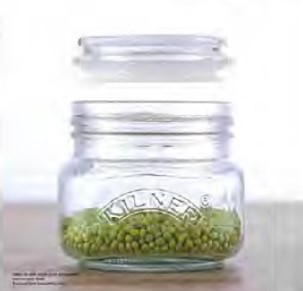
264 To a lesser extent, the shape of the opening and the lid of the KDE shape mark are reminiscent of food preserving jars, which are well known –
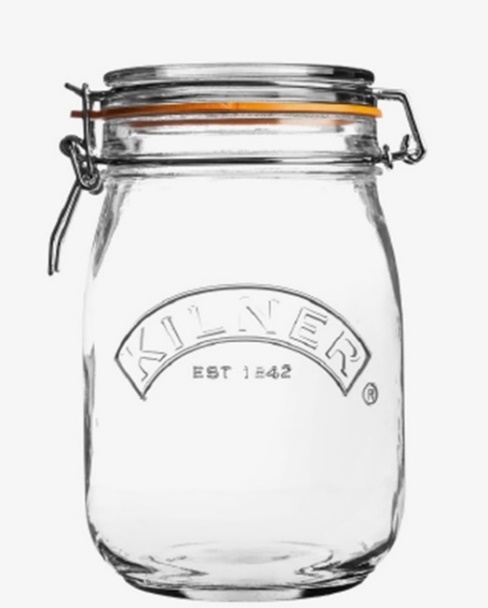
265 I find that there are some similarities between the grooves around the lid and below the opening of the preserving jar, and the corresponding grooves of the KDE shape mark, although the KDE shape mark does not have a wire closing mechanism, and has an internal seal instead of an externally visible rubber seal. In the words of the expert industrial designers, Mr Francis and Mr Simpson, I consider that the KDE shape mark retains some “visual language” from the food preserving jars. But it is important to note that there is no evidence of these Kilner jars being used by traders in relation to coffee or instant coffee.
266 Thirdly, there was the evidence of other similarly shaped containers in which Andronicus coffee and Park Avenue coffee were marketed and sold. Picking up Kitto J’s test in Clark Equipment at 514, in the case of Andronicus and Park Avenue coffee the evidence does not support a finding that the traders involved in their sale in the early 1980s and early 1990s, respectively, were actuated by improper motives in using jars that were similar to the KDE shape mark. In my view, this evidence establishes that the KDE shape mark is not inherently adapted to distinguish the applicants’ goods. Without taking account of any acquired distinctiveness, I consider that traders in coffee might for perfectly legitimate reasons seek to evoke the aesthetic of an old-fashioned jar in relation to their coffee by adopting a shape like that of the KDE shape mark.
267 In my view, all this evidence as to similarly shaped containers is also relevant in another way. It is relevant because it shows that even those features of the KDE shape mark that do play an aesthetic role still do not serve any inherently distinctive role. Rather, features such as the double-tiered lid and the shoulder of the jar serve to evoke a particular tradition, forming part of the common heritage. In other words: the KDE shape mark is both primarily functional and, to the extent that it is not functional, it draws on features of the common heritage that are not apt to distinguish the goods of any one trader.
Issue (1) — Use of the KDE shape mark as a trade mark
Issue (1) — Cantarella’s submissions on use of the KDE shape mark as a trade mark
268 Cantarella submitted that the applicants had not, by the priority date, used the KDE shape mark as a trade mark to such an extent that the trade mark did in fact distinguish the applicants’ coffee from that of other traders.
269 Cantarella emphasised that the task of establishing distinctiveness in fact for the purposes of s 41(3)(b) is “extremely difficult, and rarely achieved”. In support of this proposition, Cantarella referred to Jacob J’s statement in British Sugar at 306 that it is necessary for the mark to have “become accepted by a substantial majority of persons as a trade mark” such as to be “almost a household word”.
270 Cantarella submitted that evidence of the amount spent on marketing and promotion does not, in itself, provide a basis for establishing distinctiveness: see British Sugar at 302 (Jacob J). Cantarella submitted that this proposition was only strengthened when the mark has been used in conjunction with another, clear trade mark. In Cantarella’s submission, the name “Moccona” is such a mark, and this affects the degree to which use of the KDE shape mark would be understood to function to distinguish the applicants’ coffee.
271 Cantarella also submitted that it is necessary to show distinctiveness in fact in relation to the “specific shape” of the KDE shape mark, and that it would not be enough that this shape, recollected imperfectly, had acquired distinctiveness. On this topic, Cantarella referred to Professor O’Sullivan’s acceptance that consumers would only have such an imperfect recollection of the KDE shape mark.
272 As for the evidence of the Andronicus advertisement from 1981, Cantarella submitted that the issue for Lockhart J’s determination was an issue akin to identification in defamation, rather than one of factual distinctiveness. Cantarella submitted that, for this reason, Lockhart J’s statement in Stuart Alexander at 310 that “people who look at the television commercial would associate the first jar with Moccona instant coffee” did not advance the analysis.
273 Cantarella further emphasised that no use of the KDE shape mark is relevant to this question unless it amounts to use as a trade mark. For reasons including the alleged plainness of the jar, Cantarella submitted that the KDE shape mark had not been used as a trade mark. Cantarella submitted that Moccona advertisements did not present the jar as anything more than a container, and that no advertisement included an audio reference to the jar, which was in contrast to the audio references to “Moccona”.
Issue (1) — The applicants’ submissions on use of the KDE shape mark as a trade mark
274 The applicants submitted that to the extent that the KDE shape mark lacked any inherent adaptation to distinguish, the use of the shape, including extensive and sustained advertising, had the result that KDE had used the shape mark as a trade mark before 7 January 2014 to such an extent that by then it did distinguish the applicants’ coffee from that of other traders.
275 As for whether the KDE shape mark had been used as a trade mark at all, the applicants submitted that the striking features of the shape had to be taken into account. The applicants also submitted that it was not necessary for the shape of the jar to be the primary diagnostic tool used for the purpose of distinguishing the applicants’ coffee, which reduced the relevance of the fact that the KDE shape mark was used alongside established trade marks such as the word “Moccona”.
276 The applicants submitted that there had been sufficient use of the KDE shape mark as a trade mark to satisfy s 41(3)(b) on the basis of factors including –
(a) the length of time for which the shape had been used before the priority date, which the applicants submitted was extensive;
(b) the distinctiveness of the KDE shape mark, which the applicants submitted was recognised by Lockhart J in Stuart Alexander in 1981;
(c) the volume of sales of products in jars substantially the same as the KDE shape mark;
(d) how consistently the KDE shape mark had been used across a range of Moccona-branded instant coffee products; and
(e) the extensive advertising and promotion before the priority date that focused on the shape of the KDE shape mark.
Issue (1) — Consideration: Use of the KDE shape mark as a trade mark
277 The question whether a mark is inherently adapted to distinguish does not permit consideration of actual use of the mark. However, for the purposes of s 41(3) of the Trade Marks Act, consideration is to be given to actual use prior to the filing date. The s 41(3) inquiry involves questions of degree.
278 The heading to s 17 of the Act poses the rhetorical question, “What is a trade mark?” –
17 What is a trade mark?
A trade mark is a sign used, or intended to be used, to distinguish goods or services dealt with or provided in the course of trade by a person from goods or services so dealt with or provided by any other person.
Note: For sign see section 6.
279 Section 6(1) of the Act defines “sign” inclusively –
sign includes the following or any combination of the following, namely, any letter, word, name, signature, numeral, device, brand, heading, label, ticket, aspect of packaging, shape, colour, sound or scent.
280 Two things may be noted about the definition of “sign”. The first is that a sign includes a shape. The second is that a sign may include any combination of the elements referred to. The background to the introduction of shape marks in the 1995 Act has been referred to in other authorities: Koninklijke Philips Electronics NV v Remington Products Australia Pty Ltd [1999] FCA 816; 91 FCR 167 at [17]–[27] (Lehane J); Kenman Kandy at [42]–[44] (French J), [61] (Lindgren J), [141] (Stone J).
281 The registered KDE shape mark is the three-dimensional shape of a container that is depicted in the five line drawings on the Register. As I have noted, the materials from which the container is made form no part of the mark, nor does the colour, nor does the size. It is the shape of the container alone that has been registered. The mark contains the following endorsements –
Evidence provided under subsection 41(3).
Shape - The trade mark consists of the three-dimensional shape of a container as shown in the representations attached to the application form.
282 The requirement in s 17 that a trade mark “distinguish” goods directs attention to the purpose of the mark. The function of a trade mark is to indicate the origin of goods to which the mark is applied. Distinguishing goods of a registered owner from the goods of others and indicating a connection in the course of trade between the goods and the registered owner are thus the essential characteristics of a trade mark: E & J Gallo Winery v Lion Nathan Australia Pty Ltd [2010] HCA 15; 241 CLR 144 (E & J Gallo) at [42] (French CJ, Gummow, Crennan and Bell JJ).
283 Use “as a trade mark” is use as a “badge of origin” in the sense that it indicates a connection in the course of trade between goods and the person who applies the mark to the goods: Self Care IP Holdings Pty Ltd v Allergan Australia Pty Ltd [2023] HCA 8; 277 CLR 186 (Self Care) at [23] (Kiefel CJ, Gageler, Gordon, Edelman and Gleeson JJ); E & J Gallo at [43]. The question of use of a sign as a trade mark is assessed objectively and by reference to context: Self Care at [24]. A sign may have a dual function of being descriptive of goods as well as being a badge of origin: Self Care at [25]; RB (Hygiene Home) at [93] (Nicholas, Burley and Hespe JJ).
284 In Mayne Industries Pty Ltd v Advanced Engineering Group Pty Ltd [2008] FCA 27; 166 FCR 312 (Mayne), Greenwood J at [62] observed that, as with words that are merely descriptive of goods, “[w]here the trade mark comprises a shape which is demonstrated to involve a substantial functional element in the goods, references to the shape are almost certainly references to the nature of the goods themselves rather than use of the shape as a trade mark”. On the other hand, in Remington at [12] Burchett J gave as an example of a mark that is added so as to be something distinct from the goods liquid sold in a container “so formed as to constitute at once both container and mark”. Likewise, in PepsiCo, Besanko J at [200] remarked that the fact that a bottle performs the function of a container in which otherwise formless goods are held “does not, of itself, mean that the shape of the bottle cannot operate as a trade mark”. Besanko J further stated that “the fact that the shape of a bottle includes a decorative element does not mean the shape may not be used as a trade mark”, citing Adidas, where one of the questions was whether stripes on sports shoes having a decorative element might also be used as a trade mark.
285 In Global Brand Marketing Inc v YD Pty Ltd [2008] FCA 605; 76 IPR 161 (Global Brand), which concerned the use of the sole patterns of shoes as trade marks, Sundberg J at [61] referred to the authorities, including the Full Court’s decision in Coca-Cola Co v All-Fect Distributors Ltd [1999] FCA 1721; 96 FCR 107 (All-Fect), and helpfully summarised the principles in relation to the use of a shape as a trade mark as follows –
(a) A special shape which is the whole or part of goods may serve as a badge of origin. However the shape must have a feature that is “extra” and distinct from the inherent form of the particular goods: Mayne at [67], Remington at [16] and Kenman Kandy at [137].
(b) Non-descriptive features of a shape point towards a finding that such features are used for a trade mark purpose. Where features are striking, trade mark use will more readily be found. For example, features that make goods more arresting of appearance and more attractive may distinguish the goods from those of others: All-Fect at [25].
(c) Descriptive features, like descriptive words, make it more difficult to establish that those features distinguish the product. For example, the word COLA or an ordinary straight walled bottle are descriptive features that would have limited trade mark significance: All-Fect at [25] and Mayne at [61]–[62].
(d) Where the trade mark comprises a shape which involves a substantial functional element in the goods, references to the shape are almost certainly to the nature of the goods themselves rather than use of the shape as a trade mark: Mayne at [63]. For example, evidence that a shape was previously patented will weigh against a finding that the shape serves as a badge of origin: Remington at [12] and Mayne at [69].
(e) If a shape or a feature of a shape is either concocted compared to the inherent form of the shaped goods or incidental to the subject matter of a patent, it is unlikely to be a shape having any functional element. This may point towards the shape being used as a trade mark: Kenman Kandy at [162] and Mayne at [69].
(f) Whether a person has used a shape or a feature of a shape as a trade mark is a matter for the court, and cannot be governed by the absence of evidence on the point: All-Fect at [35].
(g) Context “is all important” and will typically characterise the mark’s use as either trade mark use or not: Remington at [19] and Mayne at [60]–[62].
286 Sundberg J then stated –
[62] As is apparent from the foregoing propositions, a shape mark case may require consideration of different types of features in determining whether the mark is used as a trade mark for the purposes of the Act. At one end of the spectrum are shapes or features thereof that are purely functional. The features may have derived substantially from a patented product, such as the S-shaped fence dropper, or go to the usefulness of the product: Remington at [3] and [12]. Cases such as Mayne and Remington show that such features point away from trade mark use.
[63] At the other end of the spectrum are those features of a mark that are non-descriptive and non-functional. They ordinarily make the shape more arresting of appearance and more attractive, thus providing a means of distinguishing the goods from those of others. All-Fect and Remington show that non-functional features add something extra to the inherent form of the shape. A concocted feature will typically be considered non-functional: Kenman Kandy.
[64] Finally, there will be cases, such as the present, that fall between the ends of the spectrum. These cases are not black and white. They involve consideration of whether one set of features supersedes, submerges or overwhelms the other.
287 This summary was referred to with approval by Besanko J in PepsiCo at [201].
288 It has been recognised that goods may be sold in a container so formed as to constitute at once both container and mark: Remington at [12] (Burchett J). However, it does not follow that consistent use of a container will constitute the use of its shape as a mark. More is required, in that the shape of the container must be used to distinguish the goods from those of other traders.
289 A trader may use concurrently more than one sign as a trade mark in relation to goods. Where more than one sign is used in combination, the dominance of one sign may affect the assessment of the effect of the others, but does not mean that the other signs cannot also act to distinguish the goods: Self Care at [25], citing Anheuser-Busch at [191] (Allsop J). Thus, the dominance of one sign may have the effect that other features are not, on an objective assessment, used to indicate origin. In the present case, one of the issues that arises is whether there was a dominant use of the “MOCCONA” logo on the applicants’ jars such that the shape of the jar was not used as a trade mark to distinguish the goods.
290 In considering the question of use, it is to be borne in mind that mere use is not the same as use as a trade mark. To adapt the analysis of Jacob J in British Sugar at 302, one must be careful before concluding that mere use, however substantial, of a functional container denotes the mark of a particular trader, particularly when it is used in conjunction with another sign that is obviously a trade mark. At least to some extent, that is the position here. The evidence showed that the KDE shape mark was commonly used in conjunction with the registered word mark, “MOCCONA”, and its logo. In the television and YouTube advertising showing jars without labels, the Moccona name appeared visually, audibly or both at some point during the advertisements. On the other hand, the fact that the registered word mark “MOCCONA” and its logo was used as a mark on the jars and in advertising does not preclude the possibility that the KDE shape mark was also used as a mark, even if it was not the dominant mark. Any dominance of the “MOCCONA” word mark is relevant to the question of degree whether the KDE shape mark was used to distinguish the goods.
291 The ultimate question is whether, as Kitto J put it in Clark Equipment at 515, the applicants’ use of the KDE shape mark as a trade mark means that the KDE shape mark “has come to possess, when used in respect of the relevant goods, a distinctiveness in fact which eclipses its primary signification”.
292 I do not accept Cantarella’s claim that the KDE shape mark did not acquire, in relation to coffee and instant coffee, a distinctiveness in fact in this sense prior to the priority date. My reasons are as follows.
293 First, the coffee products that were depicted in evidence before the Court came in a range of containers. These containers ranged from those of the most plain variety, namely tins of International Roast, Bushells, and Nescafé Blend 43. There were also jars of coffee with plastic lids having a plain appearance. There were other jars of coffee with more ornate, distinctive shapes, namely the jars of Robert Timms and Nescafé Blend 43. Amongst all the containers of coffee, the Moccona jars using the KDE shape mark are aesthetically distinct. As I have alluded to, the most notable characteristics are at the upper level of the sealed jar, involving the combination of the shoulder, the opening of the jar, and the stopper lid, which are depicted in the visual representation of the shape recorded on the Register.
294 Secondly, the 1981 Andronicus advertisement is relevant to the question whether the KDE shape mark in fact operated to mark out the coffee of the applicants from that of other traders. I have described that advertisement at [131]–[138] above. Of particular significance is the opening shot –

295 As I have already noted at [138], Lockhart J found at 310 of Stuart Alexander that “people who look at the television commercial would associate the first jar with Moccona instant coffee”, based on the evidence of witnesses along with other evidence. As I will explain, I would make the same association on the basis of the evidence in this case of other uses before the priority date. This association may derive, in part, from factors other than the appearance of the jar itself. But the fact that this association is made despite the visually unadorned appearance of the stark, unlabelled jar leads me to accept the applicants’ submission that this is an indication that, by as early as 1981, the shape of the Moccona jar was capable of functioning as a signal of the trade origin of Moccona coffee.
296 It is important to clarify that I do not attribute weight to this evidence on the footing that it represents relevant use of a jar in the form of the KDE shape mark for the purposes of s 41(3)(b). For one thing, the advertisement in question was in fact produced by a trade competitor of the applicants’ corporate group. Moreover, the evidence was that JDE AU came to be responsible for the marketing and distribution of Moccona coffee in Australia in 1992. There was little evidence about which entities would be capable, before this date, of using the mark in the relevant way. The significance that I see in the evidence of events before 1992 goes to the acquired capacity of the KDE shape mark to mark out the trade source of Moccona-branded coffee. This acquired capacity then provides the contextual starting point from which to judge whether use by JDE AU between 1992 and the priority date satisfies the requirements of s 41(3)(b). I will explain later, from [316] onwards, why I consider that JDE AU’s use of the KDE shape mark during this time is relevant to this question.
297 Thirdly, there was no evidence that any other trader had used the shape comprising the KDE shape mark in relation to coffee products after its use in relation to the Park Avenue product in the first half of the 1990s. There was, therefore, a period of almost 20 years before the priority date during which it is likely that the applicants were the only users of the shape in Australia in relation to coffee.
298 Fourthly, and in this context, the history of Moccona advertisements before the priority date that feature the KDE shape mark prominently is significant.
299 The “Cinderella” advertisement from 2008 focuses keenly on the shape of the Moccona jar, including its lid. The unlabelled lid of the jar appears several times over the course of the advertisement as the man searches for the “Cinderella” jar into which it fits. Until 50 seconds into the minute-long advertisement, no Moccona label, logo or jar is featured. Now, it is true that a voice says the word “Moccona” towards the very end of the advertisement, that the “Cinderella” jar bears a Moccona label, and that a labelled Moccona jar is featured in the final shot. In my view, however, this does not swamp the significance of the jar itself. The advertisement is premised on the idea that there are many brands of coffee, but that one way of identifying Moccona coffee is to use the lid along with the jar into which it fits. While the Moccona logo and the spoken word “Moccona” are undoubtedly used as trade marks in the advertisement, it is notable that the lid alone is the focus of the majority of the advertisement. Consumers are being asked to consider the lid of the Moccona jar and to conclude that the lid and jar distinguish Moccona coffee from the other brands of coffee featured in the advertisement. This is especially significant considering that the jar is used to distinguish before the word “Moccona” appears or is spoken. This advertisement contributes to my finding that the jar has been used as a trade mark.
300 The “Candles” advertisement from around 2010 also emphasises the shape of the Moccona jar — this time, the body of the jar more than the lid. I cannot view this advertisement simply as suggesting a use for an empty Moccona jar. Rather, the images of the empty Moccona jar (without its lid) on the setts of the street emphasise that viewers should take the shape of the jar as marking out Moccona coffee. Viewed objectively, one of the functions performed by the jar in the “Candles” advertisement is communicating that the shape of the jar marks out Moccona coffee from the coffee of other trade sources. This is so despite the fact that labelled jars of Moccona, as well as the Moccona logo itself, appear elsewhere in the advertisement.
301 The “Keepsakes” advertisement from 2011 emphasises the shape of the Moccona jar yet further. In this advertisement, the body of the jar and the lid are both displayed prominently without a Moccona label. Again, the Moccona label is featured over the course of the advertisement. But one purpose of featuring the unlabelled shape of the jar is to draw attention to the shape of the jar, so as to present the jar to consumers as a means of identifying Moccona coffee. Similar observations can be made about the 2012 version of “Keepsakes”.
302 As I understood it, Cantarella also contended that the use of other trade marks in the advertisements, such as the Moccona logo and the word “Moccona”, diminished the likelihood of the shape of the jar being regarded as a brand. In this context, Cantarella relied upon the fact that all Moccona jars are sold with a large label affixed to them, featuring the Moccona name and logo, which Cantarella sought to characterise as “dominant”. This submission sought to engage with the statement of Kiefel CJ, Gageler, Gordon, Edelman and Gleeson JJ in Self Care at [25] that “[w]here there are several words or signs used in combination, the existence of a clear dominant ‘brand’ is relevant to the assessment of what would be taken to be the effect of the balance of the label, but does not mean another part of the label cannot also act to distinguish the goods”. The submission also drew on the Court’s statement in Self Care at [56], that went to the findings of fact in that case, that –
[o]f particular significance was that the phrase “instant Botox® alternative” appeared alongside two clear badges of origin … This diminishes the likelihood that the phrase “instant Botox® alternative” could be objectively understood to indicate origin in itself. This is because its use was not as dominant as the use of the other signs …
(Emphasis added, citations omitted.)
303 In my view, however this analysis may play out in relation to the jar as it appears on the shelf of a supermarket, it does not advance Cantarella’s case in relation to the advertisements. For the reasons I have explained, the jar shape was used as a trade mark in the advertisements to which I have referred above, and the use of the Moccona logo and name were not so dominant as to swamp the prominence of the jar, and its use as a mark.
304 Nor do I consider that other advertisements, which feature Moccona packaging other than the jar itself, gainsay this conclusion. The question is whether the KDE shape mark, in the form of the Moccona jar, had been used as a trade mark before the priority date. If the jar were always shown alongside forms of packaging that were plain and not distinctive, such as tins or soft packs, the submission would have some force. As the facts stand, however, the applicants have singled out the Moccona jar for special attention in their marketing activities. They have done so to emphasise the shape of the jar with the objective purpose of using it as a badge of origin. The fact that, on other occasions, the applicants have not sought to single out the shape of the jar does not rob the shape of the jar of the character of a brand, which it has acquired through the applicants’ use.
305 For completeness, I also note that Cantarella did not seek to submit that the shape of the Moccona jar is used in the advertisements as part of a composite mark consisting of the jar shape and the glass material. This would have raised other issues, on which the applicants would, no doubt, have sought to lead evidence and make submissions. I have confined my analysis to the question whether the jar shape was used as a trade mark, irrespective of the material from which it was manufactured.
306 For these reasons, I consider that use of the shape of the Moccona jar as a trade mark before the priority date was so extensive as to eclipse the ordinary signification of that shape in respect of coffee. I have already expressed my conclusion that the KDE shape mark is not, in itself, inherently adapted to distinguish the applicants’ coffee from that of other traders. But from when the Andronicus advertisement was broadcast in 1981, the applicants developed a significant association between their coffee products and the jar shape in which those products were sold. In the two decades immediately preceding the priority date, there were no competitors using jars that were apt to detract from the effectiveness of this use as a badge of origin. That provides the context in which the advertisements described above must be understood. Especially by means of those advertisements, which I find to have been extensive given the amount of revenue spent on advertising that was the subject of confidential evidence, the applicants clearly deployed the KDE shape mark as a badge of origin in the last decade before the priority date. In all of the circumstances, I consider that this amounted to such significant use of the KDE shape mark as a badge of origin before the priority date as to satisfy the test of use under s 41(3)(b).
Issue (2): Should the KDE shape mark be cancelled on the ground that, as at the priority date, KDE did not intend to use or authorise the use of the KDE shape mark in Australia as a trade mark in relation to instant coffee?
307 Under s 59 of the Act, registration of a trade mark may be opposed on the ground that the applicant does not intend to use, or authorise the use of, the trade mark in Australia in relation to the goods or services specified in the application. Cantarella relies on this ground in further support of its claim that the Court should order under s 88 of the Act that the Register be rectified by cancelling the KDE shape mark from the priority date. It is not in issue that the KDE shape mark has been used as a functional container in which instant coffee has been packaged. The focus of this ground is use or intended use of the KDE shape mark as a trade mark.
308 I have already explained my conclusion that, as at the priority date, the KDE shape mark was capable of operating, and in fact did operate, as a badge of origin in relation to the applicants’ coffee goods. It follows from this conclusion, together with what I have to say about the question of authorised use from [316] onwards, that Cantarella cannot succeed on this aspect of its cross-claim. As at the priority date, KDE intended to authorise, and did authorise, JDE AU to use the KDE shape mark as a trade mark.
Issue (3): Should the KDE shape mark be removed from the Register on the ground that at no time in the period of three years prior to the filing of the cross-claim did KDE use the KDE shape mark in Australia as a trade mark in relation to instant coffee?
309 As I have explained, Cantarella’s cross-claim also sought an order pursuant to s 92 of the Trade Marks Act that the Register be rectified by removing the KDE shape mark.
310 Viewed in the context of s 92 generally, s 92(4) provides –
92 Application for removal of trade mark from Register etc.
(1) Subject to subsection (3), a person may apply to the Registrar to have a trade mark that is or may be registered removed from the Register.
…
(4) An application under subsection (1) or (3) (non-use application) may be made on either or both of the following grounds, and on no other grounds:
(a) that, on the day on which the application for the registration of the trade mark was filed, the applicant for registration had no intention in good faith:
(i) to use the trade mark in Australia; or
(ii) to authorise the use of the trade mark in Australia; or
(iii) to assign the trade mark to a body corporate for use by the body corporate in Australia;
in relation to the goods and/or services to which the non-use application relates and that the registered owner:
(iv) has not used the trade mark in Australia; or
(v) has not used the trade mark in good faith in Australia;
in relation to those goods and/or services at any time before the period of one month ending on the day on which the non-use application is filed;
(b) that the trade mark has remained registered for a continuous period of 3 years ending one month before the day on which the non-use application is filed, and, at no time during that period, the person who was then the registered owner:
(i) used the trade mark in Australia; or
(ii) used the trade mark in good faith in Australia;
in relation to the goods and/or services to which the application relates.
311 Cantarella put its claim for removal under s 92 on two bases, seeking to engage s 92(4)(a) and s 92(4)(b), respectively –
(1) first, pursuant to s 92(4)(a) of the Act, Cantarella claimed that the KDE shape mark should be removed because: (a) on the day on which the application for registration was filed, KDE had no intention in good faith to use the shape mark in Australia as a trade mark (or to authorise or assign the use of the mark); and (b) KDE had not used (or not used in good faith) the shape mark in Australia at any time before the period of one month ending on 24 March 2023, being the date on which Cantarella filed its notice of cross-claim; and
(2) secondly, pursuant to s 92(4)(b) of the Act, Cantarella claimed that the KDE shape mark should be removed because it had remained registered for a continuous period of three years ending one month before 24 March 2023 and at no time during that period had KDE used the shape mark in Australia (or used it in good faith) in relation to the goods to which it relates.
312 With respect to KDE’s intention to use the shape mark as a trade mark, Cantarella reiterated the submissions it made in connection with issue (2). Cantarella submitted that the references in s 92(4) of the Act to use necessitate use as a trade mark, being use of a sign to distinguish goods or services dealt with or provided in the course of trade by a person from goods or services so dealt with or provided by any other person. Cantarella submitted that “[u]se ‘as a trade mark’ is use of the mark as a ‘badge of origin’ in the sense that it indicates a connection in the course of trade between goods and the person who applies the mark to the goods”, relying on E & J Gallo at [43], quoting All-Fect at [19] (Black CJ, Sundberg and Finkelstein JJ).
313 Section 92(4)(a) and s 92(4)(b) both direct attention to whether KDE used the shape mark as a trade mark in Australia. The two sections, however, call for an assessment of trade mark use at different times. Under s 92(4)(a)(iv), the question is whether KDE used the shape mark at any time before the period of one month ending on 24 March 2023 — that is, at any time on or before 24 February 2023. The relevant period under s 92(4)(b) is the period of three years running from 25 February 2020 to 24 February 2023.
314 Cantarella submitted that KDE has never used the shape mark as a trade mark, because it has never used the shape of its jars to distinguish its goods from the goods of other traders. Cantarella also submitted that the evidence did not establish that JDE AU is, or at any relevant time has been, an authorised user in Australia of the shape mark, and so the applicants cannot rely on any use of the shape mark by JDE AU as constituting use by KDE.
315 The way Cantarella put its case results in two questions for the Court: (1) was any use of the shape mark by JDE AU an “authorised use”; and (2) was the shape mark used as a trade mark?
Issue (3) — Was any use of the shape mark by JDE AU an “authorised use”?
316 The first question is whether and when JDE AU has been an authorised user of the shape mark. This question comes first because s 92(4) of the Trade Marks Act is concerned with use of registered trade marks solely by their registered owners. If JDE AU has been an authorised user of the shape mark, then its authorised use of the shape mark can be attributed to KDE as the registered owner. That is because s 7(3) provides that “[a]n authorised use of a trade mark by a person … is taken, for the purposes of this Act, to be a use of the trade mark by the owner of the trade mark”.
317 The terms “authorised user” and “authorised use” have the meanings given by s 8, which provides –
8 Definitions of authorised user and authorised use
(1) A person is an authorised user of a trade mark if the person uses the trade mark in relation to goods or services under the control of the owner of the trade mark.
(2) The use of a trade mark by an authorised user of the trade mark is an authorised use of the trade mark to the extent only that the user uses the trade mark under the control of the owner of the trade mark.
(3) If the owner of a trade mark exercises quality control over goods or services:
(a) dealt with or provided in the course of trade by another person; and
(b) in relation to which the trade mark is used;
the other person is taken, for the purposes of subsection (1), to use the trade mark in relation to the goods or services under the control of the owner.
(4) If:
(a) a person deals with or provides, in the course of trade, goods or services in relation to which a trade mark is used; and
(b) the owner of the trade mark exercises financial control over the other person’s relevant trading activities;
the other person is taken, for the purposes of subsection (1), to use the trade mark in relation to the goods or services under the control of the owner.
(5) Subsections (3) and (4) do not limit the meaning of the expression under the control of in subsections (1) and (2).
318 The applicants advanced two arguments in support of the claim that JDE AU is, and has been, an authorised user of the shape mark –
(1) first, the applicants relied on s 8(3) and submitted that KDE, as the owner of the shape mark, had exercised quality control over the goods dealt with or provided in the course of trade by JDE AU in relation to which the shape mark was used; and
(2) secondly, the applicants submitted that, for the purposes of ss 8(1) and (5), JDE AU had otherwise used the shape mark in relation to goods under KDE’s control pursuant to a “unity of purpose” between KDE and JDE AU in relation to use of the shape mark.
319 With respect to quality control, the applicants submitted that the evidence established that KDE has manufactured and supplied to JDE AU instant coffee in jars in the shape of the shape mark for distribution in Australia. The mere fact that KDE has supplied those goods bearing the shape mark to JDE is alone sufficient, it was submitted, to demonstrate that KDE has exercised quality control over those goods.
320 Cantarella submitted that there was no evidence that KDE controlled or authorised the manufacture of the jars in which Moccona coffee sold in Australia during the non-use claim period was stored. Rather, Cantarella submitted, the evidence merely showed that there is a factory for “the freeze-dried coffee” in Joure.
321 I am satisfied that within the relevant periods KDE exercised quality control over goods dealt with in the course of trade by JDE AU, in relation to which the shape mark has been used. I will set out the key evidence supporting my conclusion, which arises as a matter of inference from circumstantial evidence, that the requisite quality control existed –
(1) In evidence was a Business Register extract from the Netherlands Chamber of Commerce in respect of KDE, dated 5 April 2023. That extract lists “Leeuwarderweg 1, 8501ZD Joure” as the “[v]isiting address” of an “[e]stablishment” of KDE.
(2) Also in evidence were packing lists and invoices relating to the sale of Moccona coffee products from KDE to JDE AU, and their shipment from the Netherlands to Australia. The invoices were in similar form, and included an invoice dated 2 March 2020, with a delivery date of 27 April 2020 which was within the non-use claim periods. While KDE is identified as the “[v]endor” on those invoices, the “[s]hipping [p]oint [a]ddress” appears as “JACOBS DOUWE EGBERTS NL BV Leeuwarderweg 1 8501 ZD Joure”. I understand this to mean that the goods the subject of the invoice were, or were to be, shipped from the Joure address. This inference is supported by the terms of freight that are identified on the invoices, which relevantly state –
Incoterms: FCA JDE NL Coffee Factory Joure
(3) With reference to a packing list and an invoice dated 26 January 2024, Ms Armstrong identified the Joure address as the factory from where JDE AU’s freeze-dried coffee comes.
(4) In evidence was a Business Register extract from the Netherlands Chamber of Commerce in respect of “JACOBS DOUWE EGBERTS NL BV” (JDE NL BV), dated 19 February 2024. The extract identifies the activities of this company to be the “[p]rocessing of tea and coffee”. The visiting address of an establishment of JDE NL BV is the same Joure address identified above. The sole shareholder of the company is identified as KDE.
322 This evidence allows me to draw the following conclusions in circumstances where there was no contradictory case advanced by Cantarella, which put the applicants to their proof. The Joure address is the address of a factory that manufactures coffee products, including coffee products that are sold under the Moccona brand in Australia. JDE NL BV is the entity responsible for “[p]rocessing” or manufacturing those coffee products. JDE NL BV is a wholly owned subsidiary of KDE. The factory at Joure is an establishment of both JDE NL BV and KDE. The coffee products manufactured there likely become the property of KDE, which in turn sells them to JDE AU as vendor. In light of all this, I consider it safe to infer that JDE NL BV manufactures Moccona products at the Joure factory under the control (including the quality control) of KDE. There being no evidence to the contrary, I also infer that KDE exercised this quality control during at least some of the three-year period ending on 24 February 2023.
323 Further, with respect to Cantarella’s submission that there was no evidence that KDE controlled or authorised the manufacture of the jars in which Moccona coffee was sold in Australia, I accept the applicants’ submission that this is not relevant. The question posed by s 8(3) is whether “the owner of a trade mark exercises quality control over goods or services” in relation to which a trade mark is used. Having regard to the registration of the KDE shape mark in this case, s 8(3) will be satisfied if KDE exercised quality control over the coffee or instant coffee in relation to which the shape mark was used. It is not to the point whether KDE oversaw the manufacture of the glass jars in which the coffee was sold.
324 For these reasons, I accept the applicants’ submission that s 8(3) of the Act applies, such that JDE AU was for the relevant periods an authorised user of the shape mark. Having regard to the considerations set out above, I also consider that JDE AU’s use of the shape mark occurred as part of an integrated scheme for the importation and sale of coffee produced under the control of KDE, using KDE’s shape mark and other intellectual property. On that basis, I find that JDE AU’s use of the shape mark has occurred under the control of KDE for the purposes of s 8(2). As a result, I conclude that, to the extent JDE AU has used the shape mark as a trade mark, that use must be taken to be KDE’s trade mark use, by force of s 7(3).
325 The applicants also submitted that — deeming provisions such as s 8(3) aside — JDE AU has used the shape mark under the control of KDE, within the meaning of ss 8(1)–(2) of the Act. The facts relied upon to support this submission overlapped with those to which I have already referred. Still, the applicants put this as an independent basis on which the Court should find that JDE AU was an authorised user of the shape mark. Consequently, I will consider this submission separately.
326 KDE and JDE AU are related entities, in the informal sense I have already explained. Neither, however, is a subsidiary of the other. The applicants put their s 8(1) case on the basis that there was a “unity of purpose” between KDE and JDE AU. This submission sought to engage the principles referred to by the Full Court in Trident Seafoods Corp v Trident Foods Pty Ltd [2019] FCAFC 100; 143 IPR 1 (Trident). The applicants submitted that where a unity of purpose in relation to the use of the mark can be inferred, it is unnecessary to point to any particular illustration of actual control for s 8(1) to be engaged.
327 The applicants emphasised the following circumstances as evidencing this unity of purpose –
(1) KDE and JDE AU are members of the same corporate group, and both are owned by the same ultimate holding company;
(2) all of the Australian entities in that wider corporate group have the same directors and are treated within the business as one group;
(3) there is (now) an express licence in relation to the use of the Moccona marks (including the shape mark) from KDE to JDE AU’s parent company, DE Investments Australia Pty Ltd; and
(4) all of the products sold by JDE AU “in the jar” are supplied by KDE.
328 Cantarella submitted that the Court should reject the applicants’ argument as to a unity of purpose for several reasons. The first was that the crucial factor in Trident was identified by Reeves, Jagot and Rangiah JJ at [45] as being “that at all relevant times the two companies [in question] had the same directors”, whereas KDE and JDE AU have no common directors. The second reason was that KDE and JDE AU are not directly related, but rather are themselves each owned by different companies within a larger corporate group, and that this lack of direct corporate relationship makes it more difficult to find that any unity of purpose exists. The third reason was that an inference of unity of purpose is inconsistent with the actual legal arrangements entered into by KDE, because KDE granted an exclusive licence to DE Investments Australia Pty Ltd. The result of this was said to be that KDE placed itself in a position whereby it could not, without formal prior written approval, act with a unity of purpose with JDE AU, because DE Investments Australia Pty Ltd was the exclusive licensee. It was further submitted that the Court ought not infer conduct which would be contrary to the express terms of the licence agreement in question.
329 To explain my conclusion on this question, it is necessary to pay close attention to the Full Court’s decision in Trident. Trident Foods Pty Ltd (Trident Foods) was the registered owner of two trade marks used in relation to food: Trident at [6] (Reeves, Jagot and Rangiah JJ). From about 2000, all food sold under the marks had been sold by Manassen Foods Australia Pty Ltd (Manassen): Trident at [6]. Trident Foods was a wholly owned subsidiary of Manassen: Trident at [6]. One issue on the appeal was whether the use of the “TRIDENT” mark by Manassen was authorised by Trident Foods, so that use by Manassen was use by Trident Foods: Trident at [44]. The primary judge concluded that Manassen’s use of the mark had not occurred “under the control of” Trident Foods for reasons including: (a) that the corporate relationship between the two meant that Manassen was in a relationship of control over Trident Foods; and (b) that there was no evidence of “any particular illustration of conduct by Trident Foods amounting to actual control” of the use of the mark. On appeal, Reeves, Jagot and Rangiah JJ held at [45] that “[t]he issue [was] not whether one company controlled the other but rather whether Trident Foods, even though a wholly owned subsidiary of Manassen, had control over Manassen’s use of the trade marks”. Their Honours considered it significant that Trident Foods and Manassen had the same directors: Trident at [45]. On that basis, the Full Court stated at [45] –
It must be inferred from the evidence that the two companies operated with a unity of purpose. Trident Foods held the trade marks. Manassen sold the products under the TRIDENT brand and thereby used the trade marks. … As directors of Trident Foods, the directors had obligations to ensure the maintenance of the value in the marks. To that end Trident Foods necessarily controlled Manassen’s use of the marks by reason of the simple fact that it owned the marks and its directors, who were also Manassen’s directors, must have had one common purpose, being to maximise sales and to enhance the value of the brand. This is not a case like Lodestar in which there was no relationship between the owner and user of the marks beyond a licence. This case is at the other end of the spectrum. As Trident Foods submitted, it is commercially unrealistic in the circumstances of the present case not to infer that the owner of the marks controlled the use of the marks because the common directors necessarily wished to ensure the maintenance and enhancement of the value of the brand.
330 Their Honours described at [46] the lack of any “illustration of actual control” as “not surprising given the corporate relationship, the commonality of directors and the shared processes between the owner and the user of the marks”. Rather, “[t]he natural and ordinary inference given the relationship between the companies would be of unity of purpose, rendering redundant any particular illustration of … actual control”: Trident at [46]. The relevant conclusion at [46] was that “[u]nity of purpose is indicative of the existence of actual control vested in … the entity owning the marks over … the entity using the marks”.
331 I respectfully consider the Full Court’s reasoning relevant to the present case. I will point out some of its features. First, the conclusion that Trident Foods and Manassen shared a “unity of purpose” was expressly couched as an inference from the evidence. It is plainly a question of fact. The inference in Trident was justified on the basis of three key facts: the corporate relationship, the commonality of directors, and the shared processes between the owner and the user of the marks. Commonality of directors — which does not exist in this case — was indeed a significant factor. It is worth noting, however, that the Full Court emphasised that fact while addressing the primary judge’s statement that “[t]he commonality of directors does not, without more, permit Trident Foods to exercise control over Manassen”: see Trident at [44]. I therefore do not accept that commonality of directors has a determinative significance in every case. Ultimately, the principle that emerges from Trident is that unity of purpose with respect to the use of a mark is indicative of actual control of the use of the mark by the owner. The circumstances in which unity of purpose may be inferred will vary from case to case.
332 In this case, I consider that a unity of purpose did exist between KDE and JDE AU in the relevant sense.
333 I have already explained the corporate structure within which the applicants sit. The upshot is that KDE and JDE AU are both owned, immediately and mediately respectively, by the same Dutch company. They both form part of the same corporate group that is involved in carrying on a global coffee and tea business. The evidence was that KDE owns several Moccona-related trade marks that are used in connection with the sale and marketing of Moccona-branded products in Australia. As Cantarella points out, KDE entered into a licence agreement in 2019 with DE Investments Australia Pty Ltd relating to these Moccona-related trade marks. DE Investments Australia Pty Ltd is the sole shareholder of JDE AU.
334 There are several links in the chain of corporate relationships that joins KDE to JDE AU, but it is none the weaker for that. Both companies form part of an integrated corporate group engaged in the ownership and management of a coffee and tea business. While these particular companies may have no directors in common, it remains the case that there was for much of the three-year period until 24 February 2023 an overlap between the directors of JDE AU and DE Investments Australia Pty Ltd, which entered into the licence agreement with KDE. I infer that the coherent use of KDE’s Moccona trade marks was a matter of significance to the global coffee business of which KDE and JDE AU form part.
335 Indeed, the evidence of Mr Tillman established that KDE “defines the global principles” relating to how JDE AU develops and executes “all of its creative assets and media”. KDE also “issues brand guidelines” relating to the Moccona brand, including how the glass jar is displayed. JDE AU is also “required” to obtain KDE’s “sign-off” before commissioning “any new key communication asset in Australia”, which must also be approved once completed. Read fairly, Mr Tillman’s evidence shows that JDE AU is expected to, and does, obtain KDE’s authorisation in relation to at least some of KDE’s intellectual property, including the shape mark. In my view, this dynamic plainly supports the view that KDE and JDE AU were expected to, and did, act with a unity of purpose in deploying the intellectual property owned by KDE as part of a broader global group. Even further, Mr Tillman’s evidence supports the conclusion that KDE did, in fact, exercise actual control over JDE AU’s use of the KDE shape mark in Australia.
336 I reject Cantarella’s submission that the existence of the licence agreement between KDE and DE Investments Australia Pty Ltd means that unity of purpose between KDE and JDE AU should not be inferred. DE Investments Australia Pty Ltd is the parent company of JDE AU, and over much of the relevant period the two companies shared the same directors. Given what I have inferred about the purpose shared between KDE and JDE AU, I consider the commonality of directors between JDE AU and DE Investments Australia Pty Ltd to be significant. I am persuaded that DE Investments Australia Pty Ltd was engaged in the same common purpose as KDE and JDE AU. In light of this, I see no reason why the licence agreement should stand in the way of the finding that KDE exercised control over JDE AU’s use of the KDE shape mark in Australia.
337 For these reasons, I conclude that KDE did, in fact, control JDE AU’s use of the KDE shape mark in Australia. I reach this conclusion based in part on Mr Tillman’s direct evidence, and in part on the fact that KDE and JDE AU are related companies acting in concert pursuant to a unity of purpose. I therefore also accept the applicants’ submission that any use of the shape mark by JDE AU is to be attributed to KDE through the direct application of the “actual control” criterion in s 8(1).
338 As a result, I find that relevant trade mark use by JDE AU amounts to “authorised use” for the purposes of s 8(2), and therefore to use by KDE pursuant to s 7(3).
Issue (3) — Use of the KDE shape mark as a trade mark
339 As I have indicated, Cantarella put in issue whether the applicants had used the KDE shape mark as a trade mark. One way in which the applicants submitted that the shape mark had been used as a trade mark in Australia was to point to the series of Moccona advertisements featuring glass jars. In this context, the applicants drew particular attention to advertisements that featured jars in the shape of their mark that did not contain instant coffee or bear the word mark “Moccona”.
340 It is important to note Cantarella’s threshold submission that none of the advertisements can assist in rebutting the non-use claim because they did not constitute use by KDE. The factual premise of this submission was that all alleged website, video advertising, and social media use of the shape mark was use by JDE AU. Even assuming that factual premise to be correct, it follows from my finding at [338] that any such use by JDE AU constitutes use by KDE. I therefore reject Cantarella’s threshold submission on this issue. If the advertisements in question constitute use by KDE or JDE AU of the shape mark as a trade mark in the relevant period, then the respondent’s non-use claim fails.
341 Timing poses another preliminary issue. As I have noted, the two limbs of s 92(4) deal with different periods of time. Removal under s 92(4)(a) is not possible if the trade mark has been used at any time on or before 24 February 2023. Removal under s 92(4)(b) is not possible if the trade mark has been used between 25 February 2020 and 24 February 2023. In this case, however, nothing turns on this difference. I accept the submission of the applicants that the sustained deployment of the KDE shape mark as a badge of origin has resulted in the shape mark being used as a trade mark every time a Moccona product is offered for sale in a jar in the form of the shape mark. It is not necessary to consider whether simply offering Moccona products for sale in the relevant jar would amount to trade mark use without more. Because the shape of the jar has, however, acquired the capacity to distinguish, and does in fact distinguish, Moccona coffee from the coffee of other traders, the shape of the jar is used as a trade mark each time it is used in connection with the sale of coffee or instant coffee. That plainly happened on countless occasions between 2020 and 2023. It will suffice, then, for me to explain my reasoning regarding the Moccona advertisements to justify my conclusion on the question of trade mark use for each of the periods specified in ss 92(4)(a)–(b).
342 I also note that, under s 100(1) of the Trade Marks Act, it fell to the applicants to rebut the allegation of non-use. Given that I have reached a state of actual persuasion on this question, having had the benefit of significant and detailed evidence, this onus has no role to play in my analysis: see by analogy Bosanac v Federal Commissioner of Taxation [2022] HCA 34; 275 CLR 37 at [102] (Gordon and Edelman JJ).
343 I have already set out the principles that govern the question of trade mark use, when considering the related questions of whether the KDE shape mark was inherently adapted to distinguish the applicants’ goods, and whether the KDE shape mark had acquired distinctiveness due to the applicants’ use of the shape mark as a trade mark.
344 I have also identified the advertisements relied on by the parties earlier in my reasons. The parties had opposing contentions on the significance of the advertisements for the question of trade mark use.
345 The applicants submitted that the Moccona jar is the prominent and central aspect of the advertising in several of the promotions set out above. The applicants further submitted that the Moccona jar would have appeared to the television viewer as possessing the character of a device or brand which the applicants were using in relation to instant coffee for the purpose of indicating a connection in the course of trade between the applicants and their coffee products.
346 Cantarella submitted that the advertisements in question do not amount to use of the KDE shape mark as a trade mark. Cantarella submitted that in the advertising campaigns where the Moccona jar is used without a label featuring the “Moccona” brand, the jar is used to advertise the different purposes to which the empty glass jar can be put once the coffee is consumed. Cantarella submitted that, to the extent that the advertisements highlight re-use options for the Moccona jars, they do not constitute use as a trade mark, but rather indicate different functional uses of the glass jar in which Moccona coffee is sold.
347 Cantarella also submitted that this would not be use in relation to the goods in respect of which the KDE shape mark is registered, since the coffee has already been consumed. I can deal with this point shortly. The empty jars are shown in advertisements for Moccona. The advertisements are designed to sell Moccona instant coffee products. If the shape of the empty jar is used as a badge of origin in the relevant advertisements, it is plainly being used in relation to instant coffee — even if not in physical relation.
348 In support of its contention that, on the general principles of trade mark use, the advertisements did not amount to use of the KDE shape mark as a trade mark, Cantarella further submitted that –
(1) the use of the Moccona jar without a label in advertisements was “limited”;
(2) there was no evidence of any advertising material for Moccona instant coffee in which the “Moccona” word mark, logo or aural representation of the “Moccona” word mark was not used in proximity to the jar; and
(3) Moccona coffee jars are always sold with the “Moccona” name on the jar.
349 I understood Cantarella to reiterate its contentions concerning the plain appearance of the shape of the jar, the functional character of the jar’s shape, and the dominance of other signs on the jar in support of its non-use case in relation to the Moccona advertisements.
350 I accept the submissions of the applicants, for reasons I will explain. My analysis should also be read in light of my reasoning and conclusions in relation to issue (1), which raised for consideration issues such as the inherent capacity of the KDE shape mark to distinguish in the coffee market, and the degree to which the KDE shape mark was a plain or, by contrast, an embellished jar.
351 In my view, the advertisements that I considered at [298]–[305] above result in a rejection of Cantarella’s claims as to non-use and support the conclusion that the KDE shape mark was used as a trade mark by the applicants in the relevant periods. I would add the following observations in relation to advertisements that post-dated the priority date.
352 The “Dec Jar 2022” video, which related to the “Be Inspired” range of limited-edition Moccona glass jars, is striking. This video — which, I have already noted, has been viewed more than one million times — shows six unlabelled Moccona jars together and individually. The video never shows the jars with a Moccona label. While the Moccona logo does appear at certain points, this video illustrates clearly how the applicants have deployed the shape of the jar as a trade mark. It was accepted that the actual jars depicted, when sold in supermarkets, did bear Moccona labels. The fact that the applicants chose to advertise the jars without the Moccona labels, however, indicates that the jar was being used as a device that, in and of itself, marked out the coffee within the jars as Moccona coffee. The Moccona logo appearing in the advertisement was relatively small, and was not dominant when compared with the jars. Viewed objectively, this video is an instance of the KDE shape mark being used as a device indicating the origin of the coffee contained within the jars, and thus as a trade mark.
353 I would make similar observations about the video titled “Inspire your moment with Moccona (15”)”. The unlabelled Moccona jar was featured centrally throughout the video. Until about two thirds of the way through the video, there was no visual or spoken reference to the word “Moccona”. One purpose of the video was to communicate to consumers that the Moccona jar shape was synonymous with Moccona coffee, and that Moccona coffee could be identified by reference to jar shape alone. I consider that many consumers would not have been in the dark as to the identity of the coffee brand whose products are advertised in this video before the word “Moccona” was spoken — in other words, I consider that the shape of the jar alone functioned in this advertisement as a badge of origin in itself.
354 Accordingly, Cantarella’s non-use case must be rejected.
Issue (4): Should the KDE shape mark be cancelled on the ground that the Registrar accepted the application for registration on the basis of evidence or representations that were false in material particulars, or on the ground that it was entered on the Register as a result of false suggestion or misrepresentation?
355 Another ground on which registration of a trade mark may be opposed is that the Registrar accepted the application for registration on the basis of evidence or representations that were false in material particulars: Trade Marks Act s 62(b). If Cantarella establishes that the registration of the KDE shape mark could have been opposed on this basis, s 88(2)(a) permits Cantarella, as an aggrieved person, to apply to the Court for an order that the Register be rectified by cancelling the registration of the KDE shape mark pursuant to s 88(1)(a). By its cross-claim, Cantarella has made such an application.
356 Cantarella also sought to have the registration of the KDE shape mark cancelled on the basis that the KDE shape mark was entered on the Register “as a result of fraud, false suggestion or misrepresentation” within the meaning of s 88(2)(e). Cantarella submitted that it was convenient to deal with these two grounds together, for the reason that the requirements of s 88(2)(e) are similar to the requirements of s 62(b).
Issue (4) — Factual basis
357 On 7 January 2014, an application to register the proposed KDE shape mark as a trade mark was filed on KDE’s behalf by Spruson & Ferguson, the trade mark attorneys for KDE. The application was made in relation to goods in Class 30, which was reproduced in a later examination report as comprising –
Coffee, also coffee in filter packing, coffee-based beverages; coffee and coffee beverages containing milk, milk powder, coffee substitutes, cocoa, chocolate, cereals, fruits, sugar, herbs or spices or a combination of these products; coffee-extracts; instant coffee, coffee substitutes; cocoa, cocoa-based beverages
358 The Trade Mark Examiner issued an adverse examination report to Spruson & Ferguson in relation to KDE’s application on 24 January 2014. I will refer to this report as the “first examination report” for reasons that will become apparent. The first examination report stated –
Your trade mark has no inherent adaptation to distinguish your goods from those of other traders, as this generic shape is commonly used in relation to the goods you are claiming in class 30. As a plain round jar, it is predominantly functional and devoid of any features which would enable it to be readily distinguished from other similar jars containing the goods claimed.
Therefore, consumers are unlikely to recognise the shape of the jar as a trade mark.
It is highly likely that other traders, during the normal course of business and without improper motive, would need to use a shape like this in connection with goods similar to yours.
359 In relation to the question “Are there any ways you can overcome the problems?”, the first examination report said the following –
SUPPLYING EVIDENCE OF USE:
You might be able to overcome this problem if you supply evidence of use in terms of subsection 41(3) of the Trade Marks Act 1995. Because your trade mark is completely descriptive of your goods and/or services, the evidence would need to be very extensive and very persuasive.
(Emphasis in original.)
360 I interpolate at this stage that the Trade Mark Examiner was proceeding on the basis that the proposed KDE shape mark was not inherently adapted to distinguish, and so would have to be rejected unless KDE had used the trade mark before the filing date to such an extent that it did in fact distinguish the designated goods as being those of KDE: Trade Marks Act s 41(3).
361 Spruson & Ferguson sent a response to the Registrar of Trade Marks on 27 January 2015, which comprised a letter from Spruson & Ferguson and a declaration, dated 21 January 2015, of Megan Farquhar, Group Brand Manager, Marketing for Moccona. The letter referred to the first examination report, and requested on behalf of KDE that the Trade Mark Examiner’s objection be withdrawn, and KDE’s application be accepted. Amongst other things, the letter stated –
The Farquhar Declaration attests to the following:
1. Coffee has been continuously sold, throughout Australia, under the trade mark MOCCONA since 1960 (paragraph 7);
2. Since that time, coffee has been sold, throughout Australia, in a unique and readily identifiable jar (paragraphs 8-10);
3. The Applicant has conducted numerous marketing campaigns that focus on the shape of the jar (paragraphs 17-28);
4. Considerable expense has been incurred in relation to the above marketing campaigns (paragraph 30 and Confidential Exhibit 8).
362 The Farquhar declaration relevantly stated –
8. As part of the overall marketing strategy associated with the trade mark MOCCONA a unique and readily identifiable jar was created for this product. This jar had the following appearance …
363 Ms Farquhar then set out a graphical representation of the Moccona jar, in the form it took before it was slightly modified to its present form. Her declaration continued –
9. Coffee was first sold, in Australia, in the above jar in 1960.
…
34. Given the extensive sales of coffee, in Australia, in jars having the shape illustrated in paragraphs 8 and 11, I am of the view that the mark the subject of Trade Mark Application No. 1599824 has acquired a significant reputation in Australia and has come to be exclusively associated with the coffee offered for [sale] under the trade mark MOCCONA.
364 Ms Farquhar also referred to advertisements including the “Cinderella” and “Candles” campaigns, alongside a campaign called “Key”, which ran from February 2011 to June 2012. Her declaration provided links to view these advertisements on YouTube, and included screenshots as exhibits. From these screenshots, I infer that “Key” is the campaign I have referred to as “Keepsakes”, or a variation on that campaign.
365 The declaration provided a table outlining the total television expenditure to promote coffee sold in Australia on behalf of KDE. Ms Farquhar also exhibited a table outlining the annual volume and value of coffee sold in jars substantially in the form of the proposed KDE shape mark.
366 On 27 February 2015, a different Examiner issued a second examination report in relation to KDE’s application. The Examiner stated that she “consider[ed] that the application still [did] not meet the requirements of the Act for the reasons indicated” in the report. In this second examination report, the Examiner reiterated that the proposed trade mark was not at all inherently adapted to distinguish KDE’s goods –
The trade mark consists of the shape of a container. As a plain round jar, it is predominantly functional and without of any features which would enable it to be readily distinguished from other similar jars containing the goods claimed. Most goods have shapes, and containers for goods come in shapes. Customers expect a variety of shapes for goods within many trades.
367 Proceeding with the s 41(3) analysis, the Examiner stated –
For the applicant to overcome this objection, the evidence submitted, would need to be: (a) prior to the date of filing; and (b) overwhelming to the point that the ordinary signification of the shape has been eclipsed by its trade reputation. Based on the evidence submitted to date, I am not convinced the evidence submitted prior to the filing date has demonstrated sufficient trade reputation.
368 The Examiner expressly based this conclusion on the following considerations –
I note your submissions that coffee was first sold in Australia in 1960 and that it was sold in a jar which has similarities to the shape of the trade mark that has been applied for under this application. Based on the representation of the jar used in 1960, it appears that there has been no substantial change to the shape of the trade mark between 1960 and the current application. However, there has been no documentary evidence demonstrating use of either shape any earlier than 2008 and I have examined this application based on the evidence submitted and my own additional research.
…
To be of more weight, the use should show examples of how the applicant has referred, promoted or demonstrated to potential purchasers that the shape being claimed is intended to have a trade mark function. What may be more useful are examples of advertising text referring specifically to the shape in respect of the goods in ways which would lead the examiner to conclude that the shape was not only unusual and different from others available in the particular market, but it was also being promoted as a brand.
Statements such as “Look for the star shaped box” or “Attractive colours; unusual shape” are the type of promotional terms that may assist an applicant in demonstrating that the shape has a capacity to distinguish.
(Emphasis in original.)
369 The examiner also noted KDE’s submissions regarding marketing campaigns that had focused on the use of the jar, including the “Cinderella”, “Candles” and “Keepsakes” (or “Key”) campaigns.
370 The Examiner also considered the advertising expenditure figures that KDE had put forward in its response to the first examination report. The Examiner stated –
[E]ven without a specific breakdown of a per-campaign costing, I am satisfied that the advertising figures in relation to this trade mark are substantial and there has been heavy market saturation through these campaigns. In addition, my research has indicated that the shape is often referred to as the “iconic” jar or “iconic” glass jar.
The sales figures provided are significant, however, again, they have only been provided since 2008 and we are only able to accept the use prior to the application date of this trade mark – being 7th of January 2014. That being said, the sales figures are very substantial and in combination with the length of use, marketing and advertising expenditure, I am satisfied that the ordinary signification of the shape has been eclipsed by its trade reputation for Coffee.
371 The Examiner then stated that the application had been made in respect of Class 30 as a whole, not just coffee. Accordingly, she expressed the conclusion that –
the submissions and evidence are not sufficient to allow me to apply the provisions under Section 41 for all of the goods claimed. Further evidence will be considered, however, it will be necessary to establish that the shape of the trade mark (as applied for) distinguishes the goods of this application or to amend the Class 30 claims to represent the goods that have been sold with the trade mark. The onus is on the Applicant to provide such evidence of use. Alternatively, you can request a hearing to have the matter heard on the written record.
372 In response to the second examination report, Spruson & Ferguson sent a letter to the Registrar of Trade Marks dated 18 March 2015. In that letter, Spruson & Ferguson referred to the second examination report and a telephone discussion between a representative of Spruson & Ferguson and the Examiner on 13 March 2015. The letter then stated –
To overcome the objection, we request that the class 30 goods be amended as shown below:
Class 30: Coffee, also coffee in filter packing, coffee-based beverages; coffee and coffee beverages containing milk, milk powder, coffee substitutes, cocoa, chocolate, cereals, fruits, sugar, herbs or spices or a combination of these products; coffee-extracts; instant coffee, coffee substitutes; cocoa, cocoa-based beverages
Following these amendments, the class 30 goods would thus read as follows:
Class 30: Coffee; instant coffee
We understand from the Examiner’s second report and the telephone discussion referred to above that the suggested amendments will overcome the objection. Accordingly, we look forward to receiving the official notice of acceptance in the near future.
373 KDE’s application for the proposed KDE shape mark to be entered on the Register was then accepted on 25 March 2015.
Issue (4) — Cantarella’s submissions
374 Cantarella submitted that this course of events engaged ss 62(b) and 88(2)(e). Cantarella framed the issue as comprising two distinct inquiries, on which it bore the onus of proof. First, was the “relevant representation” false in material particulars? Secondly, was there a causal connection between that representation and the decision to accept the application? Cantarella submitted that it was not required to establish that the person who made the representation knew it was false, or any intention to mislead or deceive: it was enough to show an innocent, but material, misrepresentation.
375 With respect to the letter sent by Spruson & Ferguson in response to the first examination report, Cantarella submitted that the following statements were misrepresentations and false suggestions for the purposes of ss 62(b) and 88(2)(e) –
(1) “Since that time [ie 1960], coffee has been sold, throughout Australia, in a unique and readily identifiable jar”;
(2) “The Applicant has conducted numerous marketing campaigns that focus on the shape of the jar”;
(3) “In our submission, there is no doubt that the Applicant’s unique jar shape was purposely created to act as a badge of origin”; and
(4) “Thus, we submit that no other trader would legitimately need to use the Applicant’s unique jar shape to sell their similar goods and could only desire to do so to take advantage of the Applicant’s reputation”.
376 The first statement was said to be false for the following reasons. First, the Moccona jar was neither “historically” nor “currently” unique. I understood this submission to relate to Andronicus and Park Avenue coffee and their jars, as well as to the use of jars in a generally similar style in other contexts, such as Kilner jars. Secondly, Moccona had not been sold in a “unique and readily identifiable jar” since 1960. This issue related to whether the sale of Moccona coffee in the jars had occurred as early as 1960. I have found, at [42] above, that by October 1977 Moccona-branded instant coffee was sold in a jar that substantially resembled the KDE shape mark.
377 The second statement was said to be false because it suggested that the marketing campaigns concerned the shape of the jar “used as a trade mark”, when in fact the campaigns did not constitute trade mark use. I have already explained why I consider that the campaigns in question did contribute to the use of the shape of the Moccona jar as a trade mark. I therefore reject the submission that the second statement in the present letter was a misrepresentation. I will not say anything more about it.
378 The third and fourth statements were said to be misleading for the same reasons as the first two. It is not necessary to consider them separately, but I note that the fourth statement strikes me as a submission or a statement of opinion, not a representation of fact. It is no misrepresentation to state that in an applicant’s view the Examiner should accept the applicant’s mark. I will not consider this statement further.
379 Cantarella also submitted that there were three false representations in Ms Farquhar’s declaration, which comprised, first, the following statement from paragraph [34] –
34. Given the extensive sales of coffee, in Australia, in jars having the shape illustrated in paragraphs 8 and 11, I am of the view that the mark the subject of Trade Mark Application No. 1599824 has acquired a significant reputation in Australia and has come to be exclusively associated with the coffee offered for [sale] under the trade mark MOCCONA.
380 This was misleading, so the submission went, because it represented that no jar in substantially the shape of the KDE shape mark was associated with coffee offered by any trader other than KDE before the priority date, which was false.
381 The second impugned statement from Ms Farquhar’s declaration was as follows –
8. As part of the overall marketing strategy associated with the trade mark MOCCONA a unique and readily identifiable jar was created for this product.
382 The vice in this statement was said to be that it represented that the glass jar used by KDE as at the priority date was unique. It may also be said that the above statement suggests that the jar was unique at the time it was created.
383 The third statement in Ms Farquhar’s declaration that Cantarella cast as false was the statement that –
[c]urrently, coffee is sold in Australia, in 50ml jars, 95ml jars, 100ml jars, 150ml jars, 200ml jars, 250ml jars, and 400ml jars. All of these jars have the same proportions.
(Emphasis added.)
384 Cantarella cast this as false because, as would have appeared from the images included in the declaration itself, differently sized Moccona jars have different proportions. As I could discern from two Moccona jars in evidence, the 150-gram product and the 100-gram product have similar diameters, but the 150-gram product is noticeably taller — meaning not all of the jars identified shared the same proportions. I should note that I did not understand Cantarella to press at the trial a submission that this was a material misrepresentation — at least, I have been unable to detect any factual foundation for such a submission, and so I am not prepared to find that this representation was material. I will not address it any further.
385 Cantarella submitted that the remaining misrepresentations were relied upon by the Examiner in accepting KDE’s application for registration. It further submitted that the misrepresentations satisfied the requisite causal connection because they had a “significant effect” and were a “material inducing factor” in procuring the acceptance of the KDE shape mark. Cantarella submitted that “[a]bsent those false representations, the [KDE shape mark] would not have been granted”. The key points underpinning Cantarella’s submission on the requisite causal connection were as follows.
386 Cantarella drew attention to part of the statement from the second examination report excerpted at [368] above, with particular emphasis on the second sentence –
I note your submissions that coffee was first sold in Australia in 1960 and that it was sold in a jar which has similarities to the shape of the trade mark that has been applied for under this application. Based on the representation of the jar used in 1960, it appears that there has been no substantial change to the shape of the trade mark between 1960 and the current application. However, there has been no documentary evidence demonstrating use of either shape any earlier than 2008 and I have examined this application based on the evidence submitted and my own additional research.
(Emphasis in Cantarella’s submissions.)
387 Next, Cantarella referred to the second Examiner’s statement that “the sales figures are very substantial and in combination with the length of use, marketing and advertising expenditure, I am satisfied that the ordinary signification of the shape has been eclipsed by its trade reputation for Coffee”. These statements were said to prove that statements made on KDE’s behalf had generated the impression that the shape of the Moccona jar had been used since 1960 and was unique. These statements were also said to show that this impression was “operative” in the Examiner’s consideration of the application, and resulted in acceptance of the KDE shape mark for registration. Cantarella submitted that, in circumstances where the examiner positively invited the provision of evidence as to trade mark use, it may readily be inferred that the Examiner read the material provided and based the decision to accept the application on the basis of the whole of that material, unless there is compelling evidence to the contrary.
388 On the subject of uniqueness, Cantarella submitted that the Court should infer that the Examiner would not have accepted the KDE shape mark for registration if she had been aware of the existence of other jars in a substantially similar form. This submission focused particularly on Andronicus and Park Avenue coffee. It was submitted that if the Examiner were told that two unrelated companies had used the same jar 10 years apart, this would suggest that ordinary traders, many years apart, would wish to use the shape without improper motive. This would likely have prompted the Examiner, it was submitted, to request information concerning sales and advertising for Andronicus and Park Avenue coffee. Cantarella emphasised that the Examiner “disclose[d] a very specific interest in what ha[d] occurred from 1960 onwards”. I understood the thrust of this submission to be that evidence of Andronicus and Park Avenue would likely have influenced the Examiner in her decision, even if that evidence dealt with events that preceded 2008.
Issue (4) — The applicants’ submissions
389 The gist of the applicants’ position on this issue was that the decision to accept the registration of the KDE shape mark was not made “on the basis of” any false statements in the materials provided to the Examiner on KDE’s behalf, and in any event those statements were not material to the decision to accept the trade mark for registration.
390 The applicants accepted that, in her declaration, Ms Farquhar stated that Moccona coffee had been sold in Australia since 1960 in the KDE shape mark, or another shape with immaterial differences from the KDE shape mark. In connection with this statement, the applicants relied on the same excerpt from the second examination report as Cantarella, which I extracted at [368] above. The applicants, however, emphasised a different sentence in that excerpt –
I note your submissions that coffee was first sold in Australia in 1960 and that it was sold in a jar which has similarities to the shape of the trade mark that has been applied for under this application. Based on the representation of the jar used in 1960, it appears that there has been no substantial change to the shape of the trade mark between 1960 and the current application. However, there has been no documentary evidence demonstrating use of either shape any earlier than 2008 and I have examined this application based on the evidence submitted and my own additional research.
(Emphasis in the applicants’ submissions.)
391 The applicants submitted that this statement supports three conclusions. First, it shows that the Examiner based her decision on the evidence contained in Ms Farquhar’s declaration, rather than any submissions contained in the letter from Spruson & Ferguson. Secondly, it shows that the Examiner’s decision was based on the documentary evidence demonstrating use of the shape since 2008, when the shape of the jar was indeed unique in the coffee market. Thirdly, it shows that the Examiner’s decision was also based on her “own additional research”, which could not have involved any false representation made by KDE.
392 The applicants also submitted that the second examination report relied upon the evidence of marketing campaigns and sales figures that had been provided by Ms Farquhar.
393 The applicants submitted that the reference in the second examination report to “length of use” had to be read in the context of the Examiner’s statement that she had “examined this application based on the evidence submitted and [her] own additional research”. This makes clear, it was submitted, that the Examiner confined her consideration of that length of use to the documentary evidence of such use since 2008.
394 The applicants submitted that the statutory question posed by s 41(3)(b), which the Examiner was addressing, did not call for any assessment of whether the shape mark was “unique” to KDE. It was also submitted that there was no evidence establishing that the Examiner actually considered that issue. Further, even if the Examiner did consider “uniqueness”, she did so for the period spanning 2008 to 2014, when the jar was indeed unique. The applicants asked the Court to infer that the Examiner’s decision was not at all based on the Spruson & Ferguson letter of 27 January 2015.
395 To the extent that the word “unique” was used in Ms Farquhar’s declaration, the applicants submitted that, in context, Ms Farquhar was asserting that the jar was unique when created, either before or in 1960. The applicants submitted that Cantarella had adduced no evidence to prove that this jar shape was not unique as at 1960, and so Ms Farquhar’s declaration was not, in fact, false in this respect.
396 The applicants submitted that there was no basis to conclude that the application would probably have been refused by the Examiner if Ms Farquhar had referred to the existence of the Andronicus and Park Avenue products, and their jar shapes. This followed, it was submitted, from the Examiner’s confined focus on the period spanning 2008 to 2014, and the question whether distinctiveness in fact had been achieved as at the priority date.
Issue (4) — Consideration
397 As the parties presented their cases, no real distinction was drawn between the principles applicable to s 62(b) and those that govern s 88(2)(e). No party submitted that s 88(2)(e) has a purely residual operation, such that it only applies where s 62(b) does not. Nor did any party dispute the proposition that there was a relevant “entry” on the Register, being the registration of the KDE shape mark. For these reasons, it is convenient to deal with this issue on the footing that s 62(b) and s 88(2)(e) are governed by the same legal principles. As the preceding summary of the parties’ submissions shows, these legal principles were not the subject of much disagreement. The differences between the parties’ positions primarily related to how the largely uncontested principles applied to the facts of this case.
398 To make out the s 62(b) ground of opposition, an opponent must demonstrate not only that the relevant representation was false in material particulars but also that there was a causal connection between it and the decision to accept the application: Dunlop Aircraft Tyres Ltd v Goodyear Tire & Rubber Co [2018] FCA 1014; 262 FCR 76 (Dunlop) at [230] (Nicholas J), citing Mars Australia Pty Ltd v Société des Produits Nestlé SA [2010] FCA 639; 86 IPR 581 at [20] (Bennett J).
399 In Dunlop, Nicholas J at [230] endorsed the proposition that, in the context of s 62(b), “an omission (if there be any) must render an actual statement false for it to be a misrepresentation”, citing the decision of Finkelstein J in Colorado Group Ltd v Strandbags Group Pty Ltd [2006] FCA 160; 67 IPR 628 at [39]. Nicholas J further held in Dunlop at [231] that “s 62(b) can apply to a misrepresentation made innocently, without knowledge of falsity or any intention to mislead or deceive”.
400 In Montana Tyres Rims & Tubes Pty Ltd v Transport Tyre Sales Pty Ltd (1998) 155 ALR 489 (Montana), Wilcox J considered the circumstances that will engage s 88(2)(e). In setting out the submissions of the applicant, which his Honour accepted, Wilcox J noted at 507 that the words “fraud, false suggestion or misrepresentation” first appeared in Australian trade mark legislation in 1995. His Honour explained, however, that the words have a longer history in patent law. In this context, Wilcox J quoted from the Full Court decision in Prestige Group (Australia) Pty Ltd v Dart Industries Inc (1990) 26 FCR 197, in which Lockhart J said at 198–9 –
The words “false suggestion or representation” are of wide import. The statutory ground … is based on equitable notions of good faith, fairness, conscionable conduct and honesty. If an applicant for a patent has misled the Commissioner in a material respect in the course of procedures which led to the grant of the patent, he should not have the benefit of his misleading conduct.
401 In Prestige Group at 201, Lockhart J held that it was not necessary to show an intention to deceive for there to be a false suggestion or representation. Gummow J, with whom Northrop J agreed, came to a similar conclusion at 216–18 after tracing the common law and equitable antecedents to false suggestion in patent law, particularly the writ of scire facias to revoke the grant of letters patent issued by the Crown, where it was not necessary to show sharp practice, and where relief was available in the case of accident and mistake.
402 Regarding the requisite causal nexus between the false suggestion and the grant of the patent, Lockhart J held at 201 that the words “obtained on” in the patent legislation “plainly connote some causal nexus between the conduct constituting the false suggestion or representation and the grant”. His Honour expressed the requisite causal nexus as demanding the following inquiry –
[W]hether the conduct constituting the false suggestion or representation materially contributed to the Commissioner’s decision to grant the patent even if other circumstances or causes also played a part in the making of that decision. It is sufficient if the conduct is a material inducing factor which led to the grant. It goes too far to say that the false suggestion or representation must be material in the sense that without it the patent would not have proceeded to grant.
403 At 218, Gummow J agreed with Lockhart J that it would be sufficient to show that a false suggestion was a material inducing factor that led to the grant.
404 In Montana, Wilcox J applied the statements of Lockhart J in Prestige Group to the analogous “false suggestion” ground in the trade mark legislation. His Honour also said at 508 that “it is not necessary for [the opponent] to establish that the [false suggestion] would certainly have led the registrar to refuse [the application]; it is enough that it probably would have done so”. The parties in this case all put forward Wilcox J’s decision as an accurate summary of the applicable principles.
405 There was one point of principle on which the parties seemed to be in dispute. That concerns the requirement in s 62(b) that the Registrar have accepted the application “on the basis of” materially false evidence or representations. Aspects of the applicants’ submissions struck me as suggesting that this imposed a threshold requirement to the following effect: s 62(b) is only engaged where it can be concluded that the false material formed part of the “basis” of the Registrar’s acceptance. It is not necessary for me to resolve this point of construction. For present purposes, I simply note that it is difficult to conceive of evidence that is false in a way that is material to the outcome of the application process without being evidence “on the basis of” which the Registrar accepts the application. In any event, I do not accept the applicants’ submission that the relevant representations were no part of the basis of the acceptance of KDE’s application.
406 For the following reasons, I have concluded that Cantarella has not established a ground of opposition under s 62(b) or s 88(2)(e).
407 Putting aside those I have already dealt with in passing, the statements impugned by Cantarella were as follows –
(1) The statement in the 27 January 2015 letter from Spruson & Ferguson that “[s]ince that time [ie 1960], coffee has been sold, throughout Australia, in a unique and readily identifiable jar”;
(2) The statement in the same letter that “there is no doubt that the Applicant’s unique jar shape was purposely created to act as a badge of origin”;
(3) The following statement in Ms Farquhar’s declaration concerning the reputation of the shape mark –
34. Given the extensive sales of coffee, in Australia, in jars having the shape illustrated in paragraphs 8 and 11, I am of the view that the mark the subject of Trade Mark Application No. 1599824 has acquired a significant reputation in Australia and has come to be exclusively associated with the coffee offered for [sale] under the trade mark MOCCONA.
(4) The following statement in Ms Farquhar’s declaration concerning the uniqueness of the Moccona jar –
8. As part of the overall marketing strategy associated with the trade mark MOCCONA a unique and readily identifiable jar was created for this product.
408 The first statement is false, for at least two reasons. First, it represents that Moccona coffee has been sold in Australia in a jar shaped like the KDE shape mark since 1960. The evidence supports a finding that Moccona coffee has been sold in Australia in a glass jar resembling the KDE shape mark since at least October 1977 (see [42] above), but not since 1960, as represented by Spruson & Ferguson. Secondly, the statement represents that Moccona coffee was sold “[s]ince that time … in a unique … jar”. To represent that coffee has been sold in a unique jar since 1960 is to claim that the jar has been “unique” for the whole of that period. The jar would only be unique if a jar in essentially the same shape were not used by others. But the evidence regarding Andronicus and Park Avenue shows that essentially similar jars were used by other sellers of instant coffee after 1960. Accordingly, it was false to represent that Moccona had been sold in a unique jar since 1960.
409 The second statement was attacked for essentially the same reasons. In my view, it shares the vice of the first statement in describing the jar as “unique”. Taken in context and together with the first, this statement falsely represents that the shape of the Moccona jar had not been used by other traders.
410 Cantarella impugned the third statement on the basis that it also represented that no jar in the shape of the KDE shape mark was associated with coffee offered by any trader other than KDE before the priority date. But Ms Farquhar’s declaration asserts that the jar “has come to be exclusively associated” with Moccona coffee. Read fairly and in context, that is a representation of Ms Farquhar’s opinion that the KDE shape mark had acquired distinctiveness in fact. Ms Farquhar’s comment is directed to the position in 2014. It expresses her view that, in 2014, the jar was associated exclusively with Moccona. I do not accept Cantarella’s submission that it conveyed to the Examiner that no other trader had used a similar jar before the priority date. Cantarella has not shown that Ms Farquhar did not hold this opinion: see Global Sportsman Pty Ltd v Mirror Newspapers Pty Ltd (1984) 2 FCR 82 at 88 (Bowen CJ, Lockhart and Fitzgerald JJ). As a result, I do not accept that this statement amounted to a false representation.
411 The fourth statement was impugned on the basis that it represented that the glass jar used by KDE as at the priority date was unique. Whether this was false depends, of course, on what precisely the statement means. Context is crucial for understanding the meaning of the statement, as it is for understanding any utterance. That context includes the following paragraph of the declaration, to which senior counsel for Cantarella drew attention. That paragraph states: “Coffee was first sold, in Australia, in the above jar in 1960”. Reading the declaration as a whole, in my view the impression it generates is that the shape of the Moccona jar was unique in 1960, and remained unique thereafter. The claim of uniqueness is not bounded as to time, and the emphasis that is placed on the same (or similar) jars being used continuously since that time communicates to the reader that the jar remained unique and readily identifiable over that period. I therefore conclude that this statement is false, in that it made a similar assertion to that conveyed by the first statement.
412 I also find that the Examiner’s decision to accept KDE’s application was made “on the basis of” the three representations I have found to be false. In this respect, I accept Cantarella’s invitation to infer that the Examiner read the material provided to her at her request, including both the 27 January 2015 letter from Spruson & Ferguson and Ms Farquhar’s declaration. The evidence and submissions put forward on behalf of KDE clearly formed the basis for the analysis performed by the Examiner. To the extent it was put, I reject the submission that only those representations that were referred to expressly by the Examiner formed the “basis” for her consideration.
413 That leaves the question of materiality. The parties agreed that this criterion would be satisfied if the Examiner would “probably” have refused KDE’s application if the false representations had not been made. To decide that issue, it is necessary to trace the progress of KDE’s application carefully. I have already set out the course of events in detail. The salient points are as follows.
414 The first examination report found that the proposed KDE shape mark had no inherent adaptation to distinguish. Both Examiners adhered to this view throughout the acceptance process. The first examination report stated that KDE might be able to overcome that problem by supplying “evidence of use in terms of subsection 41(3)” that was “very extensive and very persuasive”. Because of the reference to s 41(3), it is plain that the Examiner considered evidence of use to be relevant to the question whether the proposed KDE shape mark had acquired distinctiveness in fact in relation to the subject goods.
415 The false statements I have identified were made in that context, as part of KDE’s efforts to satisfy the Examiner that the shape of the Moccona jar in fact distinguished KDE’s coffee from that of other traders. In essence, KDE represented by its agents that Moccona coffee had been sold in substantially the same jar since 1960 with only slight modifications, and that no other trader had used a jar with substantially the same shape in relation to coffee.
416 Taking into account all the material provided on KDE’s behalf in response to the first examination report, the second examination report essentially concluded that the KDE shape mark had acquired distinctiveness in relation to coffee and instant coffee. The second examination report, in substance, dealt with three matters: lack of inherent adaptation to distinguish, the use of the jar shape over time, and the marketing and sales of Moccona coffee.
417 For convenience, I set out again an important passage from the second examination report –
I note your submissions that coffee was first sold in Australia in 1960 and that it was sold in a jar which has similarities to the shape of the trade mark that has been applied for under this application. Based on the representation of the jar used in 1960, it appears that there has been no substantial change to the shape of the trade mark between 1960 and the current application. However, there has been no documentary evidence demonstrating use of either shape any earlier than 2008 and I have examined this application based on the evidence submitted and my own additional research.
418 Plainly, the Examiner noted the claim that Moccona had been sold in essentially the same jar since 1960. But in my view, it is apparent from the final sentence of the excerpt above that the Examiner placed no weight on that claim. The Examiner noted there was “no documentary evidence” of use before 2008, and then stated in the same sentence that she had “examined this application based on the evidence submitted and [her] own additional research”. This would be a true non sequitur unless the Examiner meant to convey that she had examined the application based on the documentary evidence submitted. Accordingly, I construe the second examination report as communicating that the Examiner did not base her decision on the asserted use before 2008. On the other hand, the Examiner did later refer to “length of use” as a factor in her decision, albeit without specifying whether the relevant use was confined to use from 2008. As a result, I am not persuaded that the false assertion that the jar shape had been used since 1960 played a part in the Examiner’s decision. Whether knowing the true state of affairs would have affected the Examiner’s decision is, on the evidence before me, a matter for speculation. I cannot conclude that her decision would probably have been different if she had been told that the jar was in fact used from 1977, or if no date had been given at all.
419 The remaining question is whether the Examiner would probably have made a different decision if KDE’s agents had not falsely suggested that no other trader had used a jar similar to the shape mark in relation to coffee since 1960. It is important to keep in mind that the Examiner’s consideration of use was directed to the question whether the KDE shape mark had acquired distinctiveness as at the priority date. The key factors on which the Examiner based her decision were the sales figures for jars of Moccona instant coffee, the length of use, marketing (including the advertisements I have mentioned), and advertising expenditure. The second examination report did not state in terms that the uniqueness of the jar weighed in the balance. But plainly, asking whether a jar has acquired distinctiveness involves asking whether it has acquired the ability to distinguish Moccona coffee from the coffee of other traders. It was relevant to that question to know that Andronicus and Park Avenue had used similar jars.
420 The Examiner again referred to the temporal limitations on the evidence submitted. This time, the sales figures provided only addressed years since 2008. The Examiner also considered marketing campaigns from 2008 up to the priority date. In this context, the Examiner stated that she was “satisfied that the advertising figures in relation to this trade mark are substantial and there has been heavy market saturation through these campaigns”. In light of the Examiner’s focus on the reputation and distinctiveness of the Moccona jar between 2008 and 2014, I am unable to conclude that the Examiner would probably have reached a different decision if she had been aware of the existence of Andronicus and Park Avenue. Certainly, evidence of other coffee brands using the same jar between 2008 and 2014 might have seriously undermined the strength of the marketing evidence. And indeed, it is conceivable that the Examiner considered the question of acquired distinctiveness so finely balanced that evidence of use of the same jar by other traders in the 1980s and 1990s would have tipped the scales. But the way the Examiner reasoned was to focus on much more recent events, and to ask the question of acquired distinctiveness with an emphasis on events since 2008, being the commencement of the period for which confidential sales figures and evidence of marketing activities and expenditure had been provided to the Examiner.
421 While I cannot rule out the possibility the Examiner’s decision would have been different without the false representations under consideration, I am not affirmatively persuaded that her decision would probably have been different.
422 As a result, I conclude that Cantarella has not made out its case under s 62(b) or s 88(2)(e).
Issue (5): Should the KDE shape mark be cancelled on the ground that the application for registration was made in bad faith?
423 By its cross-claim, Cantarella also sought the cancellation of the KDE shape mark on the ground that KDE’s application was made in bad faith, within the meaning of s 62A. Section 62A is one of the grounds on which registration of the trade mark could have been opposed, and so by force of s 88(2)(a) it is available as a basis for seeking cancellation under s 88(1)(a).
424 Cantarella bears the onus of proving that KDE made its application in bad faith: Fry Consulting Pty Ltd v Sports Warehouse Inc (No 2) [2012] FCA 81; 201 FCR 565 (Fry Consulting) at [145] (Dodds-Streeton J).
425 I am not persuaded that KDE made its application in bad faith. A charge of bad faith is a serious allegation that requires a firm factual foundation. As Jacob J stated in Unilever plc’s Trade Mark Applications [2002] EWHC 2709 (Ch); [2003] RPC 35 (Unilever) at [7] –
An allegation of bad faith should only be made when dishonesty or something approaching it (such as conduct falling short of acceptable commercial behaviour) can properly be alleged with full particulars. It is a serious allegation, not one to be thrown in the pot along with other, more conventional points …
426 The principles that I am to apply were not disputed. The parties agreed that, in the particular statutory context, assessing whether an application was made “in bad faith” requires the Court to consider two matters. First, the Court is to consider what the person making the application knew at the time of making the application. Secondly, the Court must evaluate the person’s conduct in light of that knowledge, to decide whether the person’s conduct fell short of the standards of acceptable commercial behaviour observed by reasonable and experienced persons in the relevant area. The parties both relied on the decisions of Dodds-Streeton J in Fry Consulting and Bennett J in DC Comics v Cheqout Pty Ltd [2013] FCA 478; 212 FCR 194 in support of these propositions. The references in the authorities to conduct falling short of acceptable commercial behaviour bring to mind the judicial formulations concerning the normative standard of unconscionability set by ss 21–2 of the ACL: see Productivity Partners Pty Ltd v Australian Competition and Consumer Commission [2024] HCA 27; 98 ALJR 1021 at [60] (Gageler CJ and Jagot J), [101] (Gordon J), and [315] (Gleeson J).
427 In Fry Consulting, Dodds-Streeton J surveyed English and Australian authorities to distil the proposition at [164] that “[b]ad faith, in the context of s 62A, does not … require, although it includes, dishonesty or fraud. It is a wider notion, potentially applicable to diverse species of conduct.” Her Honour explained at [166] that “mere negligence, incompetence or a lack of prudence … would not, in themselves, suffice, as the concept of bad faith imports conduct which, irrespective of the form it takes, is of an unscrupulous, underhand or unconscientious character”. Rather, Dodds-Streeton J at [174] cast the correct question in terms of whether –
[the applicant’s] knowledge as at that date was such, in all the circumstances, that persons adopting proper standards would regard the decision to register as in bad faith, or that reasonable and experienced persons in the field would view such conduct as falling short of acceptable commercial behaviour.
428 Bennett J’s decision in DC Comics followed these statements of principle at [58]–[67]. I adopt Dodds-Streeton J’s observations as a useful encapsulation of the applicable principles.
429 Cantarella founded its allegation of bad faith on two “distinct” bases –
(a) first, that KDE applied to register a trade mark in respect of a generic jar shape, in circumstances where it was aware that, or was recklessly indifferent as to whether, other traders had used the same or very similarly shaped jars, such that the shape was not capable of distinguishing KDE’s goods; and
(b) secondly, that KDE applied to register a trade mark in respect of a generic jar shape, in circumstances where it was aware that the shape for which it was applying was devoid of any distinctive character because the mark consisted exclusively of a shape of a small jar which was needed to contain the goods, but where KDE pursued the application, including by misrepresenting the “uniqueness” of the shape mark in any event.
430 In support of the first basis, Cantarella referred to the fact that the Andronicus product had been the subject of litigation in this Court in 1981, which involved the then-distributor of Moccona coffee, as well as its then-manufacturer, which was under the control of KDE. Cantarella also referred to the fact that Park Avenue coffee was sold in Australia in the 1990s, and was advertised in at least one trade publication. Cantarella submitted that persons adopting proper standards would not seek to acquire a monopoly over a generically shaped container that they were aware had been used by other traders. Cantarella suggested that this behaviour would have no proper commercial purpose, and would instead be a means of restricting the business of KDE’s competitors.
431 Cantarella has not established that KDE acted in bad faith in the first way alleged. The gist of Cantarella’s claim is that a person with proper standards would not try to register the shape of a jar that is generic, and which had been used by other traders. That is an extreme position. It is a position that takes no account of other important features of the situation. It is important that Andronicus and Park Avenue had not been sold in the jar shape since the 1980s and 1990s, respectively. It is important that, in the intervening years, advertisements for Moccona had focused on the shape of the jar. Even assuming that knowledge of Andronicus and, more relevantly, Park Avenue can be attributed to KDE, there is no sufficient basis for impugning its conduct as “in bad faith”. Rather, KDE was seeking to obtain protection of a jar shape that, to its knowledge, had been used by KDE alone for many years, and which it regarded as having become synonymous with the Moccona brand. This is a far cry from conduct that falls short of standards of acceptable commercial behaviour.
432 In support of the second basis, Cantarella referred to the refusal of KDE’s application for an equivalent shape mark in the United Kingdom as establishing that KDE was “aware” that the shape mark was not distinctive. Cantarella submitted that KDE acted in bad faith in providing the Australian trade marks office with the declaration of Ms Farquhar and the Spruson & Ferguson letter of 27 January 2015. In Cantarella’s submission, KDE ought to have given a “full and frank account” of the history of its own and other traders’ use of glass jars, rather than to have emphasised the uniqueness of the shape mark or the length of time for which Moccona had been sold in such a jar.
433 Once again, Cantarella has not established that KDE acted in bad faith in this way. The fact that the relevant authority in the United Kingdom had — in the application of a different statutory regime — refused KDE’s application to register the shape mark is of limited weight. It was perfectly legitimate for KDE to rue that decision, and indeed to disagree with it. It does not follow from KDE’s awareness of the United Kingdom decision that KDE was “aware” that the shape mark lacked distinctiveness, whether inherent or acquired. This removes one of the premises of Cantarella’s argument.
434 I have found that Ms Farquhar’s declaration and the 27 January 2015 letter were false in certain respects. But Cantarella has not even attempted to show why or how KDE came to provide that false information. I cannot be satisfied that those whose states of mind are to be attributed to KDE did not believe at the time of the application that Moccona had been sold in a similarly shaped jar since 1960. There was no evidence that company records went back far enough to tell one way or the other.
435 Nor can I be satisfied that KDE’s agents were, in fact, aware that Andronicus and Park Avenue had been sold in a similarly shaped jar. Now, I am willing to accept that KDE, by some servant or agent, became aware of the existence of Andronicus in the 1980s. Cantarella pointed to evidence that made this a likely inference. But with respect to KDE’s knowledge of Park Avenue, Cantarella simply submitted that Park Avenue was advertised in the 21 April 1993 edition of the “Australian Supermarket News”, which Mr Harrison described as “effectively required reading for sales managers at the time”. Cantarella seemed to rely on the fact that Moccona was featured in the same section of this edition. That is a speculative basis on which to conclude that KDE was aware of Park Avenue. Cantarella has not pointed to any evidence showing that any servant or agent of KDE had ever been made aware of Park Avenue’s existence. Nor has Cantarella shown how that knowledge could be attributed to KDE. Still less has Cantarella shown that it would be permissible for me to aggregate any knowledge of Park Avenue held by KDE by means of one employee with knowledge of Andronicus held by a second employee, along with the conduct of a third employee in making a declaration, in order to conclude that KDE acted in bad faith. The aggregation of corporate knowledge raises complex questions: see Commonwealth Bank of Australia v Kojic [2016] FCAFC 186; 249 FCR 421 at [89]–[149] (Edelman J, Allsop CJ generally agreeing at [31] and [62]). There was no proper argument developed about any such question.
436 In conclusion on this second basis, I consider that Cantarella has failed to make out the factual premises underlying its charge of bad faith, and failed to show how this would amount to bad faith in any event. On the evidence before me, I cannot be satisfied that KDE knew each of the things Cantarella claims it knew. Nor can I be satisfied that such knowledge could be aggregated for the purposes of the statutory inquiry and be attributed to the entity responsible for the trade mark application. Finally, I cannot reach any conclusion on whether the false statements made by KDE were the result of innocent error, negligence, or something else that would fall short of acceptable commercial standards.
437 In my view, Cantarella’s claim of bad faith shows the wisdom of Jacob J’s warning in Unilever. The claim lacked a full and detailed factual foundation. It did not feature prominently in Cantarella’s closing submissions. The claim carried all the hallmarks of being thrown into the pot for good measure.
Issue (6): Should the Court exercise statutory discretions in favour of KDE to refuse to cancel or remove the KDE shape mark?
438 It follows from my conclusions on the preceding issues that I will not order the KDE shape mark to be removed from the Register. Accordingly, there is no residual statutory discretion for me to exercise. It is not necessary for me to express any views on whether I would have exercised such a discretion favourably to KDE, if it had arisen, which would be based upon a hypothesis that I have rejected. My discretionary assessment would, necessarily, be sensitive to the particular factual findings that resulted in the KDE shape mark being liable to be cancelled.
Issue (7): Is JDE AU, and has JDE AU been at all material times, an authorised user in Australia of the KDE shape mark?
439 I have expressed my reasoning on this issue under the heading of issue (3), since resolving the question of authorised use is a necessary step in my reasoning regarding use of the KDE shape mark as a trade mark in general. For the reasons expressed above, JDE AU is and has been at all material times an authorised user in Australia of the KDE shape mark.
Issue (8): Has Cantarella’s marketing and sale of its Vittoria 400-gram product in a glass jar involved the use of the shape of that jar as a trade mark?
440 Section 120(1) of the Act identifies what amounts to infringement of a registered trade mark –
A person infringes a registered trade mark if the person uses as a trade mark a sign that is substantially identical with, or deceptively similar to, the trade mark in relation to goods or services in respect of which the trade mark is registered.
441 The applicants’ claim of infringement by Cantarella gives rise to two questions: (1) does the use by Cantarella of its jar constitute use of the jar as a trade mark; and (2) is Cantarella’s jar substantially identical with, or deceptively similar to, the KDE shape mark? Issue (8) is concerned with the first of those questions.
442 The applicants’ pleaded claim is that Cantarella has used a shape mark in such a way as to constitute use of that sign as a trade mark. Cantarella’s shape mark is referred to in the applicants’ pleadings as the “Infringing Shape Mark”, which is alleged to comprise “the attractive eye-catching shape of the glass jar and flat-topped stopper lid, which comprises the container in which the coffee product is held”.
443 As with KDE’s use of its jar, whether Cantarella used its jar as a trade mark is a matter for the Court, and cannot be governed by the absence of consumer evidence on the point: All-Fect at [35]. The principles that guide the Court’s consideration of this factual question are no different from those I applied to decide whether KDE had used the KDE shape mark as a trade mark.
Issue (8) — The applicants’ submissions
444 The applicants submitted that Cantarella had used the shape of the Vittoria 400-gram product’s jar as a trade mark.
445 The applicants submitted that Cantarella did not need to adopt the jar shape to inform consumers that its product was instant coffee. The applicants relied on the evidence of the industrial design experts to the effect that a wide variety of different packaging formats, with different aesthetic results, could have achieved Cantarella’s functional and commercial requirements.
446 As I understood their submission, the applicants also contended that it was necessary to be careful with the concept of an “essential functional feature”. In cases such as Mayne and Remington, this concept has been important. But in those cases, the trade mark in question comprised the functional form of the goods themselves: the shape of a fence dropper on the one hand, and the shape of a triple-headed rotary shaver on the other. A jar can plainly have functional features. But the goods in question here are coffee and instant coffee, meaning that the shape allegedly used as a trade mark is functional in an altogether different sense from the marks in Mayne and Remington. To cast the point in my own terms, the difference is between a shape mark comprising a jar for instant coffee, and a shape mark comprising the shape of an instant coffee granule itself. Only the latter example would be on all fours with Mayne and Remington as a supposed trade mark that really comprises the essential functional features of instant coffee itself, as I have explained above.
447 The applicants submitted that the Cantarella jar shape was aesthetically arresting and attractive. This, the applicants submitted, engaged the principle from All-Fect that a shape that makes the goods “more arresting of appearance and more attractive” is more likely to distinguish goods as coming from a single trader, and so to operate as a trade mark. The applicants submitted that the Cantarella jar shape was, aside from Moccona, unique in the Australian instant coffee market in adopting a cylindrical jar with a flat-topped stopper lid.
448 In support of this contention, the applicants referred to a range of the advertisements set out earlier, from [118]–[126]. The overarching submission was that Cantarella has advertised its product in ways that emphasise and seek to leverage the aesthetically arresting and attractive appearance of the Cantarella jar shape. The effect of this advertising was said to be that the Cantarella jar shape operates, at least in part, to enable consumers to identify and distinguish this coffee product from other traders’ coffee products.
449 The applicants submitted that it was not necessary for the Cantarella jar shape to be the primary diagnostic cue in order to operate as a trade mark. In any case, the applicants submitted that the cylindrical Cantarella 400-gram product will “frequently” be displayed to consumers in an orientation that means the side or back of the label faces the consumer. In such circumstances, it was submitted, consumers cannot rely on the logo that appears on the front of the jar, which suggests the branding function is likely to be performed by the shape of the product itself.
Issue (8) — Cantarella’s submissions
450 Cantarella submitted that it did not use the shape of the jar in which the Vittoria 400-gram product is packaged as a trade mark for four reasons.
451 First, Cantarella submitted that the Vittoria 400-gram product prominently and repeatedly includes reference to the “Vittoria” name and logo. It was submitted that the Vittoria 400-gram product features –
(1) a wrap-around label with a larger Vittoria logo on its front, and smaller Vittoria logo on its back;
(2) a label on the top of the lid with a Vittoria logo;
(3) a raised Vittoria logo embossed in the glass at the base of the jar; and
(4) two gold stickers on the join between the lid and body of the jar, each of which bears a Vittoria logo.
452 Cantarella also relied on contextual features, such as pricing tickets on supermarket shelves that identify the product as a Vittoria product, and shelf-ready packaging trays that bear the Vittoria logo.
453 Cantarella submitted that while it is possible for a product to feature multiple trade marks, where there is a prominent trade mark which is clearly operating as a badge of origin, it is very unlikely that other aspects of a product will operate as a trade mark, citing Self Care at [56]. Cantarella submitted that it was necessary for the jar shape to present to a consumer as a sign to distinguish the goods of the trader on its own, but that the Cantarella jar shape did not do this. This conclusion was reinforced, Cantarella submitted, by the fact that the Vittoria logo is used on a wide range of other products, such that consumers would regard the Vittoria name and logo as the sole badge of origin on the whole range of goods.
454 Secondly, Cantarella pointed out that advertising of the Vittoria 400-gram product always shows the product with the Vittoria name and logo. Indeed, Cantarella submitted that the same style of advertising was used in relation to the Vittoria 100-gram product. Cantarella drew a contrast between advertising of the Vittoria 400-gram product and the advertising of Moccona products in jars.
455 Thirdly, Cantarella submitted that the evidence established that consumers would perceive the Cantarella jar shape as mere packaging, not a badge of origin. Cantarella submitted that a cylindrical jar shape with a flat lid was a common shape to adopt in the relevant market. Citing the observations of Sundberg J in Global Brand at [72], Cantarella submitted that this common shape is analogous to a descriptive word, and so less likely to be used as a trade mark. Cantarella also relied on expert evidence concerning aspects of the Cantarella jar shape that made it a functional container.
456 Fourthly, Cantarella submitted that common sense suggested consumers use names and logos on labels to distinguish instant coffee products.
Issue (8) — Consideration
457 In my view, Cantarella has not used the Cantarella jar shape as a trade mark in relation to instant coffee.
458 I am concerned only to analyse the shape of the jar employed by Cantarella. The applicants set themselves the task of showing that the shape of the Vittoria 400-gram jar, and the shape alone, functioned as a trade mark. At the hearing, I canvassed with counsel the prospect that Cantarella had used as a trade mark the shape of the Vittoria 400-gram jar in combination with other features of the jar. Senior counsel for the applicants submitted that it was important to identify the allegedly infringing sign with precision, since it is that sign which is then assessed for deceptive similarity with the registered mark. It was no part of the applicants’ case that Cantarella used the shape of the Vittoria 400-gram jar as part of a composite mark together with, for example, the Vittoria-branded label. If that proposition had formed part of the applicants’ case, one would expect it to be more difficult to show that the sign used by Cantarella was deceptively similar with the registered mark.
459 The starting point is therefore the shape of the jar itself. In this respect, I refer again to Sundberg J’s reasoning in Global Brand at [62]–[64] concerning the “spectrum” of shapes from those that are “purely functional” to those that are “non-descriptive and non-functional”. I accept the applicants’ submission that, in the context of shape marks, it is important to distinguish between shape marks that form part of the goods themselves and those that are physically separate from the goods. I have already noted that, unlike Mayne, Remington, Kenman Kandy, All-Fect and Global Brand, this case does not concern trade marks that are a shape which forms part of the goods in relation to which the marks are supposedly used. To the extent it is, Cantarella’s jar shape is “functional” in a different sense from the way that the fence dropper in Mayne was functional.
460 Nevertheless, it remains relevant to ask where along the spectrum the Cantarella jar shape sits in terms of its functional and aesthetic features. That question remains relevant to ask because it informs whether the jar shape works as a badge of origin in the minds of consumers, objectively determined. I consider the Cantarella jar shape to be relatively plain. Unlike the KDE shape mark, there is no two-tiered lid to embellish the appearance of the jar. The Cantarella jar shape comprises a low, plain plinth base, a plain cylindrical body, and a shoulder that curves to an unembellished and largely flat glass lid. Undoubtedly, there were many other shapes Cantarella could have chosen to contain its instant coffee. I have already said that Cantarella selected packaging for the Vittoria 400-gram product so as to create a particular impression in the minds of consumers. Primarily, however, Cantarella was concerned to ensure that the materials used were seen as premium, rather than the shape. The shape ultimately chosen is simple, not elaborate. It has a stopper lid that is wider than the neck of the jar, which makes the jar easier to open. Otherwise, it is fairly plain in appearance, and inhabits a place on Sundberg J’s spectrum accordingly.
461 Nor do I consider that Cantarella’s advertisements of the Vittoria 400-gram product constitute trade mark use.
462 The applicants relied upon the full-page colour advertisement for the Vittoria 400-gram product that appeared in the “Sunday Age”. For convenience, I reproduce it below –

463 Certainly, the jar features prominently. The jar is physically bigger than the Vittoria logo that appears on its label. That is necessarily so, of course, because the label is affixed to part of the jar. But there is nothing in this advertisement that draws express attention to the shape of the jar itself, considered apart from the Vittoria logo. That stands in contrast to the advertisements deployed by JDE AU in relation to the KDE shape mark. Given that the expression “Instant classic” was also used in relation to the Vittoria 100-gram product, with its distinct packaging, there is no reason to read that tagline as referring to the jar. Instead, the overall impression I gain from this advertisement is of a Vittoria-branded product that is packaged in a particular jar. Without more, featuring a product in its packaging as part of an advertisement does not constitute trade mark use. Nothing about the advertisement is apt to suggest to a viewer that Vittoria coffee can be distinguished from the coffee of other traders by the relatively plain shape of the jar alone. In my view, the same can be said of the advertisement reproduced at paragraph [123] above.
464 Nor is the applicants’ case assisted by the Tooronga station billboard –

465 Unlike the full-page newspaper advertisement, the billboard is in landscape orientation. Given that the Cantarella jar is taller than it is wide, this means there is extra room on the billboard for Cantarella to use to advertise the Vittoria 400-gram product. Cantarella used that extra room to include an additional Vittoria logo. Because this additional Vittoria logo is disembodied (and not affixed to a jar), it is capable of being, and in my view is, as physically prominent as the jar. In my opinion, the use of two Vittoria logos on the advertisement swamps any possibility of the jar functioning as a badge of origin in this context: see British Sugar at 294. Viewed objectively and in context, the shape of the Cantarella jar is not used in this advertisement to distinguish Cantarella’s coffee from the coffee of other traders.
466 While the applicants placed particular emphasis on Cantarella’s use of aisle fin advertisements, I consider that these advertisements are not suggestive of trade mark use. For convenience, I will set out again two images of aisle fins that appeared in Coles stores to advertise Vittoria instant coffee –


467 The applicants submitted that these aisle fins were directly comparable to the aisle fin advertising considered by the Full Court in RB (Hygiene Home) –

468 The applicants referred to the Full Court’s statement at [158] that “the [SE Logo, comprising the white base, red centre and two blue swirls] is displayed with a prominence that exceeds that of the SOMAT name and is striking to the eye”. The applicants submitted that the same observation applied to the Vittoria aisle fins.
469 I disagree. I will explain my reasons, and thereby address the applicants’ submissions which relied on a factual comparison with the aisle fin the subject of RB (Hygiene Home). But I do so being mindful that what follows should not be interpreted as laying down discrete legal principles relating to the evaluation of trade mark use in aisle fins, or as constituting reasoning from factual findings in one case to factual findings in another: see Landrey v Nine Network Australia Pty Ltd [2024] FCAFC 76 at [74] (Wigney, Wheelahan and Feutrill JJ), citing Teubner v Humble (1963) 108 CLR 491 at 503 (Windeyer J); Hemmes Trading Pty Ltd v Establishment 203 Pty Ltd [2024] FCA 1100 at [44] (Jackman J).
470 With respect to prominence, it is essential to note that the Vittoria aisle fins display the product itself that is for sale. The product is contained in a jar. Since the logo is part of a label affixed to the jar, it follows that whenever the whole product is displayed, the jar will be bigger than the Vittoria logo. In the Somat aisle fin, the product is not displayed in its packaging. Rather, there is a small word mark (the word “Somat”) above a significantly larger logo device. There is no practical reason why, in this case, the logo had to be more prominent than the word mark. Since the logo was more prominent, the natural inference was that the logo was being presented as a brand device sufficient in itself to distinguish the trader’s goods. The same inference does not follow as of course whenever a product is displayed in its entirety. In other words, simply displaying a picture of a product in its packaging does not entail that the shape of the packaging will be used as a trade mark — even though the packaging will almost always be bigger than the label affixed to it.
471 Secondly, and for the reasons I have already explained, I do not consider the Cantarella jar shape to be “striking”, or at least nowhere near as striking as the SE Logo. At paragraph [157] of RB (Hygiene Home), the Full Court described the SE Logo as a “highly stylised rendition of the product with two enlarged, dynamic blue swirls around a red circle and rays of radiating white lines emerging from it”. The Cantarella jar shape, by comparison, is a far subtler and more restrained piece of design. That affects the degree to which the images of the jar on the aisle fins are “striking to the eye”, and accordingly the likelihood that the jar shape alone is functioning as a badge of origin.
472 Next, the applicants’ submissions ignored the crucial function that is played by aisle fins of the particular kind in question in this case. The Somat aisle fin from RB (Hygiene Home) is abstract and striking. It is also descriptive of Somat’s products, and it appears tailor-made in all respects to perform a branding function for Somat. By contrast, the Vittoria aisle fins are presented as information from Coles itself. The evidence established that these aisle fins are, in fact, paid promotions. But the font, the green circle, and the descriptive text at the bottom of the fin all aim to give the impression that the aisle fin is a recommendation or invitation from Coles itself. For example, the font and green circle can be compared with the “ONLY at Coles” device from the billboard and full-page advertisements. Presumably, this overall effect reflects calculated commercial decisions from both Coles and Cantarella. But it must be kept in mind as crucial context.
473 Most crucially, the function of this particular kind of aisle fin is clear from its context: it is to encourage consumers to purchase the product displayed. The aisle fins were hung in the instant coffee aisle of the supermarkets in question. The image of the Vittoria 400-gram product, including its jar shape and label, serves as a visual cue for consumers to use to identify the product on the shelf. But inviting consumers to rely on the overall visual appearance of a product to identify it on the shelf is not the same as using the shape of the product alone as a badge of origin. The following image is part of a larger photograph that was in evidence, which showed an aisle from a Woolworths supermarket. This image shows, from an oblique angle, an aisle fin for a Nescafé product –

474 This aisle fin is comparable to the Vittoria aisle fins under consideration. The fin is presented as a communication from Woolworths in that it uses the design style, including fonts and colour scheme, that consumers would expect from Woolworths. The aisle fin depicts a box of Nescafé sachets. The box is, of course, bigger than the word “Nescafé” that appears upon it. But the box is just a plain box. The mere fact that it is featured on an aisle fin, with little additional text, and in a size that is bigger than the only Nescafé logo on the fin, does not establish that the shape of the box is being used as a badge of origin. Indeed, senior counsel for the applicants expressly disavowed the submission that an aisle fin for a box of cereal would use the shape of the box as a trade mark. But the point remains that merely featuring a picture of a product on an aisle fin, as part of an invitation to consumers to use the shape and visual appearance of the product to identify it on the shelves of the supermarket, does not necessarily constitute trade mark use.
475 What has to be shown is that the shape of the jar itself is being used as a badge of origin. That is, ultimately, a question of fact and degree. In my view, the Cantarella jar shape is not being used as a trade mark as deployed on the Vittoria aisle fins. This conclusion takes into account the overall appearance of the fins themselves, the particular functions played by the different kinds of aisle fins, the fact that the whole Vittoria product is displayed, as well as the plainness of the jar shape itself and the prominence of other branding elements on the Vittoria 400-gram product.
476 Nor do I accept the applicants’ submission that I should more readily find the Cantarella jar shape to function as a trade mark because the Vittoria 400-gram product can be displayed at numerous orientations on supermarket shelves. The implied result is that the main Vittoria label cannot be the sole branding device on the jar, since in some orientations it will not be visible. Certainly, it is true that the cylindrical jar can be rotated to any number of orientations. But as I have explained, the Vittoria logo is plastered across the Vittoria 400-gram product in a variety of ways: on its lid, as a seal, on its front, on its back, and even on its base where there is a raised representation of the Vittoria logo in the glass. In most orientations from which consumers would see the Vittoria 400-gram product, at least one instance of the Vittoria logo will be visible. For this reason, I do not conclude that its cylindrical shape means the Cantarella jar shape must be functioning as a trade mark.
477 Further, it is not necessary for me to consider the statement in PepsiCo at [195] and [212], on which the applicants relied, to the effect that it may be “illogical” for a container shape to be a composite mark along with names and logos, since the shape would then be functioning as a trade mark when the names and logos were visible, but not otherwise. I reject the factual premise that names and logos would ordinarily not be visible in the context of the Vittoria 400-gram product. The applicants also did not submit that the jar shape formed part of a composite mark. In any event, in my respectful view, there is nothing illogical about a composite mark functioning as a trade mark when viewed as a whole, and individual parts of that composite mark not functioning as a trade mark when viewed in isolation. In my respectful view, that is the essence of a composite mark.
478 Overall, I conclude that Cantarella has not used the Cantarella jar shape as a trade mark. The shape of the jar itself is not elaborate or embellished. This makes it less likely that the Cantarella jar shape serves, in itself, to distinguish the goods of Cantarella to any extent. Nor, in my view, do the advertisements relied upon by the applicants change the analysis. Those advertisements never explicitly draw attention to the shape of the jar, and never expressly ask consumers to use it as a point of distinction from the goods of other traders. And at all times, the shape of the jar is swamped by the repeated instances of Vittoria branding on the jar and elsewhere, which further undermines the prospect that the shape of the jar functions in itself as a trade mark. Additionally, I have found it helpful to contrast Cantarella’s advertisements with those relied upon by the applicants in connection with the KDE shape mark. That comparison buttresses my conclusion that the Cantarella jar shape, as it has been used by Cantarella, is simply functioning as the shape of a receptable that fits in with the overall market positioning of the Vittoria 400-gram product, and not as a badge of origin sufficient in itself to distinguish Cantarella’s instant coffee from the instant coffee of other traders.
Issue (9): Is the jar of the Vittoria 400-gram product deceptively similar to the KDE shape mark?
479 In view of my conclusion on issue (8), the applicants’ infringement claim must fail. Having regard to how the parties conducted the case at trial, and to accommodate the possibility that this matter may go further, I will nevertheless address the applicants’ claim that the Cantarella jar shape is deceptively similar to the KDE shape mark. I am able to undertake my analysis with the benefit of detailed evidence and full submissions. And I do so on the supposition (which I have rejected) that Cantarella has used its jar as a trade mark. In my view, the Cantarella jar shape is not deceptively similar to the KDE shape mark, for the reasons that follow.
480 The applicants put their case on the basis that the Cantarella jar shape infringes the KDE shape mark not because the two are substantially identical, but because the Cantarella jar shape is deceptively similar to the KDE shape mark. The underlying principle is that it is the mark as registered that constitutes the property of the registered owner, and vindicating the registered owner’s property right requires an approach that ignores aspects of the two products other than the marks themselves.
Issue (9) — Applicable principles
481 The essential task involved in answering the question of deceptive similarity is one of trade mark comparison: Self Care at [26]. Nevertheless, the question of deceptive similarity must not be answered on the basis of a side-by-side comparison: Self Care at [27] and [29]. Nor is the question to be answered by making lists of similarities and differences on the basis of such a comparison. Nor does any reputation that the KDE shape mark might have acquired have any role to play: Self Care at [3], [36], and [50].
482 Rather, the question of deceptive similarity is concerned with the impression that would be produced on the mind of a potential customer — “it is an objective question based on a construct”: Self Care at [28]. The customer posited is notional, although having the characteristics of an actual group of people: Self Care at [28]. The notional buyer is understood by reference to the nature and kind of customer who would be likely to buy the goods covered by the registration — here, coffee and instant coffee. The notional buyer has no knowledge about any actual use of the registered mark, the actual business of its owner, the goods the owner produces, any acquired distinctiveness arising from the use of the mark prior to filing, or any reputation associated with the registered mark: Self Care at [28].
483 The notional buyer who sees the impugned mark must be attributed an imperfect recollection of the mark as registered: Self Care at [29]. The notional buyer is assumed to have seen the registered mark used in relation to the full range of goods to which the registration extends: Self Care at [29]. In Self Care at [29], the High Court also stated –
The correct approach is to compare the impression (allowing for imperfect recollection) that the notional buyer would have of the registered mark (as notionally used on all of the goods covered by the registration), with the impression that the notional buyer would have of the alleged infringer’s mark (as actually used). As has been explained by the Full Federal Court, “[t]hat degree of artificiality can be justified on the ground that it is necessary in order to provide protection to the proprietor’s statutory monopoly to its full extent”.
(Citations omitted.)
484 For the purposes of the Act, a trade mark is taken to be deceptively similar to another trade mark if “it so nearly resembles that other trade mark that it is likely to deceive or cause confusion”: s 10. No intention to deceive or cause confusion is required: Re Bali Brassiere Co Inc’s Registered Trade Mark and Berlei Ltd’s Application (1968) 118 CLR 128 at 139–40 (Windeyer J). As the High Court explained in Self Care at [30] –
“[D]eceive[d]” implies the creation of an incorrect belief or mental impression; “caus[ing] confusion” may merely involve “perplexing or mixing up the minds” of potential customers.
(Citations omitted.)
485 Further, potential buyers are not to be credited with any high perception or habitual caution, nor with any exceptional carelessness or stupidity: Self Care at [31]. A mere possibility of confusion is not enough; there must be a real, tangible danger of deception or confusion occurring: Self Care at [32]. The threshold required was explained by the High Court in Self Care at [32], quoting Registrar of Trade Marks v Woolworths Ltd [1999] FCA 1020; 93 FCR 365 at [50] (French J) –
It is enough if the notional buyer would entertain a reasonable doubt as to whether, due to the resemblance between the marks, the two products come from the same source. Put another way, there must be “a real likelihood that some people will wonder or be left in doubt about whether the two sets of products … come from the same source”.
(Citations omitted.)
486 The court is to take into account the degree of similarity between the marks, the effect of that similarity considered in relation to the alleged infringer’s actual use, as well as the circumstances of the goods, the character of the likely customers, and the market covered by the monopoly: Self Care at [33].
487 As the foregoing summary shows, whether a mark is deceptively similar to another depends on a combination of visual impression and judicial estimation of the effect likely to be produced in the course of the ordinary conduct of affairs: Australian Woollen Mills at 659 (Dixon and McTiernan JJ). In many cases, it is a question to which different answers can reasonably be given, albeit that there is one correct answer.
Issue (9) — The applicants’ submissions
488 The applicants emphasised that the KDE shape mark was registered along with an endorsement that refers to s 41(3) of the Trade Marks Act, which indicates that the shape mark was registered on the basis that it was not at all inherently adapted to distinguish.
489 The applicants submitted that the Court should not take into account the Vittoria logo or any material other than the Cantarella jar shape itself when conducting the comparison.
490 The applicants sought to develop a picture of what the notional consumer’s “imperfect recollection” would comprehend in the circumstances of this case. The applicants relied on the agreed evidence of the marketing experts that instant coffee is a low-involvement product category, in relation to which consumers are unlikely to scrutinise the products closely, but may simply select the first product they identify as an acceptable brand, relying on as few diagnostic cues as possible. From this, the applicants submitted that the attention of the relevant hypothetical consumer would likely focus on price information, and would likely take in the overall appearance of the Cantarella jar shape rather than focus on detailed features such as the specific size of the stopper lid or the extent of the curve on the shoulder. The applicants also appeared to rely on the Examiner’s statement that the KDE shape mark was a “plain round jar” in support of attributing a broad, non-specific imperfect recollection to the notional buyer. As part of their submission that the notional buyer would have little basis to distinguish the Cantarella jar shape from the KDE shape mark, the applicants appeared to encapsulate the notional buyer’s imperfect recollection as follows –
Both are cylindrical jars of similar proportions with curved shoulders and a flat-topped stopper lid. Both convey the impression of an “ordinary jar” without adornment or decoration. The dominant impression conveyed by both is that of a simple round jar with a flat-topped stopper lid.
491 The applicants submitted that the essential or distinguishing features of the KDE shape mark, which would be identified by consumers when calling to mind the products sold under the KDE shape mark, are the cylindrical jar, curved shoulder, and round, flat-topped stopper lid which is narrower than the width of the jar.
492 The applicants submitted that, having regard to the set of notional buyers of instant coffee who –
(a) encountered the Cantarella jar shape (but ignored the Vittoria logo and other branding elements);
(b) remembered the KDE shape mark only by its “overall idea and general impression”;
(c) had no opportunity to compare the Cantarella jar shape side by side with the KDE shape mark; and
(d) did not engage in a meticulous comparison of the two shapes,
there was a real, tangible danger that a number of such notional buyers would be perplexed or mixed up, or would have cause to wonder, or would be left in doubt as to whether, the instant coffee products sold in the Cantarella jar shape came from the same commercial source as the instant coffee products sold under the KDE shape mark.
Issue (9) — Cantarella’s submissions
493 Cantarella’s position was that the notional buyer faced with the Cantarella jar shape would recall the form of the KDE shape mark in enough detail that there was no real risk of confusion between the two jar shapes. Cantarella submitted that an “imperfect recollection” in this context is the recollection that “persons of ordinary intelligence and memory would have”, citing New South Wales Dairy Corp v Murray Goulburn Co-Operative Co Ltd (1989) 86 ALR 549 at 589 (Gummow J). Cantarella submitted that, while the putative recollection is imperfect, it is not careless, stupid, or forgetful. Cantarella submitted that it was not possible for such a consumer not to recollect the “bulky neck and complicated two tiered lid feature” of the KDE shape mark. Cantarella submitted that the KDE shape mark, as registered, did not reveal any internal gasket or stopper mechanism. By contrast, Cantarella submitted, the Cantarella jar shape as actually used did reveal an internal gasket, meaning that the presence of a gasket on the Cantarella jar shape constituted a difference, not a similarity.
494 Cantarella also sought to invoke a principle that elements in common use in the relevant trade must be discounted to some extent in considering whether the two marks are deceptively similar. Cantarella relied on the judgment of Gummow J sitting in the Full Court in Wingate Marketing Pty Ltd v Levi Strauss & Co (1994) 49 FCR 89 at 127, citing The Mond Staffordshire Refining Co Ltd v Harlem (1929) 41 CLR 475.
Issue (9) — Consideration
495 I accept the applicants’ characterisation of the relevant consumer, which paid close attention to the High Court’s reasoning in Self Care. The marketing experts agreed that purchasers of instant coffee do not spend a long time deciding which product to purchase. No doubt that is true — common experience bears it out.
496 I also accept that this characterisation feeds into the level of detail that should be attributed to the notional buyer’s imperfect recollection. The notional buyer, embarked on an ordinary shopping trip, cannot be expected to remember anything more specific about the KDE shape mark than its rough proportions and general shape. But I do not consider there to be a real, tangible risk that a notional buyer, with a recollection only of the KDE shape mark’s rough proportions and general shape, would be perplexed, mixed up, caused to wonder, or left in doubt, about whether instant coffee sold in the Cantarella jar shape has the same commercial source as coffee sold in the KDE shape mark.
497 What, then, are the core features of the KDE shape mark that a notional buyer would recall when presented with the Cantarella jar shape?
498 To start with, there are the KDE shape mark’s overall proportions. The KDE shape mark has a fairly squat body that sits beneath a slowly sloping shoulder and a tall lid. At a rough glance, the body of the cylinder takes up about two thirds of the overall height of the KDE shape mark. About one third of the mark’s overall height comes from the slope of the shoulder to the top of the lid. In rough proportions, then, the portion of the KDE shape mark from the shoulder to the top of the lid takes up a significant portion of the shape’s overall height.
499 The second notable feature arises not from the proportions, but from the shape, of the shoulder and neck. As I have said, the shoulder slopes slowly. The shoulder appears to run almost diagonally straight, before resuming a vertical orientation. The ring around the opening of the jar is thick, and has the same diameter as the base of the lid that is placed against it, so that there is a visually almost seamless appearance to the place where the lid meets the neck of the jar.
500 The third notable feature is the shape and height of the lid itself. When the jar is closed, its lid is distinctly and obviously two-tiered, with a thinner section separating the two tiers. The top tier is noticeably smaller than the bottom tier.
501 In my view, these three features are essential to the imperfect recollection that the notional buyer would have. The notional buyer would recall the KDE shape mark as a cylindrical body with, in roughly its top third, a shoulder that slopes to a thick neck ring surmounted by a two-tiered lid.
502 And there is no real risk that this notional buyer would pause for thought before concluding that there is no necessary commercial connection between coffee sold in the Cantarella jar shape and coffee sold in the KDE shape mark. The body of the Cantarella jar shape extends far further before the shoulder slopes away. In terms of its proportions, this gives the appearance of a much taller jar body in relation to the width of the jar. Secondly, the consumer would notice that the shoulder is quite rounded, and takes up very little height in the context of the shape as a whole. Finally, the consumer would note that the lid of the Cantarella jar shape appears, when the jar is closed, to be a single disk that is wider than the neck of the jar. There is thus a distinct and noticeable seam between the neck of the jar and its lid. Having regard to these key features of an otherwise fairly plain shape, the notional buyer would be left with a strikingly different impression from the effect produced by the KDE shape mark. The buyer would view the Cantarella jar shape as noticeably taller in its proportions, with a compressed neck section, and a plain, low lid. Even with the imperfect recollection outlined above, there is no real risk that a buyer could confuse the Cantarella jar shape, in view of its distinct visual impression, with the KDE shape mark.
503 It is important for me to explain why I reject the applicants’ submissions that, the KDE shape mark being a “plain, ordinary jar”, it is enough that the Cantarella jar shape is a cylindrical jar with a flat-topped stopper lid for deceptive similarity to be established. The applicants submitted that at least some ordinary and reasonable consumers were likely to see no more distinctive features in the KDE shape mark than the Examiners did, noting that the Examiners held the view that the KDE shape mark was devoid of any features which would enable it to be readily distinguished from other similar jars. When I asked whether the upshot of this submission was that KDE had managed to have a round jar or container for coffee, with no distinctive features, registered as a trade mark, senior counsel for the applicants submitted that this was the applicants’ case, and was a reflection of the “exceptional” nature of s 41(3).
504 In my view, this line of argument should be rejected. The question before me is whether a notional buyer, with the knowledge imputed to him or her in accordance with the High Court’s reasons in Self Care, would entertain a reasonable doubt as to the trade source of coffee sold in the Cantarella jar shape. Whether an officer of IP Australia considered the registered trade mark to be inherently adapted to distinguish does not inform this issue. Such an officer is not the notional buyer, does not necessarily share the notional buyer’s knowledge, and is not conducting the requisite comparison between the registered mark and an allegedly infringing mark.
505 At times, I understood the submission to be that the KDE shape mark had no particular distinctive features, and so any container shape like it that was used in relation to instant coffee would be deceptively similar. The first point to make in response is that, if the container has no distinctive features, it is difficult to see what the consumer can rely upon in order to judge whether another container is “like” it or “similar” to it, rather than “unlike” it or “dissimilar” to it. The second point is that the result of this reasoning is that, where a mark is registered following the process set out in s 41(3), the registered owner thereby achieves a wider protection. The submission would have the consequence that, because the container lacks all distinctiveness, practically any container could be confused with it — as, on the logic of the argument, there is nothing that consumers can use to tell the registered mark apart from other containers. This would be to give a sweeping monopoly over a range of shapes that are, simply put, barely similar to the generic shape in question. Further, there is, to put it mildly, something of a tension between the claim that the KDE shape mark had acquired distinctiveness in fact and the claim that the KDE shape mark has no distinctive features that a consumer could use to distinguish it from other coffee containers.
506 For these reasons, I conclude that the Cantarella jar shape is not deceptively similar to the KDE shape mark. On this basis, too, I find that the applicants’ infringement case must fail.
Issue (10): Has the applicants’ promotion and sale in Australia of coffee products in a clear glass jar resulted in the acquisition of substantial distinctive goodwill and reputation?
507 Issues (10), (11) and (12) are directed to the applicants’ claims that Cantarella is liable for contravention of statutory prohibitions on misleading or deceptive conduct, and for passing off.
508 As framed by the parties, this issue concerns “[w]hether by reason of the [a]pplicants’ promotion and sale in Australia of coffee products in a clear glass jar allegedly substantially in the form of the KDE [s]hape [m]ark … the [a]pplicants’ [s]hape [g]et-[u]p has acquired substantial distinctive goodwill and reputation among consumers of coffee in Australia”.
Issue (10) — The applicants’ submissions
509 The applicants submitted that this part of the case required the Court to consider what reputation has been acquired by the applicants in the shape of the Moccona jar.
510 The applicants submitted that a trader may establish a reputation in trade indicia other than names and logos, such as colour, shape and size. In support of the claim that the applicants have established a reputation in the Moccona jar, the applicants relied on evidence about the long history of the Moccona jar in Australia, the extensive sales of instant coffee in that jar, and the advertisements over the years that have featured the Moccona jar.
511 The applicants submitted, in particular, that Moccona was the only instant coffee product sold in Australia in a glass jar with a glass stopper lid except for Andronicus in the 1980s, Park Avenue in the 1990s, and the Vittoria 400-gram product from 2022. The applicants also submitted that all Moccona instant coffee products within the range share the same shape. The applicants referred in detail to the history of Moccona advertisements featuring the jar, and also pointed out that the jar is depicted on web sites and social media pages maintained for the Moccona brand.
512 The applicants submitted that all of these activities had resulted in the applicants developing a reputation in the Moccona jar. This reputation, it was said, was also not “distinctly tied” to the Moccona brand, but existed independently of it — as evidenced by customers’ use of the Moccona jar without labelling after the instant coffee inside has been consumed.
Issue (10) — Cantarella’s submissions
513 Cantarella emphasised that the applicants’ case in its statement of claim was put on the basis that the applicants’ shape get-up consisted of “a clear glass jar substantially in the form of” the KDE shape mark. Cantarella submitted that this framed the scope of the applicants’ claims for misleading or deceptive conduct and passing off, since the pleaded get-up did not include features such as logos or word marks.
514 Otherwise, Cantarella emphasised its position that the shape of the Moccona jar did not serve to distinguish the applicants’ goods in the course of trade, and reiterated its position that the shape of the Moccona jar was used in combination with other features such as the Moccona logo and the name “Moccona”.
Issue (10) — Consideration
515 There was a great deal of overlap between the evidence upon which the applicants relied in connection with this issue, and the evidence deployed in support of other claims put forward by the applicants. I have already canvassed in detail such issues as the history of Moccona sales and marketing, the sale of Andronicus and Park Avenue coffee, and the ways in which the Moccona jar (in particular, its shape) have been used in Moccona advertisements.
516 Based in part on the reasons I have explained in relation to the KDE shape mark itself, I find that the applicants’ promotion and sale in Australia of coffee products in a clear glass jar has resulted in substantial distinctive goodwill and reputation in that get-up, as described. I also base this conclusion on the substantial evidence of advertising, marketing, and sales of coffee products in the applicants’ shape get-up.
517 Given that the vast bulk of the advertising material I have already addressed features the KDE shape mark in the form of a glass jar, I do not consider that the somewhat different description of the applicants’ shape get-up from the KDE shape mark makes any material difference.
Issue (11): By its marketing and sale of coffee in the Vittoria 400-gram product, is Cantarella likely to mislead a number of ordinary and reasonable consumers of coffee in Australia into the erroneous belief that the Vittoria 400-gram product emanates from the applicants or is otherwise connected, associated or affiliated with the applicants and their coffee products?
Issue (11) — the applicants’ submissions
518 The applicants submitted that the principles relating to misleading or deceptive conduct and passing off differ from those for trade mark infringement in two important respects. First, the applicants submitted, the Court must consider what reputation has been acquired by the applicants in their shape get-up. Secondly, the Court may take into account the effect of the “Vittoria” word mark, and other branding elements present on the jar of the Vittoria 400-gram product, when conducting the required comparison.
519 Nevertheless, the applicants submitted that the required comparison still involves allowing for consumers to have an imperfect recollection of the applicants’ shape get-up. Just so, the applicants submitted that the required exercise does not call for a side-by-side comparison or a minute and detailed analysis of similarities and differences. Accordingly, the applicants submitted that the side-by-side comparison conducted by Mr Francis is irrelevant to the inquiry.
520 The applicants stressed that conduct is misleading or deceptive if it has a tendency to lead into error. In this respect, the applicants submitted that it is not necessary to prove any cases of actual deception. It would be sufficient, on the applicants’ submission, for there to be a real and not remote possibility that Cantarella’s conduct will mislead or deceive. The applicants submitted that this is an objective question of fact for the Court to determine on the basis of the conduct of Cantarella as a whole, viewed in the context of all relevant surrounding facts and circumstances.
521 The conduct of Cantarella that the applicants impugned essentially involved Cantarella offering for sale instant coffee in a cylindrical glass jar of similar proportions to the applicants’ shape get-up. The applicants referred once more to the evidence of the marketing experts, which suggested that consumers of instant coffee are engaged in a low-involvement purchase. The other key features that the applicants emphasised included –
(a) the fact that consumers will spend just a few seconds deciding on which instant coffee to purchase, relying on as few cues as possible;
(b) the strength of the applicants’ reputation in their jar;
(c) the distinctiveness of the applicants’ shape get-up;
(d) the similarity between that shape get-up and the jar of the Vittoria 400-gram product;
(e) the manner in which instant coffee products are displayed, which often involves brand names being obscured;
(f) the fact that consumers may not have the chance to compare the products side-by-side, and will not engage in a detailed comparison of similarities and differences; and
(g) the lack of other clear visual cues on the jar of the Vittoria 400-gram product, and consumers’ claimed lack of familiarity with the “Vittoria” brand name in the context of instant coffee.
Issue (11) — Cantarella’s submissions
522 Cantarella appeared not to call into question the principles invoked by the applicants on this issue. Cantarella did emphasise, however, that to establish that conduct is misleading or deceptive, it is necessary to prove that there is a real and not remote chance or possibility that a person exposed to the impugned conduct would be misled, and that causing mere confusion or wonderment is not sufficient.
523 Cantarella submitted that the applicants do not have any relevant reputation in the applicants’ shape get-up. Cantarella thus submitted that the applicants’ shape get-up is not distinctive of the applicants’ business, but instead is a functional shape that is akin, in that sense, to a descriptive word.
524 Cantarella also relied on the manner in which consumers purchase instant coffee, in combination with the manner in which the Vittoria 400-gram product is labelled, packaged, promoted, and sold. In particular, Cantarella referred to marketing evidence that more obvious brand elements are relied upon by consumers more heavily. Cantarella also submitted that the Vittoria 400-gram product’s packaging prominently and repeatedly features the “Vittoria” name and logo, in various places around the jar. In this context, Cantarella submitted that consumers are aware of the Vittoria brand because of its long history and extensive promotion.
525 Thirdly, Cantarella submitted that the Vittoria 400-gram product is obviously visually distinct from the applicant’s shape get-up. Cantarella also attacked the evidence of Professor O’Sullivan in so far as it suggested that consumers were likely to shop for instant coffee on the basis of jar shape.
Issue (11) — Consideration
526 As O’Bryan J said in Urban Alley Brewery Pty Ltd v La Sirène Pty Ltd [2020] FCA 82; 150 IPR 11 (Urban Alley) at [235], the elements of the action for passing off are usually expressed in terms of the “classic trinity” expounded by Lord Oliver in Reckitt & Colman Products Ltd v Borden Inc [1990] 1 WLR 491. As Lord Oliver framed them at 499, these elements are –
First, [the plaintiff] must establish a goodwill or reputation attached to the goods or services which he supplies in the mind of the purchasing public by association with the identifying “get-up” (whether it consists simply of a brand name or a trade description, or the individual features of labelling or packaging) under which his particular goods or services are offered to the public, such that the get-up is recognised by the public as distinctive specifically of the plaintiff's goods or services. Secondly, he must demonstrate a misrepresentation by the defendant to the public (whether or not intentional) leading or likely to lead the public to believe that goods or services offered by him are the goods or services of the plaintiff. … Thirdly, he must demonstrate that he suffers or, in a quia timet action, that he is likely to suffer damage by reason of the erroneous belief engendered by the defendant’s misrepresentation that the source of the defendant’s goods or services is the same as the source of those offered by the plaintiff.
(Emphasis added.)
527 The second element in Lord Oliver’s formulation requires an assessment of the representations made by the party whose conduct is said to constitute the tort, to see what effects they may have. In particular, the question is whether those representations lead, or are likely to lead, the public to conclude that the goods or services offered by the defendant are those of the plaintiff.
528 In the context of ss 18 and 29 of the ACL, the Full Court in Cadbury Schweppes Pty Ltd v Darrell Lea Chocolate Shops Pty Ltd [2007] FCAFC 70; 159 FCR 397 said at [99] –
The question is whether the use of the particular get-up or name by an alleged wrongdoer in relation to his product is likely to mislead or deceive persons familiar with the claimant’s product to believe that the two products are associated, having regard to the state of the knowledge of consumers in Australia of the claimant’s product.
529 This is an objective question, which the Court must determine for itself: see Global Retail Brands at [69].
530 Thus, the statutory causes of action and the tort of passing off both focus attention on the question whether the conduct of an alleged wrongdoer is such as to be likely to lead persons familiar with the claimant’s product to conclude that there is a commercial connection between the allegedly infringing goods and the claimant. Because of the path my reasoning takes on this issue, any nuanced differences between these aspects of each cause of action are not material.
531 The parties agreed that, on this limb of the case, it is legitimate to consider the overall appearance of the Vittoria 400-gram product, including the trade marks it bears, situated within the context in which consumers come across it. This exercise is quite different from the analysis that was required in the context of trade mark infringement.
532 It is convenient to begin with an assessment of the degree to which the shape of the Vittoria 400-gram product is similar to that of the applicants’ shape get-up. There are many aspects of my reasoning in respect of deceptive similarity that can be transposed to this context. For one thing, my reasons concerning the level of involvement of consumers of instant coffee are applicable here. This, in turn, feeds into the imperfect recollection that consumers would bring to bear of the applicants’ shape get-up. One distinction is that the pleaded get-up expressly refers to glass, and I accept that this would also form part of the imperfect recollection that consumers would take away from the applicants’ shape get-up. But at the same time, I consider that my core conclusions at [497]–[501] apply equally in this context. Thus, I consider that the notional consumer would recall the applicants’ shape get-up as a glass cylindrical body with, in roughly its top third, a shoulder that slopes to a thick neck ring surmounted by a two-tiered lid.
533 In my view, the inclusion of the additional feature of the applicants’ shape get-up — namely, its material — does not affect the analysis. I consider that my conclusions at [502] above apply with almost equal force in this part of the case. Even putting to one side the effect of the other features of the Vittoria 400-gram product, I do not consider that consumers would likely be caused to wonder whether, let alone to conclude that, there is a connection between the Vittoria 400-gram product and the commercial source of the applicants’ shape get-up.
534 But unlike in the trade mark context, there are also other factors to consider. On the one hand, the particular exercise required in this part of the case brings into play the fact that the Vittoria 400-gram product and the applicants’ shape get-up are both characterised by clear glass. Unlike the KDE shape mark, which is neutral as to material and colour, the applicants’ shape get-up is in clear glass. Now, it could also be said that the Moccona “Classic” variant is marked by a gold label over this glass jar. Just so, the “Original Classic” variant of the Vittoria 400-gram product bears a gold label. But since the applicants’ claim aimed to target all variants of the Vittoria 400-gram product, and to vindicate the get-up of all glass-jarred Moccona products, the pleaded get-up did not contain any reference to this similarity. For this reason, I do not take into account the similarity between the gold label on one variant of the Moccona glass-jarred instant coffee products and one variant of the Vittoria 400-gram product.
535 On the other hand, the analysis is not confined to the shape and materials of the Vittoria 400-gram product. The other features of the Vittoria 400-gram product are also relevant. As I pointed out at [451] above, the Vittoria 400-gram product bears a Vittoria logo on its front, its back, its lid, its base, and on the join between its lid and its body. This only serves to distinguish the Vittoria 400-gram product even more clearly from the applicants’ shape get-up. While the “Vittoria” name and logo would not necessarily be visible to consumers in every orientation, it is prominent, repeated, and obvious. It would be plainly visible to consumers in very many scenarios.
536 The evidence establishes that “Vittoria” is a well-known brand name of coffee in Australia. Whatever the nature of the relevant market for the purposes of other legal questions, it would be inappropriate to isolate the reputation of “Vittoria” to coffee products other than instant coffee. Consumers of instant coffee are likely to be familiar with the trade mark “Vittoria” as a brand of coffee products, and are not likely to draw a blank as to the commercial source of instant coffee if it is labelled as “Vittoria”. Rather, consumers would understand that instant coffee labelled as “Vittoria” instant coffee comes from the same commercial source as other coffee products labelled with that brand, even if they have never seen Vittoria-branded instant coffee before.
537 For all of these reasons, there is no real chance that the Vittoria 400-gram product’s appearance would be likely to lead the public to believe that Cantarella’s goods are the goods of the applicants. Nor is Cantarella’s use of its get-up likely to mislead or deceive persons familiar with the applicants’ product to believe that the two products are associated, having regard to the state of the knowledge of consumers in Australia of the applicants’ product. The applicants’ claims for passing off and under the ACL therefore fail.
Issue (12): Has Cantarella thereby injured the goodwill and reputation of the applicants?
538 Because of my conclusions on the previous issues, this issue does not arise.
Issue (13): Have the applicants made unjustified threats to bring an action against Cantarella on the ground that Cantarella has infringed the KDE shape mark?
539 By its amended notice of cross-claim, Cantarella also sought relief on the grounds that the applicants had, without justification, threatened to bring an action against Cantarella for trade mark infringement. The relief that Cantarella sought comprised –
(a) a declaration that the applicants had made unjustified threats of trade mark infringement proceedings;
(b) an injunction enjoining each applicant from further threatening trade mark infringement proceedings in relation to the KDE shape mark;
(c) damages pursuant to s 129(2) of the Trade Marks Act; and
(d) additional damages pursuant to s 129(2A).
540 Section 129(1) of the Trade Marks Act provides that a person aggrieved by such a threat may bring an action against the person making the threat. Pursuant to s 129(2), the purpose of the action is to obtain a declaration that the threat is unjustified, and an injunction restraining the person making the threat from continuing to do so. The person bringing the action may also recover any damages that he or she has sustained because of the conduct of the person making the threat: s 129(2). The Court may also include an additional amount in an assessment of damages if the Court considers it appropriate to do so having regard to various factors, relevantly including “the flagrancy of the threat”: s 129(2A)(a).
541 Cantarella’s amended statement of cross-claim alleged that the applicants had threatened to bring an action against Cantarella on the ground that Cantarella had infringed the KDE shape mark. The particulars sub-joined to that allegation specified two letters as comprising the threats: a letter dated 21 November 2022 from Davies Collison Cave Law, the applicants’ solicitors, to Cantarella; and a letter dated 19 December 2022 from Davies Collison Cave Law to Herbert Smith Freehills, Cantarella’s solicitors. In their amended defence to the cross-claim, the applicants admitted this allegation.
542 Cantarella also alleged that it was a “person aggrieved” within the meaning of s 129(1). The applicants also admitted this allegation.
543 Cantarella alleged that the threats constituted by the two letters were unjustified. The applicants denied this allegation.
544 Cantarella also alleged that it had suffered loss and damage as a result of the threats. It particularised its loss as comprising, in general terms –
(a) costs incurred in considering and responding to the threats; and
(b) sales, potential sales and other commercial opportunities lost as a result of the threats being communicated or notified to third parties.
545 No real detail was supplied to substantiate these alleged heads of loss or damage. It is important to record, in this context, that I made orders on 24 April 2023 to the effect that all questions concerning the quantification of any pecuniary relief and liability for additional damages be determined separately from, and after, all questions in the proceeding regarding liability, amendment of the Register, and non-pecuniary relief. The applicants denied that Cantarella had suffered loss and damage as a result of the threats.
546 Cantarella also alleged that the applicants’ threats were flagrant, so as to engage the Court’s discretion to award additional damages. The applicants denied this allegation.
Issue (13) — Cantarella’s submissions
547 Cantarella’s submissions on this issue were very brief, and concerned just two points.
548 First, Cantarella submitted that the threats made by the applicants were unjustified because the Vittoria 400-gram product did not infringe the KDE shape mark.
549 Secondly, Cantarella submitted that the applicants’ conduct in making the threats was “particularly egregious” given the “obvious differences” between the KDE shape mark and the shape of the jar used for the Vittoria 400-gram product. Cantarella submitted that the Court should award additional damages to Cantarella on the basis that the applicants had engaged in “flagrant conduct”.
Issue (13) — The applicants’ submissions
550 The applicants submitted that, as the threats are admitted, the only question for the Court is whether the threats are unjustified. The applicants accepted that this question turned on the results of the cross-claim and the infringement claim. Saliently, the applicants accepted that Cantarella’s action under s 129 would succeed if the applicants’ infringement claim were dismissed.
551 The applicants submitted in view of the orders made on 24 April 2023, to which I have referred above, that there was no occasion at this stage of the proceeding for the Court to make any findings as to Cantarella’s entitlement to damages, let alone additional damages.
552 The applicants submitted that there might be no utility in the Court granting declaratory relief under s 129, given Cantarella’s delay in making an application under s 129 only by cross-claim, and because the relief has been rendered inutile by the bringing of the infringement proceeding. In this last respect, the applicants relied on the decision of O’Bryan J in Urban Alley at [290].
Issue (13) — Consideration
553 In light of how the parties presented their cases, and my conclusions on other questions, the issues for consideration are straightforward.
554 For the reasons I have already explained, the applicants’ infringement case has failed. The applicants conceded that it would follow from the failure of their infringement case that Cantarella’s s 129 action would succeed. That concession was properly made.
555 The scheme of s 129 is that a person aggrieved by a threat may bring an action under s 129(1). Putting ss 129(5)–(6) to one side, the primary defence to an action under s 129(1) is located in s 129(4). Section 129(4) supplies a defence in cases where, essentially, the threats were made in relation to conduct that actually did constitute infringement of a registered trade mark. As Moshinsky J put it in Stone & Wood Group Pty Ltd v Intellectual Property Development Corp Pty Ltd [2016] FCA 820; 120 IPR 478 at [233] –
It appears from the text and structure of s 129 that, where the terms of s 129(1) apply, subject to subs (5) and (6), a defendant to an action under s 129 can only succeed if the defendant satisfies the court of the matters referred to in s 129(4), namely that the trade mark is registered and that the acts of the threatened person in respect of which the defendant threatened to bring an action constitute an infringement of the trade mark. Thus it is insufficient for the defendant to show, for example, a bona fide belief that the acts of the threatened person constituted infringement; the defendant must establish infringement: cf Coogi Australia Pty Ltd v Hysport International Pty Ltd (1998) 86 FCR 154 at 193; 157 ALR 247 at 284; 41 IPR 593 at 630 per Drummond J, in relation to s 202 of the Copyright Act 1968 (Cth); and Bradken Resources Pty Ltd (ACN 098 300 988) v Lynx Engineering Consultants Pty Ltd (ACN 059 949 469) (2008) 78 IPR 586; [2008] FCA 1257 at [39] per Emmett J, in relation to ss 128 and 129 of the Patents Act 1990 (Cth).
See also Urban Alley at [278] (O’Bryan J); Firstmac Ltd v Zip Co Ltd [2023] FCA 540 at [400] (Markovic J).
556 In other words, s 129 does not call for a roving inquiry into whether the person who made the threats acted reasonably. The action created by s 129(1) will succeed where s 129(1) is engaged, unless an express defence is established. For the purposes of that particular question, there is no call to engage in a broader inquiry as to whether the threats were “unjustified” in any other sense of the word.
557 Accordingly, Cantarella was entitled to bring an action under s 129(1).
558 It is a separate question, however, whether Cantarella is entitled to any remedy on that account. As I have explained, Cantarella sought a declaration, an injunction, and damages in relation to its action under s 129.
559 In view of the orders I made on 24 April 2023, Cantarella’s entitlement to damages, including any component awarded as “additional damages”, is not for determination at this point. Any such entitlement, however, may well be subject to the observations I will make in connection with the other remedies Cantarella has sought.
560 On the subject of remedies under s 129, then, the only live questions relate to the declaration and injunction that Cantarella seeks. On both of these questions, discretionary considerations loom large. In exercising my discretion, I am keenly aware of the statutory purpose of s 129. As O’Bryan J put it in Urban Alley at [290], “[t]he section affords relief to a person who is aggrieved by the threat of infringement proceedings, and provides an avenue to seek redress in the face of such threats”. That purpose accords with that of the antecedents of s 129, and has its genesis in s 32 of the Patents, Designs and Trade Marks Act, 46 & 47 Vict, c 57, which overcame some of the shortcomings as an effective remedy of seeking an interlocutory injunction to restrain the commission of the common law tort of malicious falsehood, which requires proof of special damage, falsity, and malice: see Frost R, Law and Practice Relating to Letters Patent for Inventions (4th ed, Stevens and Haynes, 1912) at 308–9. I do not consider that a declaration as sought by Cantarella would have any utility. The applicants threatened to commence an action for trade mark infringement, and did so. They pursued the action to judgment. The applicants’ case has failed. The orders of the Court dismissing the proceeding will serve to vindicate Cantarella’s position that it did not infringe the KDE shape mark. In these circumstances, I am not minded to make a declaration under s 129.
561 Nor, in my view, is it appropriate for an injunction to issue in these circumstances. To start with, the terms of the injunction sought by Cantarella are not sufficiently precise. Plainly, it would be necessary to read in some further requirement that the threats must relate to the shape of the Vittoria 400-gram product. But moreover, putting aside the imprecision with which the injunction sought was expressed, I am not satisfied that there is any reason to think that, apart from foreshadowing an appeal, the applicants will make any further threats to bring an action against Cantarella on the ground that Cantarella has infringed the KDE shape mark by its use of the jar of the Vittoria 400-gram product. The orders dismissing this proceeding will constitute a res judicata and give rise to issue estoppels rendering the prospect of the threat of any further action by competently represented parties almost fanciful.
562 None of this discussion forecloses evidence and submissions that Cantarella may put forward concerning loss or damage sustained as a result of the threats that were made, which are the subject of the admission on the pleadings. Different considerations arise in that context, which do not influence my discretion on the questions of the declaration and injunction sought by Cantarella.
Conclusion
563 The applicants’ claims will be dismissed. The several claims made by Cantarella in its cross-claim that have failed will also be dismissed. I will hear the parties on costs, and on any other orders that should be made for the further hearing and determination of the question of damages, including additional damages, sought by the cross-claim.
CONFIDENTIAL ANNEXURE A
[This section is intentionally blank, and takes the place of Confidential Annexure A, which comprised paragraphs [564]–[603].]
I certify that the preceding six hundred and three (603) numbered paragraphs are a true copy of the Reasons for Judgment of the Honourable Justice Wheelahan. |
Associate:




